-
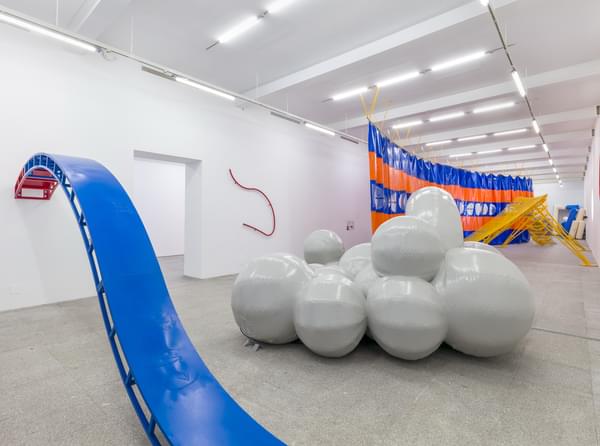 Photo: Laia Estruch / Jonás BelMarch 2025
Photo: Laia Estruch / Jonás BelMarch 2025
Hello Everyone from the Reina SofíaMarch 2025: Hello Everyone from the Reina Sofía
Curated by Latitudes, “Hello Everyone”—Laia Estruch’s largest exhibition to date—transforms the Museo Reina Sofía, in Madrid, into a resonant space for voice and sculptural presence. Across 27 works spanning more than a decade, Estruch shows how she has developed a performance language that is both physical and sonic, sculpting space with, and for, the force of vocalisation. Speakers placed throughout the exhibition weave together an audio collage of past performances: whispers, shouts, sung phrases, guttural vibratos. Metal slides, inflatable forms, and textile structures become architectures for the body and voice to inhabit, amplifying an artistic practice that once met skepticism but now commands the galleries of Spain’s foremost contemporary art museum—a testament to Estruch’s persistence and artistic conviction. What began as both a pop experiment and an attempt to unearth the sometimes strange voices within us all has since solidified into one of the most distinctive practices in contemporary performance art.
We dedicate this exhibition to the memory of Richard Flood, an extraordinary curator and mentor who passed away just a few days before the opening. Richard once said: ‘We only have so much time to put things in front of the public, and we better have a good reason why we’re using our coworkers’ time and why we think it’s going to mean something to the public.’ “Hello Everyone” responds to that challenge—to offer a clear reason to stop, listen, and experience. This exhibition is not just a culmination of Laia’s trajectory to date; it asserts, with the clarity Flood championed, why her work and her voice merit this space and this moment. Curating “Hello Everyone” has been a rewarding journey, and we are deeply grateful—to Laia, for five years of dialogue and trust; to the Museo Reina Sofía, for embracing this project; and to everyone who helped bring this beautifully audacious archive-warehouse of an exhibition to life.
“Laia Estruch. Hello Everyone” is on view on the fourth floor of the Museum’s Sabatini building, until 1 September 2025. -
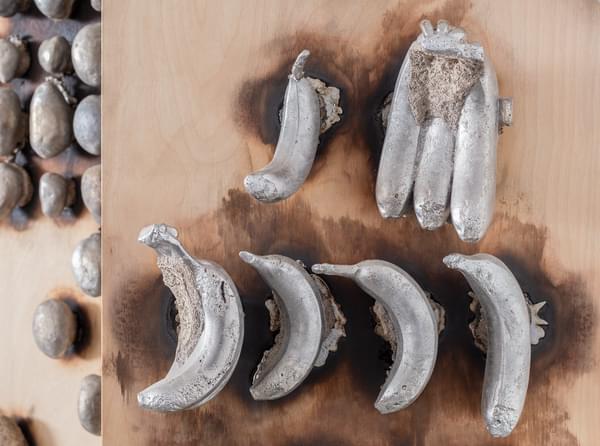 Photo: Jorge Satorre / Ander SagastiberriFebruary 2025
Photo: Jorge Satorre / Ander SagastiberriFebruary 2025
Bananas, Potatoes, Ria, Río: Jorge Satorre at CA2MFebruary 2025: Bananas, Potatoes, Ria, Río: Jorge Satorre at CA2M
Jorge Satorre’s “Triplay” (2025) serves as the entrance to his exhibition “Ria”, currently on view at the Museo Centro de Arte Dos de Mayo (CA2M), curated by Latitudes. Two large wooden doors, embedded with metal casts of bananas and potatoes, form this threshold. Everyday objects are laden with both mundane associations and personal significance.
As artist Sean Lynch observes in “Río” (River), the accompanying publication that surveys 15 years of Satorre’s work (coedited by the museum and Caniche Editorial) Jorge’s interest in these particular foodstuffs “ranges from the straightforward simplicity of the day and stomach — a banana for breakfast and potatoes as part of your evening meal. It also exists more profoundly in his grandfather’s war diaries. In 1939, he walked north after the Spanish Civil War was lost, eventually ending up in a concentration camp at Argelès-sur-Mer. He then managed to escape in a potato truck and met his brother in Paris, where the first thing he asked for upon arrival was to eat a banana, before going into exile in Mexico.”
In “Triplay”, all these possible meanings are cast in aluminium, chosen for its lightness and low melting point. Reimagined as door handles, the bananas and potatoes invite our grasp, yet some are positioned too high, too low, or too near the hinges to be wholly useful, lending an awkwardness and a certain redundancy to the act of opening the door. The seemingly simple act of passing through a threshold becomes an idiosyncratically linked to human upheaval, material perishability, and enduring resilience.
“Ria” is Spain’s first institutional solo exhibition dedicated to Jorge Satorre, and is on view until August 31, 2025. -
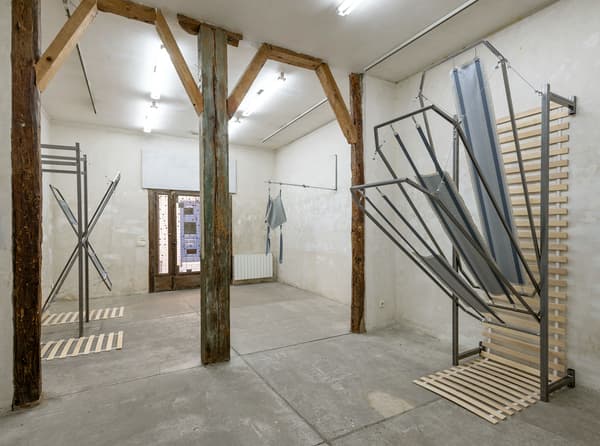 Photo: FormatoComodoJanuary 2025
Photo: FormatoComodoJanuary 2025
Folded FormsJanuary 2025: Folded Forms
Reviewed by Max Andrews of Latitudes in the December 2024 issue of Artforum magazine, Karlos Martínez Bordoy’s recent exhibition “Folded Forms” at Galería FormatoComodo in Madrid offered a concise and ingenious exploration of the century-old Murphy bed concept. This fold-down bed, hinged at one end to fold against the wall and save floor space, has long served as a cinematic shorthand for cramped quarters or a cartoonish comedic prop. Martínez reimagined this curious object across a quarter of works, expanding its metaphorical potential to examine the negotiation of personal space and the layering of concealed desires.
“Martínez’s exacting choice of hardware and soft materials offered a correspondingly precise set of allusions. For example, the coarse fabric bands that braced the textile panels were of such a specific blue-gray tone and texture that they immediately brought to mind the straps of some vintage navy-issue duffel bag, while the gently curved birchwood bed slats suggested sober IKEA furniture. The coded sculptural imaginary was somehow part midcentury flophouse, part contemporary tourist-rental micro apartment—both symptoms of an economic squeeze and versions of vaguely seedy urban malaise.” Continue reading here. -
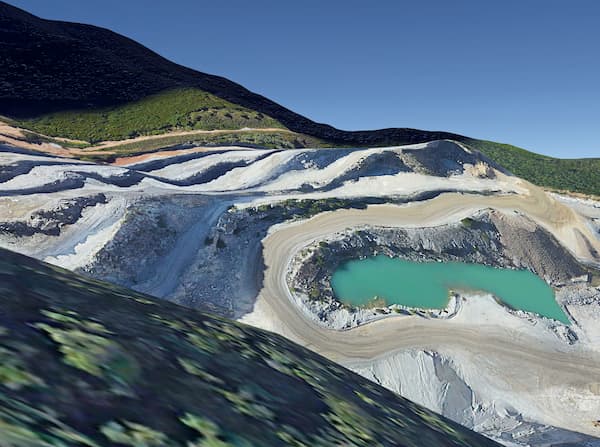 Photo: Marina Olivares and MC LoveDecember 2024
Photo: Marina Olivares and MC LoveDecember 2024
On the (Critical, Contextual) RocksDecember 2024: On the (Critical, Contextual) Rocks
Last month, Latitudes facilitated three sessions for the new Master’s Degree in Critical Contextual Design at Elisava, directed by Cristina Goberna Pesudo. These sessions were part of a class titled “Environments: What Extraction? What Nature?” conceived by artist Lara Almarcegui, a long-time collaborator and friend. Each student developed a research project at the intersection of architecture, art, design, and spatial practice, responding to local sites of resource extraction near Barcelona, including the Montjuïc quarries and the Sant Adrià de Besòs Incinerator.
Marina Olivares and MC Love titled their project “On the Rocks.” It explored the intersection of historical and contemporary extraction practices near La Llagosta by juxtaposing the granite aggregate quarrying operations of Canteras Canro with their discovery of the Pou de Glaç de Can Donadeu, a centuries-old ice well in the same vicinity. Unable to gain direct access to the quarry due to its heightened security, their investigation pivoted to satellite imagery via Google Earth and outreach to La Xopera, a local ecological group advocating for the ice well’s preservation amidst the quarry’s encroachment.
Their project reckoned with the explosive ecological impact of quarrying, which reshapes the landscape in dual ways—through the physical removal of material and its repurposing into urban infrastructure. It also interrogated satellite technology as another form of extraction and terrain distortion. Drawing on fieldwork, interviews, speculative renderings, and the largely forgotten history of pre-industrial ice production, the project culminated in a video essay. This work contrasted the destructive immediacy of modern extraction with the ingenuity and sustainability of the practices embodied by the ice well.
Projects like “On the Rocks”, alongside the other students’ equally ambitious inquiries, open new space for a softening of the often-rigid disciplinary boundaries in education and point to the potential of contextual design as a framework for novel forms of practice. We’re curious to see how this Masters evolves. -
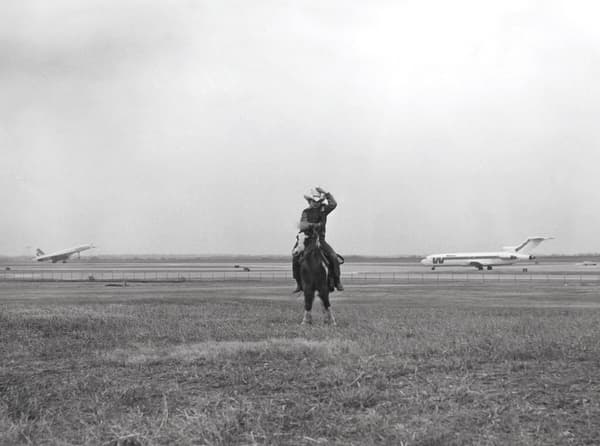 Author and subject unknownNovember 2024
Author and subject unknownNovember 2024
Terminal Velocity: Robert Smithson, Concorde, and Aerial ArtNovember 2024: Terminal Velocity: Robert Smithson, Concorde, and Aerial Art
This month’s Cover Story features an extraordinary photograph taken on 20 September 1973, during the inauguration of Dallas-Fort Worth Regional Airport. In just a few decades, this site evolved from prairie and ranchland to become the world’s second-busiest airport. Though the identities of the photographer and the young cowboy in the image remain unknown, the iconic delta-winged airplane on the left is unmistakable: this was Concorde’s first visit to the U.S. on a promotional journey prior to the start of scheduled passenger flights in 1976. Arriving from Caracas and departing for Washington Dulles, the supersonic crystalline jet symbolized the futuristic height of jet-set speed, glamour, and exclusivity, two decades before budget airlines made air travel almost mundane. Meanwhile the opening of Dallas-Fort Worth itself, designed as a new breed of hub to accommodate large, long-range wide-body airliners like the Boeing 747, marked a transformative moment in airport scale and capacity.
Artist Robert Smithson’s prescient collaboration with one of the architectural teams behind Dallas-Fort Worth took place precisely at this conceptual crossroads of expansion in the meaning of flying. Eerily, Smithson’s untimely death in a light aircraft crash elsewhere in Texas had occurred exactly two months to the day before this Concorde photograph was captured.
Invited by the Holt/Smithson Foundation’s Scholarly Text Program, Max Andrews of Latitudes chose to write on Smithson’s 1969 essay “Aerial Art,” originally published in Studio International. In this text, Smithson outlined his earthwork proposals for the airport site, alongside works proposed by Carl Andre, Robert Morris, and Sol LeWitt. Max’s essay delves into this historical moment, tracing the allied rise of air travel and global art networks while highlighting the multi-decade surge in carbon emissions from flying and its significant impact on the climate crisis.
The Scholarly Text Program regularly commissions essays focused on individual artworks by Nancy Holt and Robert Smithson, exploring the continued relevance of their ideas across contemporary artistic and cultural production—from geology and ecology to poetry and beyond. Also available is Mariana Cánepa Luna’s recently published essay on Nancy Holt’s site-responsive installation “Ventilation System”, commissioned for this same program. -
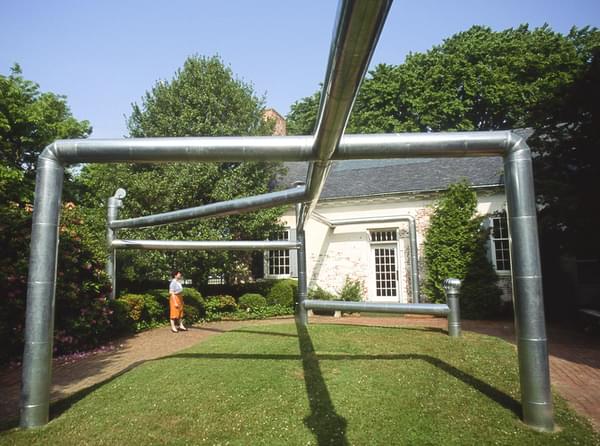 Photo: Nancy Holt, “Ventilation IV: Hampton Air”, 1992. Guild Hall Museum, East Hampton, New York. © Holt/Smithson Foundation / Licensed by Artists Rights Society, New York.October 2024
Photo: Nancy Holt, “Ventilation IV: Hampton Air”, 1992. Guild Hall Museum, East Hampton, New York. © Holt/Smithson Foundation / Licensed by Artists Rights Society, New York.October 2024
Nancy Holt’s “Ventilation System”October 2024: Nancy Holt’s “Ventilation System”
Mariana Cánepa Luna of Latitudes was commissioned to write an essay on a work by American artist Nancy Holt (1938–2014) for the Holt/Smithson Foundation’s Scholarly Text Program. Mariana focused on Holt’s “Ventilation System” (1985–92), a site-responsive installation that celebrates air-conditioning infrastructures and draws attention to their ubiquitous, though often overlooked, presence in modern life. While such building components are typically concealed, Holt’s work ostentatiously showcases industrial ducts and fans, blending functionality with wry playfulness. This installation, part of her “System Works”, critiques humanity's dependency on technological infrastructures and subtly raises ecological concerns around energy use. It reflects Holt’s interest in connecting human experience to larger natural systems, akin to her most famous work, “Sun Tunnels” (1973–76).
In today's context, “Ventilation System” resonates with a heightened awareness of sustainability. Recent art works, like Nick Raffel’s “fan (Wesleyan)” (2022) and “wind dial (Pied-à-Terre)” (2021), further explore air circulation in buildings, emphasizing efficiency and environmental literacy. Ghislaine Leung’s “Violets 2” (2018) explores related themes, using repurposed ventilation pipes to reflect on institutional conditions and artistic labour. As climate concerns grow, Holt’s pioneering work, which Mariana discusses alongside these newer approaches, encourages practical and symbolic shifts in institutional practices, advocating for more robust ecological stewardship in the art world.
The Scholarly Text Program invites diverse writers to contribute essays on single works by Nancy Holt and/or Robert Smithson, examining topics from geology and ecology to art and philosophy. Stay tuned for Max Andrews’ upcoming contribution on Smithson’s article “Aerial Art” (1969) next month. -
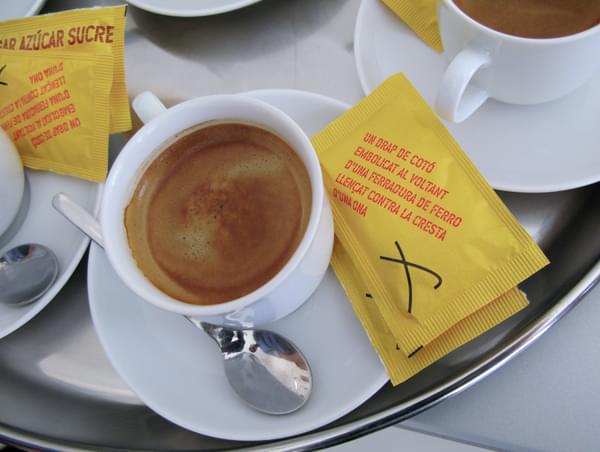 Photo: LatitudesSeptember 2024
Photo: LatitudesSeptember 2024
The Crest of a WaveSeptember 2024: The Crest of a Wave
Sixteen years ago, the start of the new art season was given a sugar rush when 300,000 special sugar sachets mysteriously appeared in over 70 of Barcelona’s beloved bars, cafés, and restaurants. Printed on each of these sachets was a bold typographic statement: “A CLOTH OF COTTON WRAPPED AROUND A HORSESHOE OF IRON TOSSED UPON THE CREST OF A WAVE”, along with a diagrammatic emblem of a throw’s trajectory.
Weeks later, this ephemeral and distributed sculpture by artist Lawrence Weiner (1942–2021) was emblazoned across a five-metre-high wall in the patio of the Fundació Suñol—in Catalan, Spanish, and English. Inside the Nivell Zero space, visitors could hear the same words transformed into a catchy track by Ned Sublette and The Persuasions.
Weiner’s project “THE CREST OF A WAVE” reimagined what public sculpture could be, unfolding in four distinct components: the sugary ephemeral sculpture, the wall installation, the sound piece, as well as a live action. Each part encouraged audiences to dive into Spain’s mercantile and maritime past, weaving together stories of trade, commercial power, and the biography of materials.
The project’s live action occurred by the waterfront in early October, when an iron horseshoe wrapped in a cotton cloth was ceremoniously tossed onto the crest of a wave.
This year, a little sugar and caffeine boost might be exactly what is needed to tackle the new exhibition season ahead, which begins with the 15th edition of Manifesta in Barcelona and surrounding cities, followed by the explosion of Art & Gallery Weeks & Weekends in Madrid, Barcelona, Valencia, Palma and beyond. -
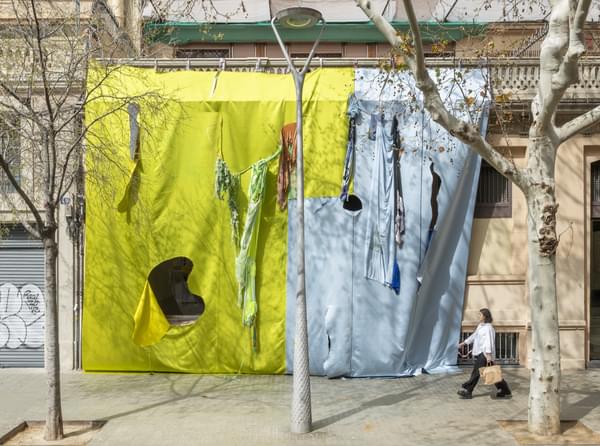 Photo: Lysiane GauthierJuly–August 2024
Photo: Lysiane GauthierJuly–August 2024
Rosa Tharrats—Curtain CallJuly–August 2024: Rosa Tharrats—Curtain Call
Summer is here and the Cover Story for July and August features Rosa Tharrats’ “AVOC IVIDRAM” (2024), a work that veiled the exterior of Bombon Projects during the opening of her exhibition “Refugia” earlier this year. This show is the focus of Max Andrews’s first contribution to Artforum magazine, appearing in the summer issue.
“A ‘thongdrel’ is a monumental appliquéd cloth that Tibetan Buddhist monks unfurl for just a few hours each year for collective contemplation and spiritual cleansing”, Max writes. “Although it transpired in an unmistakably less serene setting than a monastery—Bombon Projects faces a busy road—the opening night of Rosa Tharrats’s exhibition intentionally appealed to comparisons with such sacred displays. A huge chartreuse-and-blue drape shrouded the gallery facade, adorned with bustles of fabric and cut with peekaboo perforations. A slit in ‘AVOC IVIDRAM’ gave access to the show inside, and at the end of the evening the cloth was unhitched and dropped to the ground, whereupon the remaining crowd folded it away. Not so much a curtain-raiser as a disarming curtain-lowerer, the ritual was evidence of Tharrats’s attentiveness to Buddhist traditions as well as of her showmanship and her understanding of textiles—she also works as a costume designer for film and theater.”
Rosa was one of seventeen artists and artist duos featured in the exhibition “Panorama 21: Notes for an Eye Fire”, curated by Hiuwai Chu and Latitudes, which opened at the Museu d’Art Contemporani de Barcelona (MACBA) in October 2021. She presented a new textile sculpture in the passageway overlooking the atrium, with layers of woven and printed cloth protruding from the museum's columns like ragged sails on a ship’s masts.
This autumn, Rosa will be presenting a project with Gabriel Ventura as part of Manifesta 15’s program in Barcelona and surrounding cities. The biennial is scheduled to open on September 8. -
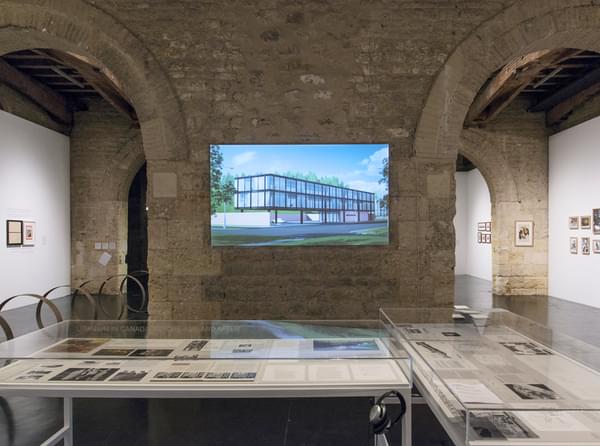 Photo: Lysiane GauthierJune 2024
Photo: Lysiane GauthierJune 2024
Terence Gower—Diplomacy, Urbanism, UraniumJune 2024: Terence Gower—Diplomacy, Urbanism, Uranium
Last month, The Power Plant in Toronto opened Terence Gower’s “Embassy”, an exhibition showcasing over a decade of work exploring the diplomatic architecture of American embassy buildings in Baghdad, Havana, and Saigon, as well as an unbuilt project for Ottawa.
In 2012, Terence was one of five artists to participate in the inaugural iteration of Latitudes’ guided-tour project, “Incidents of Travel”, in Mexico City. His project, “Urban Models (Zacatenco to Tlalnepantla)”, visited several sites of universalist urbanism in the northern parts of the city, including the 1963 campus of the Instituto Politécnico Nacional and a low-density suburban-style housing development.
As featured in this month’s Cover Story, in 2017, Terence exhibited his project “Public Spirit” (2008) in the Latitudes-curated exhibition “4.543 billion. The matter of matter” at CAPC musée d’art contemporain de Bordeaux. This installation, consisting of two display cases with facsimiles and documents, and a fictional promotional video titled “Wilderness Utopia”, is now part of the National Gallery of Canada’s collection, along with two aluminium sculptures. “Public Spirit” narrates the story of the interplay between uranium and urbanism, money, and modern art in 1950s Canada. Latvian-born mineral prospector Joseph H. Hirshhorn used his uranium mining fortune to amass one of the world’s largest private art collections, which later became the foundation of the Hirshhorn Museum and Sculpture Garden, established in 1974 on the National Mall in Washington, D.C. Long before the Washington museum was founded, Hirshhorn envisioned a utopian community in Ontario that would integrate a permanent home for his art collection with his new uranium mine, its offices, and worker housing. In 1955, Hirshhorn hired the architect Philip Johnson to develop plans, but the project never materialised.
“Embassy”, curated by Adelina Vlas and Frances Loeffler, is on show at The Power Plant until 11 August 2024. -
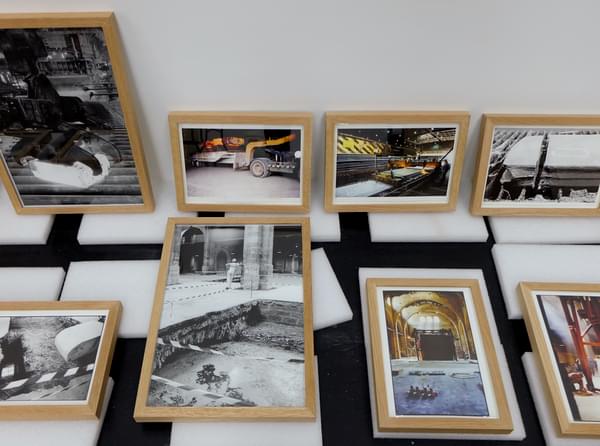 Photo: LatitudesMay 2024
Photo: LatitudesMay 2024
Richard Serra & Anne Garde—Threats of ParadiseMay 2024: Richard Serra & Anne Garde—Threats of Paradise
Marking the death last month of American sculptor Richard Serra, this month’s Cover Story looks back to the Latitudes-curated exhibition “4.543 billion. The matter of matter” at CAPC musée d’art contemporain de Bordeaux. Serra’s name did not appear on the list of artists. Yet the raw geophysicality of the processes involved in producing and installing his work “Threats of Hell” (1990) in the cavernous CAPC nave was the protagonist of an extraordinary suite of documentary images by Anne Garde. Seen here during the exhibition setup, the selection of Garde’s works—previously categorised as press photos—showed neither Serra nor his finished sculpture, which comprised three steel slabs, each weighing 43 tonnes. Instead, the focus lay on the material transformations demanded by the fabrication of the metal pieces and the quasi-archaeological proceedings involved in siting them.
Garde journeyed to Dillingen, Germany, to see massive molten lumps of metal being formed into the three huge slabs of weatherproof steel at Dillinger Hütte, a steelworks with unusually large heavy-plate rolling mills. In Bordeaux, her lens captured the excavation of the museum floor to establish foundations for “Threats of Hell”, revealing the water table of the underlying subsoil. The concept behind the “4.543 billion” exhibition stemmed from the CAPC building’s former life as a warehouse for colonial commodities, its limestone walls once buried deep in the ground, its wooden beams once part of a forest. And Garde’s camera-eye, whether witnessing the pouring of concrete or the assembly of hoists, imagined primeval scenes of ecological upheaval in the museum that evoked a geological, rather than art-historical, understanding of time. Curiously enough, the slabs were later reconfigured for a private collection. The title was deemed too ominous. Now presently installed in a garden on the banks of the Garonne river, the work was rechristened “Hopes of Paradise”. -
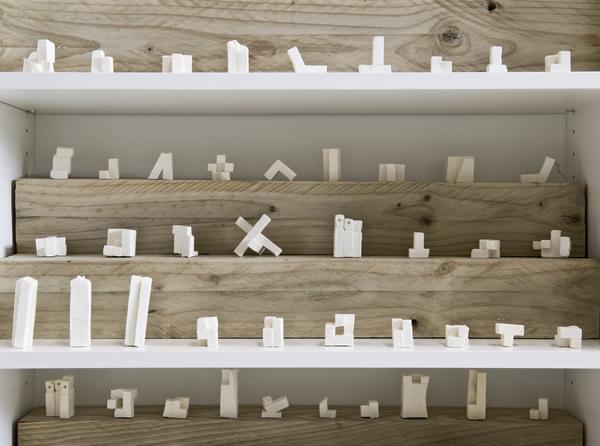 Photo: Roberto RuizApril 2024
Photo: Roberto RuizApril 2024
In Progress: Iratxe Jaio & Klaas van GorkumApril 2024: In Progress: Iratxe Jaio & Klaas van Gorkum
On the occasion of their participation in Ten Thousand Suns, the 24th edition of the Biennale of Sydney, April’s Cover Story spotlights Iratxe Jaio & Klaas van Gorkum, and The Margins of the Factory, the exhibition of the duo’s work that Latitudes curated in 2014.
At ADN Platform, one of two projects showcased was Work in Progress (2013), which delved into the manufacturing industry of Markina-Xemein, Iratxe’s rural Basque hometown. A video documented the mass production of rubber car parts, tracing the journey from the assembly line of a worker-owned factory to makeshift workspaces where informal workers, including women from Moldova, Peru, and Senegal, finished pieces by hand.
The artists employed several of these workers to cast hundreds of replicas of small modernist sculptures. These replicas were then displayed on mass-produced shelving, aiming to evoke the Laboratorio de tizas (Chalk Laboratory) (c. 1972–74) by Jorge Oteiza, the Basque sculptor known for his strong criticism of the commodification of art.
“We have a long-standing interest in the image of ‘work’, and in the relation between art and labour”, the artists explained in a 2013 Frieze interview with Latitudes’ Max Andrews. And turning Oteiza’s experimental sculpture laboratory into a contemporary production line “allowed us to stage an image of the artist at work, and to superimpose it onto that of the wage-worker, ultimately presenting both as ideologically loaded social constructions.”
In 2018 Work in Progress was acquired by the collection of Artium Museoa, the Museum of Contemporary Art of the Basque Country.
In Sydney, Iratxe & Klaas are showing a new rendition of False Flag (2021), their series of sculptures that draw inspiration from René Magritte’s surrealist warplanes of 1937 and the legacy of the Guernica bombardment. The Biennale runs until 10 June 2024. -
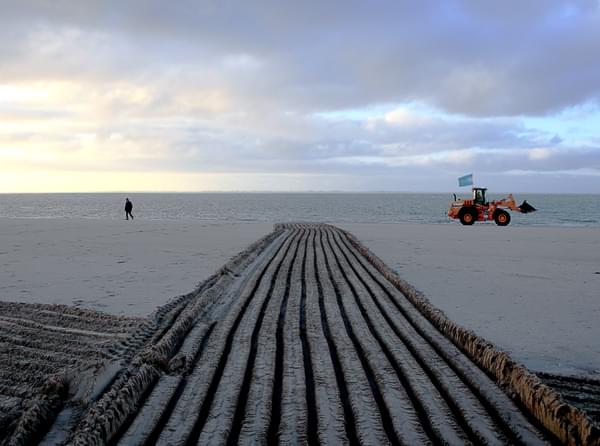 Photo: Paloma Polo / SKORMarch 2024
Photo: Paloma Polo / SKORMarch 2024
Dibbets in PalenciaMarch 2024: Dibbets in Palencia
On the morning of 8 February 2009 it was still pitch dark when we arrived with cameraman Fijko van Leeuwen on a wide stretch of the beach near the extremity of the port of Rotterdam. The tide tables had decided the day. As the freezing sky gradually lightened, a line of lights out to sea revealed itself as a queue of mighty ships waiting to unload goods and raw materials brought from all around the world. Meanwhile, we awaited a bulldozer, a hydraulic platform, our fellow co-curator Theo Tegelaers, and an artist whose work has been associated with the Land art and Conceptual art movements since the 1960s – Jan Dibbets. Thus Latitudes’ project Portscapes commenced in earnest, and that morning saw the realisation of Dibbets’s 6 Hours Tide Object with Correction of Perspective, a 2009 realisation of a work the artist had first made forty years earlier, almost to the day. Just after midday, both the shape drawn by the bulldozer as the tide rose and the gaggle of visitors who had come to witness the filming had vanished. We drove back together into a snowy Rotterdam for bowls of warming soup.
One foot in the past, in the form of an echo of one of the seminal moments of Land art, strode into presentness of experience and, moreover, the imagination of the future – the beach where we had stood that chilly morning would soon no longer exist, effectively “correcting” the Dutch coastline forever, as Tegelaers explained. With the construction of 2,000 hectares of new land in the North Sea, a project known as Maasvlakte 2, it would be swallowed up by the extension of what was already the largest seaport and industrial area in Europe.
Between March 21 and April 17, 2024, Dibbets’ 6 Hours Tide Object... will be screened at the Fundación Díaz-Caneja, a contemporary art museum in Palencia dedicated to landscape, the environment and rurality.
The 8 minute-long film was premiered at the FutureLand Information Centre of the Port of Rotterdam in June 2009 and during Latitudes’ participation in the New York festival No Soul For Sale – A Festival of Independents (24–28 June 2009). Portscapes was produced by the Port of Rotterdam Authority in collaboration with the sadly now-defunct internationally operating Dutch cultural organisation SKOR | Foundation Art and Public Space (1999–2012). -
GCC Spain. Sources: GCC Carbon Calculator, Rail Europe, Skyscanner.February 2024
Climate Conscious Travel to ARCOmadridFebruary 2024: Climate Conscious Travel to ARCOmadrid
As part of its wider Climate Conscious Travel campaign, Gallery Climate Coalition and its International Volunteer Team, GCC Spain, are collaborating with ARCOmadrid on the initiative #TrainToARCOmadrid to encourage more climate conscious travel choices when travelling to the art fair, which this year runs from 6–10 March 2024. The data collected through GCC’s carbon calculator shows that air travel is typically one of the biggest contributors to most galleries’ footprints. Stepping on a plane is the single most carbon-polluting action we take as individuals in our everyday lives. This month’s cover story shows infographics comparisons between flying and taking the train to Madrid from four of the top origin cities for visitors to the fair (Barcelona, Valencia, Paris, and London). Refresh the page and you can see how much difference it makes for each journey.
The visual arts have a unique influence on public discourse, but the sector is excessively carbon and waste intensive in proportion to its economic size. A 2021 report estimated global art sector emissions at 70 million tonnes CO2e per year, equivalent to the annual emissions produced by the entire nation of Morocco.
Since 2023, Latitudes are Individual Active Members of GCC and it also sits on the Committee of GCC Spain. GCC’s primary goal is to facilitate a reduction of the sector’s CO2e emissions by a minimum of 50% by 2030, as well as promoting zero waste practices. It develops and shares best practice, provides leadership on sector specific environmental issues, and works to leverage the collective power of its membership to achieve systemic changes. -
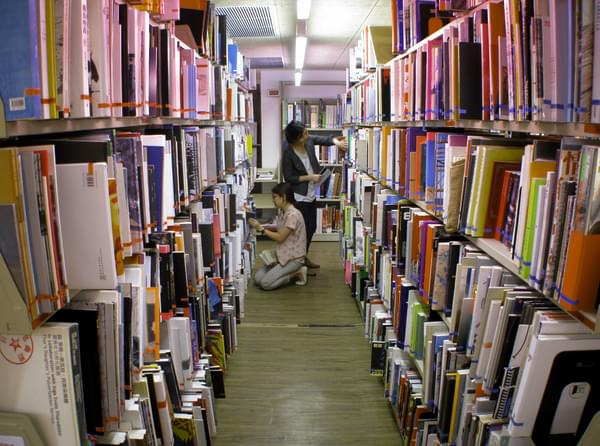 Photo: LatitudesJanuary 2024
Photo: LatitudesJanuary 2024
Curating Lab 2014–Curatorial IntensiveJanuary 2024: Curating Lab 2014–Curatorial Intensive
As we start 2024, for one reason or another we find ourselves pausing to reminisce about Curating Lab 2014–Curatorial Intensive, which took place in June 2014, and which was organised by NUS Museum, Singapore, with support from the National Arts Council of Singapore. This year marks a decade since artist, curator, and wordsmith Heman Chong joined forces with Latitudes to spearhead what was a highly rewarding ten-day experience.
Back in 2014, eleven recent graduates embarked on an exploration of curating through a dynamic blend of lectures, workshops, and tutorials. Together we pondered the evolving landscape of contemporary art and curatorial practices, with a keen focus on exhibitions as living entities—sites of knowledge production that breathe with intention, subtlety, and participation. Following a busy initial week of exploration in Singapore, a field trip to Hong Kong awaited. From the vibrant Spring Workshop, to the shelves of Asia Art Archive (seen here), and the site of what is now M+, the trip not only anchored curatorial processes within the region, but broadened all of our horizons. Here’s to more of that in 2024! -
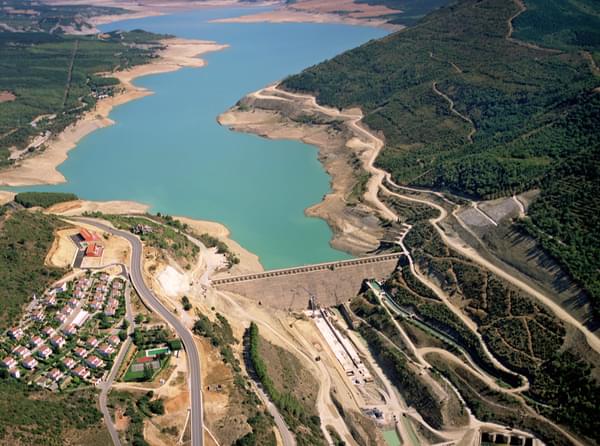 Photo: Ibon AranberriDecember 2023
Photo: Ibon AranberriDecember 2023
Ibon Aranberri, Partial ViewDecember 2023: Ibon Aranberri, Partial View
This month’s Cover Story, the 100th no less, focusses on artist Ibon Aranberri, whose anthology exhibition Vista partial (Partial View) has recently opened at the Museo Nacional Centro de Arte Reina Sofía in Madrid, and with whom Latitudes has been able to collaborate on several occasions.
This image is one of the 98 aerial photographs comprising Política hidráulica (Hydraulic Politics), 2004–10, a project showcased at Documenta 12 in 2007. Each photograph records one of the massive infrastructure projects realised in Spain in the 1950s and 1960s—reservoirs, hydroelectric power plants, dams—as part of the national hydrological plan of public works leveraged by the Franco dictatorship. The policy involved the flooding of numerous valleys and areas of outstanding natural beauty. The photographs, printed in various sizes and framed in distinct styles, are placed directly on the gallery floor. Stacked, overlapped, and leant against each other, they seem like a catastrophic hoard.
In 2007, Latitudes guest-edited a special issue of UOVO titled “Ecology, Luxury & Degradation” and invited curator Peio Aguirre to interview Ibon. The insightful result was titled “Cognitive Maps” and it can be read here.
The following year, Latitudes included Ibon in the exhibition Greenwashing. Environment: Perils, Promises and Perplexities at the Fondazione Sandretto Re Rebaudengo, Turin, featuring the slide work Luz de Lemóniz (Light over Lemóniz) 2000–2004. The piece is now part of the Madrid show in an extended installation with accompanying architectural maquettes. Luz de Lemóniz centres on the construction of a nuclear power plant on the Basque coast, which began in 1972 with the Franco government on its last legs. The plan faced severe opposition, was protested by activists, residents, and the artistic community, and was eventually cancelled. The 80 slides obliquely relate this story of political and ecological upheaval through maps, graphics, shots of the terrain surrounding the aborted power plant, and plans for a firework display that was, appropriately enough, also cancelled.
Also in 2008, Ibon’s work was featured in the film and video programme Latitudes curated for the Museo Tamayo Arte Contemporáneo, Mexico City—A Stake in the Mud, A Hole in the Reel: Land Art's Expanded Field, 1968–2008—and which later toured to seven venues in Europe. Zuloa (Ir.T. no513), 2004, focuses on a wintry pilgrimage to a site of an apparently brutalist intervention—a cave mouth that, following extensive fieldwork and negotiation, Ibon had arranged to be blocked with an imposing black steel closure, leaving only a circular hole for bats. The steel door was removed in 2019, and now forms a part of Vista partial.
Surveying Aranberri’s work since the mid-1990s, the Reina Sofía show, organised in collaboration with Artium Museoa, serves as a toolbox of Ibon’s works and their fragments, appendices, and traces. It is remarkable not only for its examination of the ideology of landscape, heritage, and engineering, but in how his past projects are displayed in a state of continuous reappraisal and interrelation. The exhibition continues in Madrid until 11 March 2024, before it tours to Artium, where it opens at the end of April. -
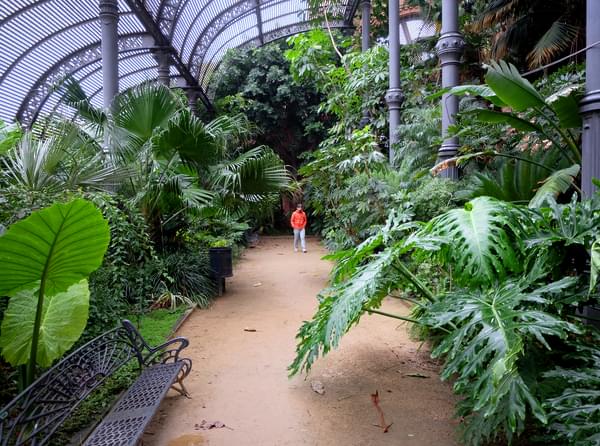 Photo: LatitudesNovember 2023
Photo: LatitudesNovember 2023
Surucuá, Teque-teque, Arara: Daniel Steegmann MangranéNovember 2023: Surucuá, Teque-teque, Arara: Daniel Steegmann Mangrané
Daniel Steegmann Mangrané’s exhibition Una fulla al lloc de l’ull (A Leaf Shapes the Eye) opens later this month at Museu d’Art Contemporani de Barcelona (MACBA). Curated by Hiuwai Chu and João Laia, the show includes works from the late 1990s to the present. Daniel’s practice hinges on the natural and the geometric, as if splicing together the unfathomable forests found in Brazil (where he lived for the last fifteen years) with the clear lines of abstraction and man-made order. His works have incorporated chromatic watercolour studies, kaleidoscopic collages, photography, sculptures with etched leaves and citrus fruit, as well as film and sound projects that conjure a kind of organic cinema.
In January 2020, Daniel and Catalina Lozano explored Rio de Janeiro for the tenth episode of ‘Incidents (of Travel)’, a Kadist-produced, Latitudes-curated online project. His tour was designed to “stroll around the natural wonders of the city, its colonial past, imperial Brazil … and end on the beach.”
This month’s Cover Story looks back to 2015, when Latitudes curated Compositions a series of five city-wide site-specific interventions on the occasion of the first Barcelona Gallery Weekend. Daniel presented a new version of Surucuá, Teque-teque, Arara (2012) amongst the subtropical plants of the Umbracle (Shade House) in Barcelona’s Parc de la Ciutadella. The work was an acoustic installation formed by eight audio tracks that were recorded simultaneously along a 60 metre transect through a remnant section of the Mata Atlântica, the Atlantic Rainforest of Brazil. Such dense tropical forest would have been the first habitat Portuguese colonists encountered on their arrival in the year 1500. It is an ecosystem known for its extraordinary biological richness and high degree of endemism, meaning many species exist nowhere else.
In Barcelona, an eleven-minute loop of the sounds of the forest, including the disembodied calls of colourful birds such as the Surucua trogon, the Yellow-lored tody-flycatcher, and macaws (species whose Portuguese names lend the work its title) merged with the ambient sounds of the city park. As if a 1:1 scale collage, the artifice of the urban botanical collection became magically intertwined with an acoustic slice of the authentically wild. -
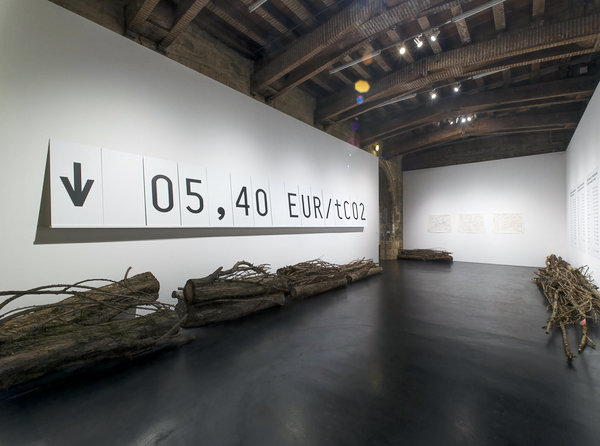 Photo: Lysiane GauthierOctober 2023
Photo: Lysiane GauthierOctober 2023
A Tree Felled, A Tree Cut in 7October 2023: A Tree Felled, A Tree Cut in 7
What is the value of a single tree? How can it be measured? Following the initial shock at the news of the deliberate felling of the Sycamore Gap tree on 28 September 2023, a sense of reflective grief brought to mind such questions. This lone sycamore had stood for more than two centuries within a dramatic dip along Hadrian’s Wall in Northumberland, England, and became one of the most iconic trees in the world. Its loss could doubtless be calculated in terms of the resultant decline in local biodiversity, or the cutting short of its environmental capacity to absorb carbon dioxide. Yet it is obvious that its violent demise represents a profound cultural and historical toll as well; it also sequestered far more intangible and unfathomable principles and emotions.
Latitudes’ exhibitions have often been drawn to trees. One could mention the photographs of Sergio Vega in Greenwashing. Environment: Perils, Promises and Perplexities, or A quatre potes, the project of nyamnyam & Pedro Pineda in Panorama 21. Notes for an Eye Fire. Yet Pep Vidal’s 19 metre tree cut in 7 equal volumes (2015), included in 4.543 billion. The Matter of Matter most clearly speaks to how a tree can express contrasting notions of value and measurability. This month’s Cover Story is a view of one gallery of this exhibition and shows Pep’s work alongside other contributions, including Amy Balkin’s Today’s CO2 Spot Price (2009), which charted the daily market price of carbon dioxide.
The story of 19 metre tree… began when poplar tree was cut down on the property of a friend of the artist near Lleida, Catalunya, as it was at risk of falling onto the house. Surprised by the sheer mass and intricacy of the tree’s forms, Pep decided to develop a more reasoned way to perceive it – by ‘knowing’ it as rigorously as possible from a do-it-yourself empirical perspective. During six days, Pep and a colleague calculated the volume of every branch of the tree using measuring tapes and callipers, accepting an allowable 3% error. This information was fed into software to create a 3D model of the tree that was used to determine the position of six cuts that divided its bulk into precisely equal volumes.
This somewhat absurd exercise addresses the paradox that the practices of standardisation, quantification and mathematisation that have given rise to extraordinary value and knowledge over the last centuries, also represent the advance of a perspective that has allowed the commodification and management of nature. Pep’s wooden sculpture exhibited the results of applying classical geometry to nevertheless try to compute something largely immeasurable and unexplainable. His analysis of an otherwise unremarkable tree ended up confronting the plant’s utter uniqueness. -
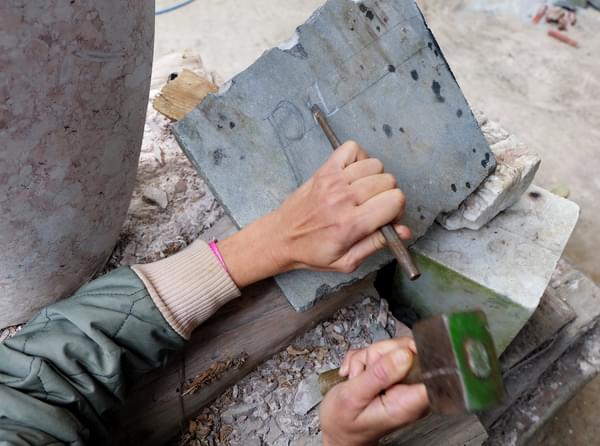 Photo: LatitudesSeptember 2023
Photo: LatitudesSeptember 2023
The Pilgrim in IrelandSeptember 2023: The Pilgrim in Ireland
During the last two weeks of August, we travelled to Ireland alongside the artist Eulàlia Rovira as part of the second chapter of the residency exchange project The Pilgrim. This venture has brought Latitudes together with Askeaton Contemporary Arts’ Michele Horrigan and Sean Lynch, as well as artists Ruth Clinton and Niamh Moriarty. Our collaborative exploration has been guided – haunted, perhaps, is a better word – by the tantalising tale of a Barcelona merchant laid to rest in 1784 within Askeaton’s Franciscan Friary. As our research has expanded it has led us to take diverse paths, including to the Spanish Armada shipwrecks near Sligo two centuries prior, the intriguing history of a transatlantic flying boat terminal on the Shannon Estuary in the 1930s, as well as explorations of megalithic passage tombs, Celtic stonework, medieval architecture, and a hydroelectric power station.
One of our notable stops was at Holy Cross Abbey, originally founded as a Cistercian monastery in 1168 and a revered site of pilgrimage since medieval times. Among its remarkable features is a reliquary said to hold a shard of the wooden cross on which Jesus Christ was crucified. Following the Cromwellian conquest of Ireland in the mid-17th century, the abbey fell into disrepair. However, in the 1970s, the local community rallied to restore it to its former splendour. One of the highlights of our visit was meeting Philip Quinn, a skilled stone carver and restorer who resides nearby with his wife Liz, a tour guide at the Abbey. Philip shared his expertise, pointing out the Abbey’s whispering arch, intricately carved owl, and the spot where a Sheela na gig motif had been hacked off. At his workshop, he demonstrated the art of carving simple letter forms in a piece of grey limestone. Handing the hammer and chisel to Eulàlia, with each gentle tap the word “P-i-l-g-r-i-m” slowly emerged from the rock. -
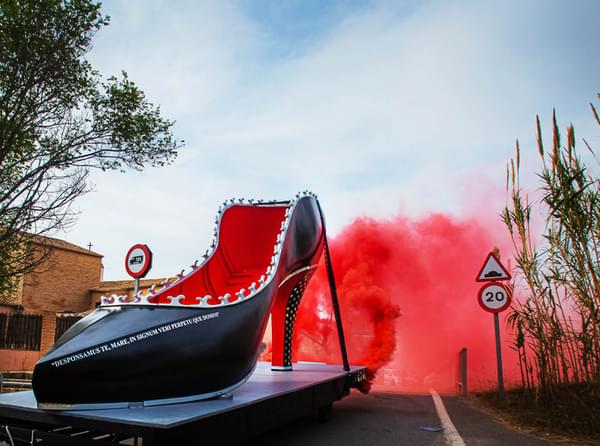 Miralda / Photo: Tania CastroJuly–August 2023
Miralda / Photo: Tania CastroJuly–August 2023
Honeymoon in ValenciaJuly–August 2023: Honeymoon in Valencia
In April this year the streets of Valencia witnessed a remarkable sight: a colossal high-heeled shoe, adorned in the fashion of a Venetian gondola, paraded its way to the Bombas Gens Centre d’Art. This spectacle harkened back to 1990 when Catalan artist Antoni Miralda crafted this unique stiletto as a gift for the Statue of Liberty, who, in an improbable union, was to be wedded to the Columbus Monument in Barcelona.
Now, the Bombas Gens exhibition “Honeymoon: Unclassified” revisits Miralda’s extravagant Honeymoon Project (1986–92), delving into its monumental metaphor of the make-believe societal wedding as an enigmatic celebration of exchange between the so-called old and new worlds.
As Latitudes’ Max Andrews expresses in his review of the exhibition, now accessible on frieze.com, the documentation of this project nostalgically evokes the taste of hope that characterized the early-1990s era of globalization and bilateralism. Yet, as we examine the project’s resurrection in 2023, the question arises: how should we interpret its significance today?
For an exploration of Latitudes’ comprehensive writings since 2005, encompassing additional exhibition reviews, artist profiles, catalogue essays, and opinion columns, check out the “Writing” section here. -
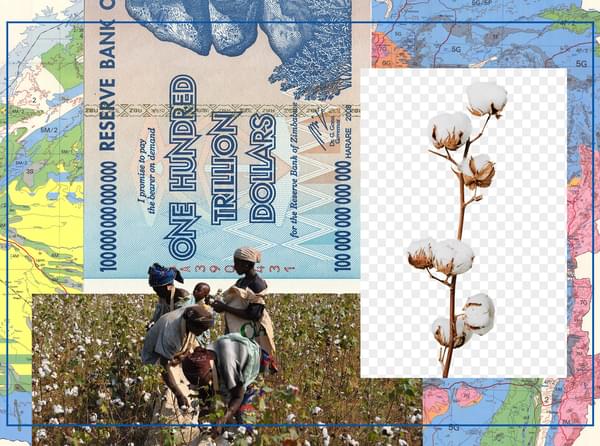 Crystal BennesJune 2023
Crystal BennesJune 2023
Crystal Bennes FuturesJune 2023: Crystal Bennes Futures
Earlier this year, Latitudes was commissioned to write a text on the work of the America-born Scotland-based artist, researcher, writer and educator Crystal Bennes for the latest edition of the Freelands Artist Programme. This month’s Cover Story is just a glimpse into her expansive work-in-progress around the financialisation of natural resources in anticipation of “Betwixt 2024”, the forthcoming Freelands’ publication out next year coinciding with the presentation of Crystal’s project, alongside 19 other artists from the programme, and an upcoming solo show of the new project at Talbot Rice Gallery, Edinburgh.
Involving tapestry, sculptural installation, video, and performance, Crystal’s project addresses the rapaciousness and sophistry of commodities trading. This arena deploys abstract financial instruments to bet on the future value of raw materials and natural resources including crude oil, metals, coffee, and – as featured here in a design study for a Jacquard weaving titled pecunia non olete (2023) – cotton. The Freelands Artist Programme supports and grows regional arts ecosystems in the UK by fostering long-term relationships and collaborations between emerging artists and arts organisations. Between 2022–24, Freelands is working with three organisations in addition to the Talbot Rice – g39 in Cardiff, PS2 in Belfast, and Site Gallery in Sheffield.
Crystal’s recent work has included an ongoing photographic exploration of an artificial island in Sweden created entirely out of radioactive waste from industrially-produced synthetic fertiliser and the experimental recreation of a nineteenth-century hay meadow based on a myth of unintentional plant migration from Italy to Denmark. The latter project opens at the Thorvaldsens Museum in Copenhagen on 16 June! -
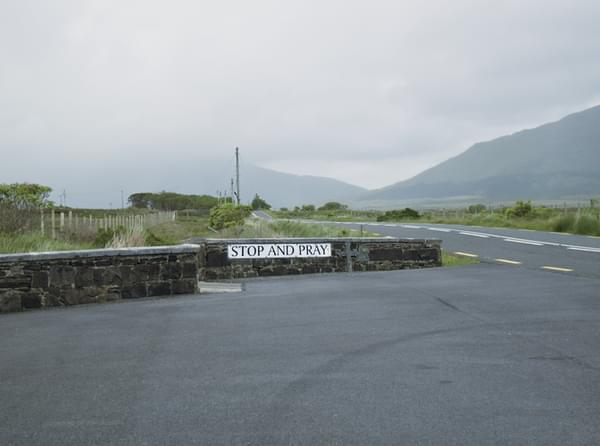 Ruth Clinton & Niamh MoriartyMay 2023
Ruth Clinton & Niamh MoriartyMay 2023
Ruth Clinton & Niamh Moriarty in BarcelonaMay 2023: Ruth Clinton & Niamh Moriarty in Barcelona
This month Latitudes welcomes artists Ruth Clinton & Niamh Moriarty to Barcelona as part of the pilot residency exchange project The Pilgrim. Ruth & Niamh will be talking about their work in Barcelona on 6 May, alongside project co-curators Michele Horrigan and Sean Lynch of Askeaton Contemporary Arts, in an event hosted at Eulàlia Rovira’s studio.
Ruth and Niamh’s recent work forms a kind of cautionary tale about the romantic myths surrounding their native Ireland, its landscape, identity, and adoption of American tropes of the frontier, while trying to catalyse possibilities for contemporary folklore. Their collaborative practice combines intricate storytelling with film and exhibition making, incorporating radio works, publications, performances, historical research and conspiracy theories to reflect on the contradictions of heritage marketing and environmental policies, the colonial relations of the past, and the protest movements of the present. This month’s cover story is a still from In a Contrary Place (2022) a film which adopts the form of an immram, a hero’s journey to an otherworld.
While the duo are in Catalonia they’ll be “tracing ideas of Pilgrimage; places that have been ‘touched by celebrity’ or an enduring, dramatic story; journeys of personal discovery (e.g. the popularity of home DNA tests and and how these reflect mounting unease around authenticity, origin and national identity), ideas of sanctuary through shared faith, and of course, fallen idols.” -
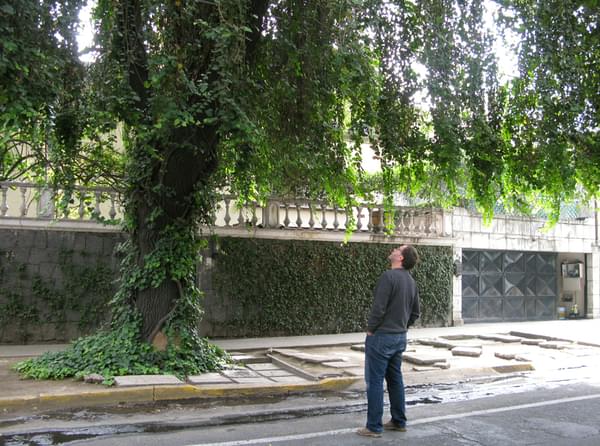 Photo: LatitudesApril 2023
Photo: LatitudesApril 2023
Jerónimo Hagerman (1967–2023)April 2023: Jerónimo Hagerman (1967–2023)
We are grateful to have crossed paths in life with the unique spirit that was the artist Jerónimo (Momo) Hagerman. Momo radiated love and affection to all the human and non-human beings that surrounded him. Taken on 24 September 2012, in this photo we see Momo gazing up at a special tree in the Polanco district of Mexico City that he took us to see as part of his day for Incidents of Travel.
As he wrote: “In 2003, Itala Schmelz commissioned me to create a piece for the façade of the Sala de Arte Público Siqueiros (SAPS), to expand the project of recovering it as a public space. As part of the research, I walked through the neighbouring streets of Polanco, to understand how the local community, made up of upper-middle and upper-class residents, executives and domestic employees, related to vegetation in public spaces. One of the phenomena that caught my attention were the various cases in which people let creepers cover different elements outside or inside their houses, from fences or dead trees, to the gigantic ash trees which make Gothic cathedrals of vegetation, as in the case of a tree on Lamartine Street, next to the Colegio Ciudad de México. I don’t quite understand this phenomenon, but I’m interested in thinking of it as a reference that residents have of time and how it passes…”
Safe travels, querido Momo. -
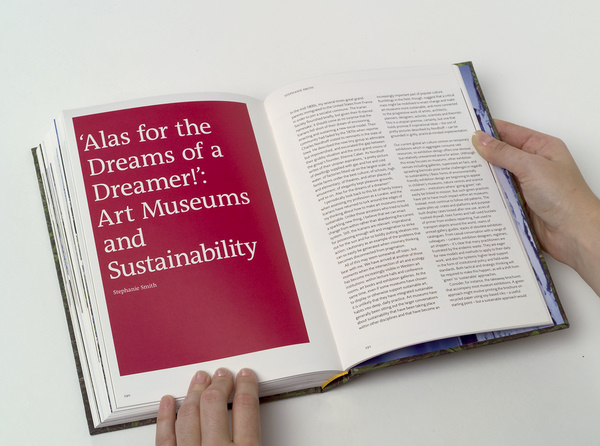 Photo: Latitudes / Robert JustamanteMarch 2023
Photo: Latitudes / Robert JustamanteMarch 2023
Art, Climate, and New CoalitionsMarch 2023: Art, Climate, and New Coalitions
The terminology of environmental consciousness and carbon emissions has shifted significantly in recent decades, from talk of the greenhouse effect to global warming and sustainable development, and now from climate change to the climate emergency. The 2016 United Nations Paris Agreement set specific and binding goals on climate action to reduce emissions by at least 50% by 2030, and in recent years several initiatives springing from the contemporary art and museums sector finally represent real engagement and advocacy for change. For example, ART 2030, Ki Culture, and artist Tino Sehgal have produced the Getting Climate Control Under Control Declaration to encourage the urgent review of practices such as climate control in gallery exhibition spaces. Founded in 2020, the Gallery Climate Coalition offers tools and resources that enable member galleries, as well as organisations and individuals, to calculate and pledge to reduce the carbon footprint of their activities, especially those related to travel and shipping.
Since its inception in 2005, Latitudes has been active in this debate. And as we begin to work on the formation of a new Spanish chapter of the Gallery Climate Coalition (GCC España) with colleagues and other members, our thoughts turn back to an essay by curator Stephanie Smith which we commissioned for Land, Art: A Cultural Ecology Handbook, the publication we produced for the Royal Society of Arts pioneering Arts & Ecology programme in 2006. In the text Stephanie lamented that art museums had largely been sitting out the larger conversation about integrating “sustainable habits into deep, daily practice.” With current initiatives such as MoMA’s ‘Circular Museum’ webinars, and the Whitechapel Gallery’s and GCC’s ‘Climate Crisis >> Art Action’, a two-day symposium tackling the critical environmental issues facing public arts institutions (2–3 March 2023), it seems that such debates in the field are, at last, not only the utopian “dreams of a dreamer.” -
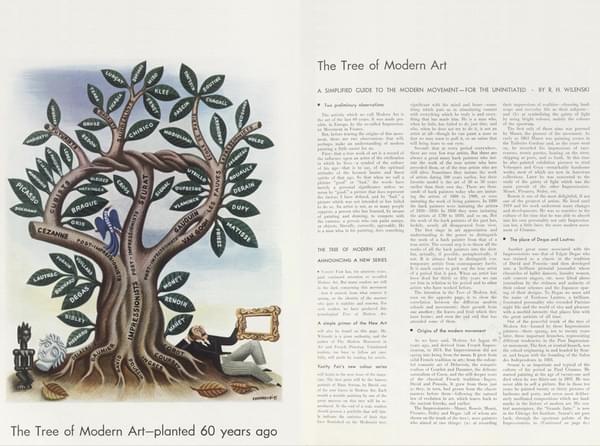 Photo: © Vanity FairFebruary 2023
Photo: © Vanity FairFebruary 2023
Soil for Future Art HistoriesFebruary 2023: Soil for Future Art Histories
Latitudes’ essay ‘Un suelo para las historias del arte del futuro’ (Soil for Future Art Histories) is included in the newly-released catalogue of Futuros Abundantes (Abundant Futures), an exhibition of works from the TBA21 Collection curated by Daniela Zyman that took place at the C3A Centro de Creación Contemporánea de Andalucía in Córdoba last year.
As seen in this month’s Cover Story, The Tree of Modern Art—Planted 60 years ago by Mexican artist and researcher Miguel Covarrubias first appeared in Vanity Fair magazine in 1933, three years before Alfred H. Barr Jr., the first director of the Museum of Modern Art, New York, made his much more widely known Diagram of the Stylistic Evolution of Art 1890–1935.
The essay shows how we might turn the page on such pseudo-organic metaphors, root-and-branch diagrams that have underpinned the cultural narratives of the archetypical institutions of twentieth-century art, and instead consider an entity that has been largely neglected in its capacity to connect human and natural relations: soil.
Soil-attuned thinking in exhibition-making and art museums could, we suggest, “enable a better comprehension of the complex webs made up of various, sometimes conflicting modes of organization and overlapping rhythms that structure an institution. Instead of tree analogies and diagrams of ‘potted history,’ we might imagine intricate time-bound soil forms as complex as the flows in the earth system or planetary movements of water and capital.”
The book is co-published by Ediciones Turner and will be launched in ARCOmadrid’s section of ArtsLibris, on February 23rd at 5pm. Contributions include: Rosemary-Claire Collard, Jessica Dempsey, and Juanita Sundberg; Beatrice Forchini; Mario García Torres; Macarena Gómez-Barris; Berta Gutiérrez Casaos; Soledad Gutiérrez Rodríguez; Latitudes; Regina de Miguel; Plata; Matthew Ritchie; Jess Saxby; Daniela Zyman; Ibn Zaydun. -
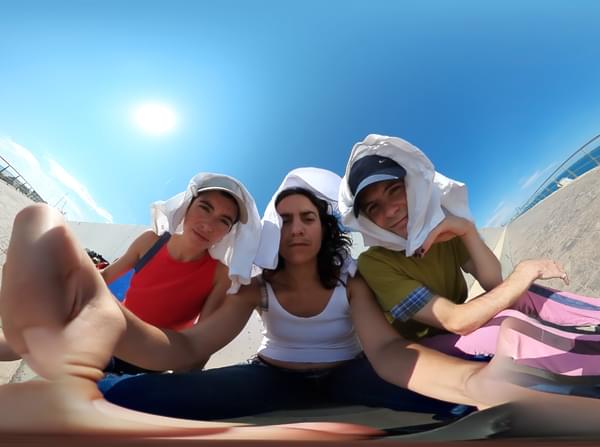 Photo: Claudia PagèsJanuary 2023
Photo: Claudia PagèsJanuary 2023
Claudia Pagès’ “Gerundi Circular”January 2023: Claudia Pagès’ “Gerundi Circular”
Happy New Year! This month’s Cover Story focusses on Claudia Pagès’s Gerundi Circular (2021), a video installation that was commissioned for the exhibition Panorama 21: Apunts per a un incendi dels ulls (Notes for an Eye Fire), curated by Latitudes and Hiuwai Chu for the Museu d’Art Contemporani de Barcelona (MACBA). The work was recently incorporated into the MACBA Collection via a purchase by the Government of Catalonia for the National Collection of Contemporary Art.
This production shot features Claudia, with performers Esther Arribas and Stefan Govaart either side, during a break in filming at three locations around Barcelona’s harbour. Presented in a seamless 360-degree loop in the installation, the footage blends the rhythmic gestures of the three performers, and layers of handwritten texts into a series of music-video sequences that revolve around global maritime routes, and the relentless flow of commerce. Gerundi Circular bears witness to the logistical intricacies of the city as a seemingly frictionless interface between the open space of the sea and manmade infrastructures, behaviours, and the use and abuse of gerund forms in legal jargon as Claudia explains in this podcast.
The work was co-produced by the dance company ELAMOR and, until 15 January, is on show at Tabakalera, the centre for contemporary culture in Donostia. Next month, at Barcelona’s Fundació Joan Miró, Claudia will unveil her latest project as part of a new series of exhibitions curated by Yabi (Beatriz Ortega & Alberto Vallejo) at Espai 13. -
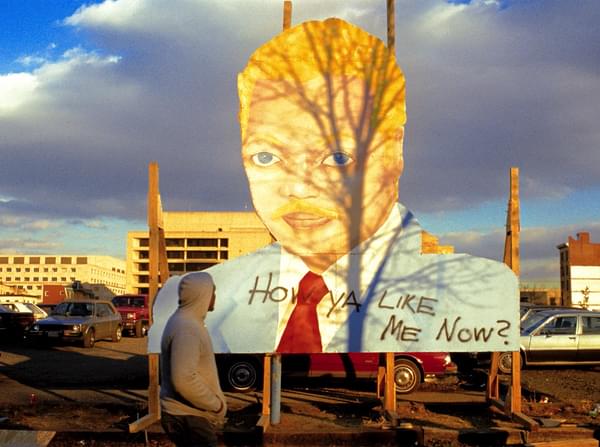 Photo: Phillip Brookman / Rosie Filmwaze, LLCDecember 2022
Photo: Phillip Brookman / Rosie Filmwaze, LLCDecember 2022
The Melt Goes On Forever: David Hammons and Dart FestivalDecember 2022: The Melt Goes On Forever: David Hammons and Dart Festival
Latitudes has been collaborating with Dart, the documentary film festival that focuses exclusively on contemporary art, since its inception in 2017. Its sixth edition has just taken place in Barcelona at Sala Phenomena, Cinemes Girona, and MACBA (24-30 November). We once again formed a part of the prize jury — alongside film critic Quim Casas and journalist Ianko López — and the extraordinary film The Melt Goes On Forever: The Art & Times of David Hammons was awarded the 2022 Critics’ Prize. Directed by Judd Tully and Harold Crooks, the documentary chronicles the career of artist David Hammons from its beginnings in 1960s Los Angeles, via one of the most uncompromising and elusive pathways through the contemporary art world, to its present semi-mythical status.
While the title of the film refers to what is perhaps Hammons’ most infamous work, 1983’s Bliz-aard Ball Sale, this month’s cover story features a still from the movie, itself a photo by curator Phillip Brookman, which shows Hammons’ no less provocative How Ya Like Me Now?, a public art work which was originally located near Washington DC’s National Portrait Gallery in 1989. How Ya Like Me Now? depicts civil rights activist and two-time presidential candidate Jesse Jackson as a blonde-haired blue-eyed white guy, the suggestion being that if Jackson were white, at the very least his portrait would be in the gallery. No depictions of Black Americans were on display at the time. The billboard was almost immediately vandalised by a group of men who found it insulting to the Black community, although it was later repaired and configured with a ring of sledgehammers around it, as if forming a guardrail.
Featuring artists including Lorna Simpson and Betye Saar, curators and critics such as Robert Storr and Franklin Sirmans, and unearthing some fascinating archival footage, The Melt… reveals an artist whose work is rooted in a biting critique of American society and racial politics, while routinely subverting the commercial art world. -
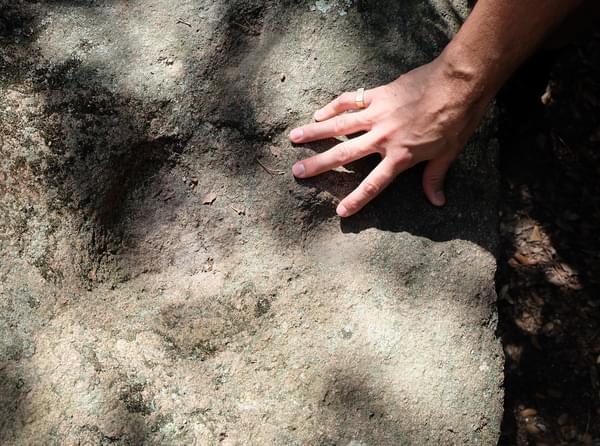 Photo: LatitudesNovember 2022
Photo: LatitudesNovember 2022
Incidents (of Travel): Jorge Satorre’s BarcelonaNovember 2022: Incidents (of Travel)—Jorge Satorre’s Barcelona
“Below the Tibidabo Amusement Park, just where the BV-1418 and BP-1417 roads meet, there are some stairs that go up into the forest. Climbing them, a few meters up on the right, we will find a large stone hidden among the trees. This site is little known, although it is widely believed that the various holes on the surface of the stone were made by prehistoric man and probably served to place the organs of sacrificed bodies. It is also said that it may have served as a trap for animals” – Jorge Satorre.
In the twentieth and concluding dispatch of Incidents (of Travel), Latitudes are led by Jorge Satorre in something of a “voyage around our room”. Manifested itself all over the world since 2016 through the perspectives of other invited curators and artists, Incidents (of Travel) now takes place with us in our own backyard of Barcelona.
Jorge’s itinerary follows a route from the north to the south of the city – from Collserola to Montjuïc – tracing wild boars, two mysterious dolmens, and the devil’s hoof prints along the way.
By chance, this episode takes place on September 19, 2022, exactly ten years later to the day of the first tour commissioned for the first phase of Incidents (of Travel), a day we spent with Minerva Cuevas around Mexico City’s city centre on the 27th anniversary of the deadly 1985 earthquake.
This episode culminates Latitudes’ collaboration with KADIST, producers of twenty wonderful episodes between 2016 and 2022 as part of their online projects. In 2015, KADIST hosted another three tours during Latitudes’ residency at their San Francisco hub. Previously, in 2013, Spring Workshop in Hong Kong produced four itineraries within the frame of the long-term multi-part project Moderation(s) in partnership with (then known as) Witte de With Center for Contemporary Art in Rotterdam, and in 2012, at the invitation of UNAM’s Casa del Lago, Latitudes commissioned the first five itineraries around Mexico City. -
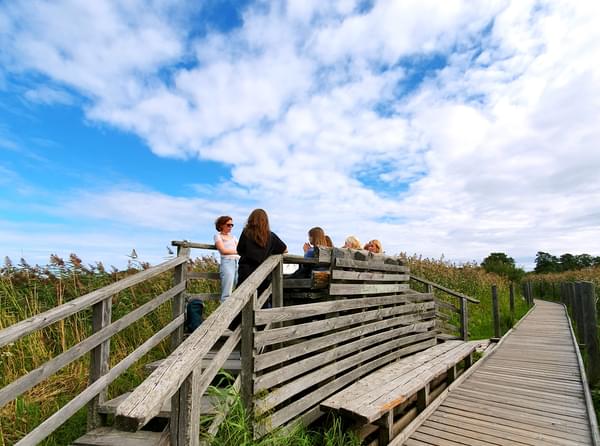 Photo: Micol CuratoloOctober 2022
Photo: Micol CuratoloOctober 2022
Stray Ornithologies—Laia EstruchOctober 2022: Stray Ornithologies—Laia Estruch
Within the context of PUBLICS’ annual gathering Today Is Our Tomorrow, on 8 October Laia Estruch and Irina Mutt will lead a workshop in Helsinki as part of this year’s programme focusing on the presentness of the voice in its many sonic forms, vocal modes and acoustic modalities. This workshop culminates a series of encounters, part of Latitudes’ Parahosting at PUBLICS, that have taken place over the summer in collaboration with PUBLICS Youth, an education initiative for Helsinki-based 18-21-year-olds.
Following a principle of a tour to bodies rather than to space, the sessions have encompassed new embodiments of Laia’s Ocells Perduts (Stray Birds) (2021), a work originally produced for MACBA’s exhibition Panorama 21. Notes for an Eye Fire, curated by Hiuwai Chu and Latitudes, and supported by PUBLICS. This month’s Cover Story features a workshop session from 3 August which took place along the nature trails at Lammassaari.
On another note, Max Andrews of Latitudes hosts “Minor” Ornithologies, a podcast accompanying Laia’s performance for TBA21 on st_age. It takes flight into the realm of birds, looking at politics and practices that disrupt dominant historical narratives and exceed scientific and cultural boundaries. The podcast’s guests are Alex Holt, a spokesperson for Bird Names for Birds, a movement to decolonise bird names, and zoömusicologist Dr Hollis Taylor who specialises in birdsong. -
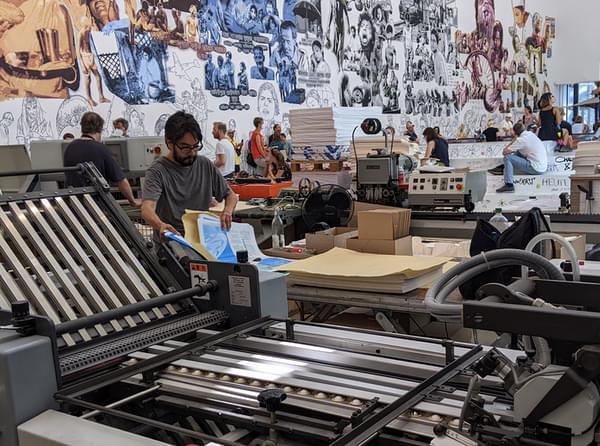 Photo: LatitudesSeptember 2022
Photo: LatitudesSeptember 2022
The means of print production: Erick Beltrán and lumbung pressSeptember 2022: The means of print production—Erick Beltrán and lumbung press
One of the most consequential and ambitious initiatives at the sprawling and polyphonic documenta fifteen is lumbung press, one of several working groups conceived by the artistic directors ruangrupa that transverses the many invited artists, community-oriented collectives, organisations and institutions brought together in Kassel.
Located at the end of the documenta Halle is a fully functioning collectively run offset print shop. Spurning the traditional catalogue concept and publishing house partner of previous documenta editions, Erick Beltrán and the artists themselves effectively own and work the means of production. Liberated from the onerous logic of the book trade, its tightly controlled print-runs and strict editing protocols, the independent lumbung press team aims to make an unencumbered circulation of information possible through a non-mediated editorial flow, including scores of artists’ books and posters, as well as two post-exhibition compendiums. Moreover, the goal of lumbung press is to continue after documenta fifteen closes its doors as a collectively owned itinerant publishing facility in ongoing service to and collaboration with this documenta edition’s participants. -
 Photos: Swan ParkJuly–August 2022
Photos: Swan ParkJuly–August 2022
Incidents (of Travel) from SeoulJuly–August 2022: Incidents (of Travel) from Seoul
This summer’s Cover Story features twelve photographs by Swan Park that were taken during the day that curator Sooyoung Leam and artist–filmmaker Yeoreum Jeong spent together in Seoul for the nineteenth dispatch of ‘Incidents (of Travel)’. Reload (or resize) the page to display a different image.
The episode centres on Yongsan, a district at the heart of Seoul, and a conflicted territory that served as the headquarters of the Imperial Japanese Army during Japan’s occupation of the Korean Peninsula (1910–1945), and then hosted a vast U.S. military base. It is forbidden to enter the zone, which appears as a blank spot on the map. Yet by using the AR location-based mobile game Pokémon GO, Yeoreum and Sooyoung explore ways to travel both physically and virtually during a timely moment when the military base is being relocated to the nearby city of Pyeongtaek, and the territory awaits a new life as a memorial park.
By combining the socio-political history of Yongsan with the personal and micro-history of Yeoreum’s everyday life, the Seoul edition offers new ways to engage with the city’s shifting symbolic landscape. The episode departs from Yeoreum’s ‘Graeae: A Stationed Idea’ (2020), a film constructed entirely out of found images and found footage.
Since 2012, ‘Incidents (of Travel)’ has explored the chartered day-long itinerary as a format of artistic encounter and an extended conversation between curators and artists. As a web-based format, it has been hosted and produced by Kadist Online since 2016. -
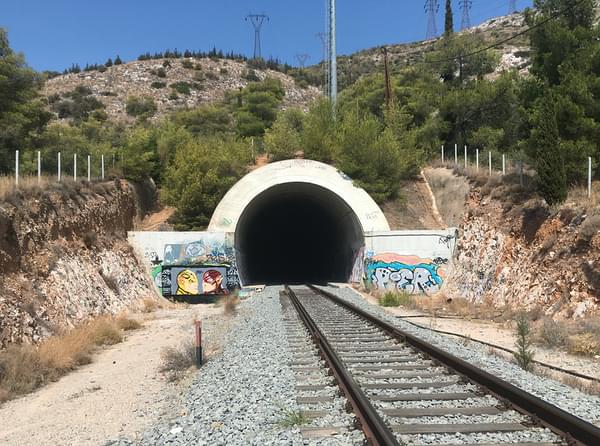 Photo: Xenia Kalpaktsoglou & Pegy ZaliJune 2022
Photo: Xenia Kalpaktsoglou & Pegy ZaliJune 2022
Cyber-Eco-Feminist Incidents in AtticaJune 2022: Cyber-Eco-Feminist Incidents in Attica
In the eighteenth episode of ‘Incidents (of Travel)’ curator Xenia Kalpaktsoglou and artist Pegy Zali conceive an itinerary and a screenplay-like commentary that takes us through Greece’s Attica peninsula, from a mysterious inscription sprayed at the site of a railway sabotage that transpired near Piraeus Port in 2010, to the vestiges of an enormous wildfire that consumed the forest around Alepochori in 2021. Formed through their long-standing friendship and shared research interests, this episode flows around Greece’s links with the emerging infrastructure of China’s New Silk Road, and the “cyber-eco-feminist” traces of the goddess Gaia.
This is the latest dispatch of the series produced by KADIST and edited by Latitudes since 2016, exploring the chartered itinerary as a format of an artistic encounter between curators and artists. ‘Incidents (of Travel)’ is presented in one continuous immersive read interwoven with images and short videos in a mobile-friendly format.
The project was originally conceived in 2012 when Latitudes commissioned 5 day-long artist-led tours around Mexico City in the framework of their short residency at Casa del Lago. It had sequels in 2013 in Hong Kong with live dispatches of videos, photographs and soundscapes published through social media, and continued in 2015 in San Francisco with daily posts as part of Kadist's Instagram take over initiative “Artist Not In The Studio Curator Not At The Office”.
Since 2016, eighteen extended conversations between curators and artists have taken place in Riga (Latvia), Beirut (Lebanon), Amsterdam (the Netherlands), Singapore (Singapore), Cabo Rojo (Puerto Rico), Tbilisi (Georgia), Panama City (Panama), Rio de Janeiro (Brazil), Reykjavík (Iceland), Buenos Aires (Argentina), Hobart (Tasmania), Yerevan (Armenia), Terengganu (Malaysia), Lisbon (Portugal), Suzhou (China), Jinja (Uganda) and Chicago (US). -
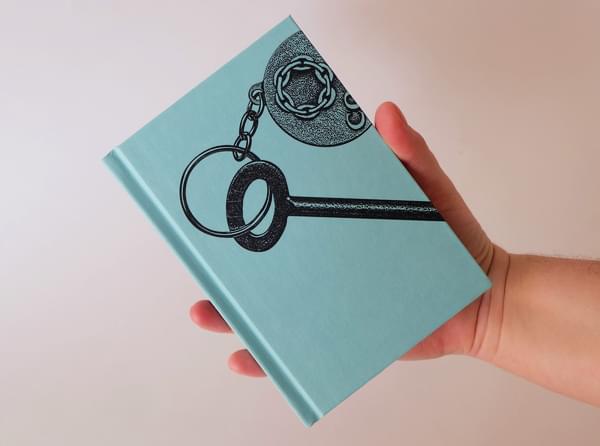 Photo: LatitudesMay 2022
Photo: LatitudesMay 2022
Things Things Say in printMay 2022: Things Things Say in print
“Do you trust things to write human history? To speak on behalf of natural history? Did you ever own a pair of dungarees? When do trivial details become vital? Can a pebble destroy an empire if the emperor chokes at dinner? Would the pebble stand accused? Do you ever feel that the thing we call theory and the thing we call art are moving in different directions? Shouldn’t exhibitions be the place to think about the relationships between human subjects and inanimate objects?…” So began the list of thirty-three questions that confronted visitors to the group exhibition “Coses que les coses diuen” (Things Things Say), curated by Latitudes at Fabra i Coats: Centre d’Art Contemporani (October 2020–January 2021). Alongside a preface by art centre director Joana Hurtado Matheu, a text by participating artist Eulàlia Rovira, and commentaries on each exhibited work, the catalogue accordingly features thirty-three responses. Ranging from literary quotations and curatorial touchstones, to theoretical anecdotes and red herrings, the “answers” wander around the exhibited works, and tack back-and-forth between exceptionally normal things and the extraordinary global narratives of labour, obsolescence, and the industrialisation of nature, that they trigger.
Designed by Bendita Gloria and with texts in Catalan, Spanish, and English, the publication is available from Fabra i Coats: Centre d’Art Contemporani itself, as well as the Sala Ciutat of the Ajuntament de Barcelona, the Llibreria de la Diputació de Barcelona and Llibreria Laie.
“Things Things Say” was an exhibition with works by Adrià Julià, Annette Kelm, James N. Kienitz Wilkins, Sarah Ortmeyer, Eulàlia Rovira, Francesc Serra i Dimas, Stuart Whipps, Haegue Yang, as well as meaningful things from the Friends of Fabra i Coats archive. Check out Latitudes’ other publications here. -
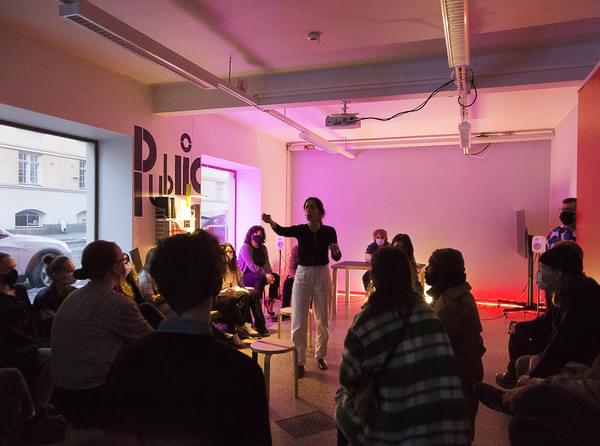 Photo: Noora LehtovuoriApril 2022
Photo: Noora LehtovuoriApril 2022
Mix & Match—Laia Estruch at PUBLICSApril 2022: Mix & Match—Laia Estruch at PUBLICS
On the 17 March 2022, the first event of a year-long “Parahosting” collaboration between Latitudes and PUBLICS took place in Helsinki. The Parahosting programme of PUBLICS began in 2018, and it has grown into a key method of decentering the authorship of the curatorial agency through a flexible, evolving, expanding, and sometimes messy, practice of working together.
Latitudes gave talk at PUBLICS’s library and event space in Vallila, which was followed by Laia Estruch’s Mix (2021–ongoing). This solo performance compilation revisited the diverse voiced sounds, resonances, and articulations the that Laia has developed and learned throughout her projects to date. An exercise in sonic recall and muscle memory, Mix is a live non-chronological edit that extracts the most ephemeral aspect of her practice – the voice – while exploring it as a kind of organ of the body, and as a tool for sculpting air.
PUBLICS and Latitudes were first matched in September 2019 as partners of the festival Today is our Tomorrow presenting a performance by Mercedes Azpilicueta. In October 2021, the organisation supported the production of Laia’s Ocells perduts (Stray Birds), an installation and series of performance rehearsals commissioned for the exhibition Panorama 21: Notes for an Eye Fire curated by Hiuwai Chu and Latitudes for the MACBA Museu d’Art Contemporani de Barcelona. -
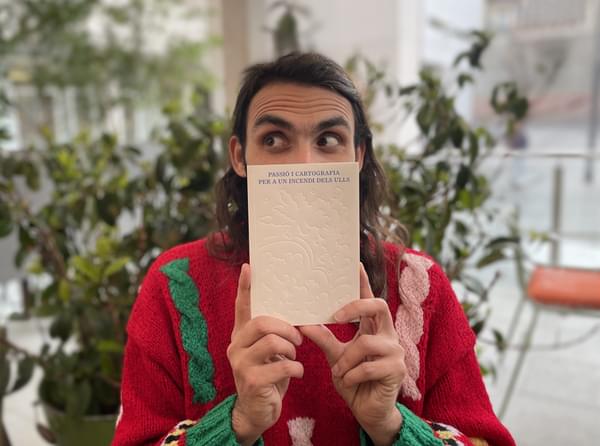 Photo: Hiuwai ChuMarch 2022
Photo: Hiuwai ChuMarch 2022
The Passion of Gabriel VenturaMarch 2022: The Passion of Gabriel Ventura
«La tàctica és acariciar el moment: convertir l’esquerda en discussió verbal, gestual, multicanal, enfonsar-hi les visions»
“The tactic is to caress the moment: to convert the crack into a verbal, gestural, multi-channel discussion, to scuttle visions”
The exhibition Panorama 21. Apunts per a un incendi dels ulls (Notes for an Eye Fire) has come to the end of its run in the galleries of MACBA. But it lives on through the fifty-two pages of Passió i cartografia per a un incendi dels ulls (Passion and Cartography for an Eye Fire), a small publication which presents a three-part Catalan-language poem–dérive by Gabriel Ventura that decomposes the exhibition’s plurality of voices and points of view into a kind of textual topography. The publication is designed by Ana Domínguez Studio (Lara Coromina and Ana Domínguez) and also features a selection of images of the exhibition, as well as a ghostly evocation of its graphic identity—translucent pages that seem to veil the images and words with billowing smoke clouds and flashes of energy. Available from the MACBA bookstore! -
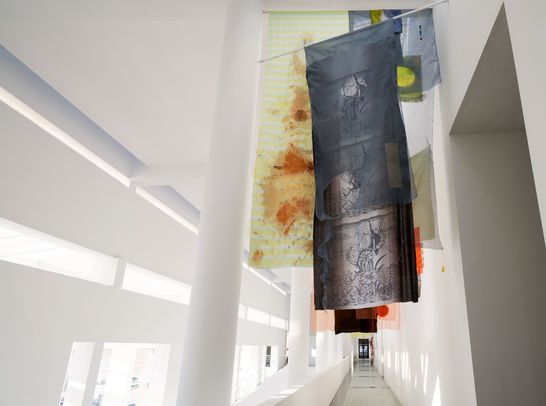 Photo: Miquel CollFebruary 2022
Photo: Miquel CollFebruary 2022
Rosa Tharrats’ textile alchemyFebruary 2022: Rosa Tharrats’ textile alchemy
Protruding from three of MACBA’s columns like sails lashed to the masts of a ship, Rosa Tharrats’ Akaal / Selene \ Uluru (2021) is composed of layers of woven and printed cloth that have been stitched and fused together in combination with composites of homemade bioplastics—polymers made from biological sources such as seaweed and starch that have the potential to alleviate the growing problem of marine pollution.
Inspired by an unidentified photograph of a sailboat from her grandfather’s archive, the seascapes around Cadaqués, and the patchwork sails created by the Vezo people of Madagascar, Rosa calls attention to the vulnerability of the oceans and the multiple communities dependent on their wellbeing, and she imagines material cultures and technologies based on coexistence and care.
The “Selene” sail is printed with an image of a goddess sitting on a lotus flower, an engraving from Athanasius Kircher’s China Illustrata (1667) later popularised in Bernard Picart’s lavishly illustrated Religious Ceremonies and Customs of All the Peoples of the World, 1723–43. The latter was a widely distributed, early enlightenment encyclopaedia of origins beliefs and rites that sowed the radical idea that all religions could be considered on equal terms. Whether the idol Pussa, the Greek Cybele, the Egyptian Isis, or a fanciful version of Buddha, the syncretic goddess expresses the principle that water nourishes all things.
The exhibition Panorama 21. Apunts per a un incendi dels ulls (Notes for an Eye Fire) runs until 27 February 2022 at MACBA, Barcelona. -
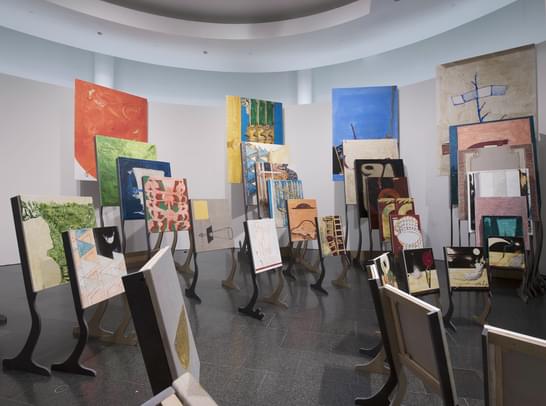 Photo: Roberto RuizJanuary 2022
Photo: Roberto RuizJanuary 2022
Rasmus’ DoubtsJanuary 2022: Rasmus’ Doubts
Hermetic philosopher Giulio Camillo built his Theatre of Memory in Venice in around 1530. Inverting the perspective of ancient theatre, a single spectator could stand on a central “stage” to look out at a wooden auditorium of seven rows of seven pictures. An occult matrix of divine, celestial, and terrestrial knowledge, this mystical device enabled the entirety of existence and the workings of the universe to be beheld at once, and their relations and meanings to be called to mind and read off like an audacious rhetorical aide-mémoire.
Rasmus Nilausen created his Theatre of Doubts (2021) for the exhibition Apunts per a un incendi dels ulls (Notes for an Eye Fire) (at MACBA, Barcelona, until 27 February 2022) as an homage to Camillo’s sublime and ridiculous project. (Yet the title is the only thing he is sure about.) Evidently flawed and over ambitious, Rasmus’s liberal revival of the memory theatre format draws on 49 works from his own painterly and allegorical universe. Visitors are invited to wander among images which themselves seem to be going for a walk, to adopt multiple viewpoints, see unfamiliar connections, and summon new memories.
The first row takes on the seven planetary deities of Camillo’s Renaissance design: Diana (the Moon), Mercury, Venus, the Sun (represented by a banquet), Mars, Jupiter, and Saturn. The blue canvas seen in the last row here is titled Erasmus’ Doubts / Measuring your own grave (2021). “Desiderius Erasmus and our beloved Giulio Camillo were contemporaries, yet ambassadors of quite opposite views of the world,” Rasmus explained recently in an Instagram post. “This painting was the last I made for the Theatre of Doubts, it’s a memento mori inspired by a miniature made by Bernat Martorell. The last part of the title was borrowed from a monograph on Marlene Dumas. Because of Barcelona’s status as one of the top choices for participants in the Erasmus exchange programme, more than once people would reply ‘yes, or sí’ when introducing myself.” -
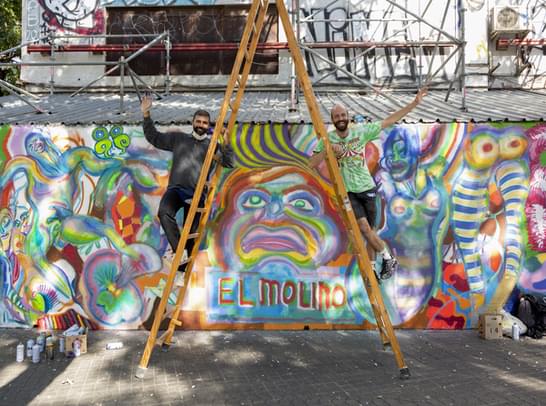 Photo: Eva CarasolDecember 2021
Photo: Eva CarasolDecember 2021
Between Meier and Meller: Toni and Pau at the Teatre ArnauDecember 2021: Between Meier and Meller: Toni and Pau at the Teatre Arnau
Antoni Hervàs’ La Meiers / La Mellers (2021) is a two-part artwork created for the exhibition Apunts per a un incendi dels ulls (Notes for an Eye Fire) (at MACBA, Barcelona, until 27 February 2022) and inspired by Barcelona’s Teatre Arnau. Currently awaiting a major restoration, the Arnau was one of the most celebrated music hall and cabaret venues in the city until its closure in 2004. Toni honours a legacy of popular entertainment and recognises the energy and precarity of personalities who, despite all odds, still keep the show going.
Alluding to the Monopoly-like board game El Chino—a comic-book take on Barcelona’s El Raval neighbourhood—the project’s twinned elements take you on a route through the barrio, from the Teatre Arnau itself on Avinguda del Paral·lel to the entrance of the exhibition at MACBA, or vice-versa. (The title is a wink to the architect of the MACBA building, Richard Meier, and Raquel Meller, the star of the 1920s and 1930s who gives her name to the plaza in front of the Arnau.)
Toni collaborated with Pau Magrané and the street art project Arnau Gallery to graffiti the wall which fronts the Arnau during its restoration, creating a blatantly garish 24-metre mural (until the 10 January) that celebrates cabaret denizens such as Pierrot, Violeta la Burra, and Ángel Pavlovsky, and chronicles beloved neighbourhood theatres and bars of past and present such as Barcelona de Noche and El Molino. At the museum, the exhibition begins by passing through a papier-mâché portal conceived as a sort of boisterous animated character based on the fan-shaped pediment that once crowned the Arnau. -
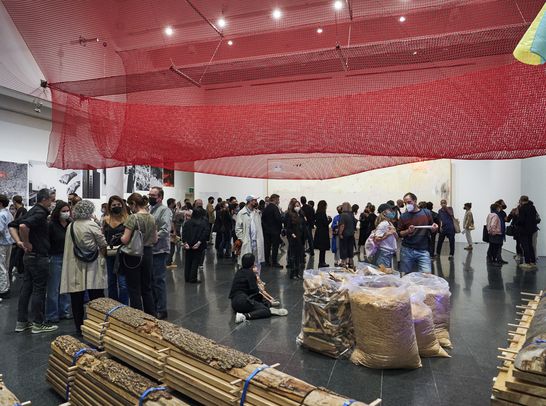 Photo: MACBA / Miquel CollNovember 2021
Photo: MACBA / Miquel CollNovember 2021
Notes for an Eye FireNovember 2021: Notes for an Eye Fire
“There are days when an event, by the logic of the unforeseen, makes a cut in history and a different world is born. The MACBA exhibition Apunts per a un incendi dels ulls (Notes for an Eye Fire) welcomes us after the global reset with a new generation.” Comments such as this one, from the poet and critic Vicenç Altaió, are both gratifying and humbling to read now that, following sixteen months of preparation—and some might say more than twenty-five years of expectation—this group exhibition of artists from the Barcelona art scene, conceived during the harshest moments of the pandemic, is finally open to the public (until 27 February 2022). As the exhibition title by Gabriel Ventura suggests, it is open not only to visitors’ eyes and words, but to our ears, and our whole bodies’ sensing.
Notes and noises fly out and around a vast red net that is suspended high above—a stage for a series of live vocal rehearsals by Laia Estruch, the first of which takes place on 20 November. A resinous smell emanates from several tree trunks, sourced by nyamnyam and Pedro Pineda from a sustainable forestry initiative, as they await their transformation into a range of tables, benches, and other structures. A huge multi-canvas installation by Marria Pratts floats away from the wall and off the floor. Aleix Plademunt’s photographs take us from the visual noise of the Big Bang to a sunset in the artist’s birthplace. We'll be highlighting these and the fourteen other contributions over the coming months! -
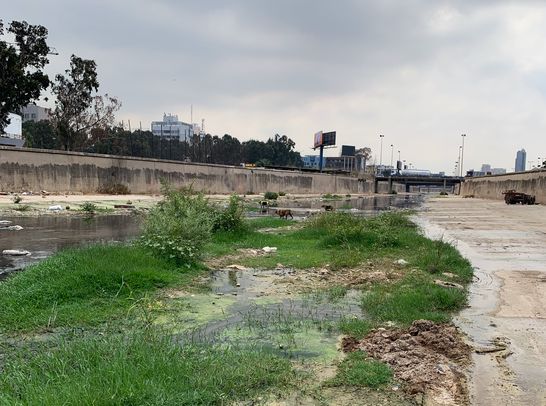 Photo: Panos AprahamianOctober 2021
Photo: Panos AprahamianOctober 2021
Fear and Loathing in LebanonOctober 2021: Fear and Loathing in Lebanon
“The Beirut River, at least in its current state, is a testament to infrastructural failure in Beirut”, writes artist and filmmaker Panos Aprahamian in his itinerary for the latest edition of Incidents (of Travel), from the Lebanese capital. “The river where my grandfather used to swim is now a stream of urban and industrial waste walled by raw concrete, taking the city’s toxicity out into the sea. A blast wave caused by the Beirut port explosion in August 2020 returned a lot of pollution back upstream.”
A year on from the devastation of the port explosion, which left half the city ravaged, more than 200 people dead, and thousands wounded, Panos and Marie-Nour Hechaime, curator at the Sursock Museum, took a day to explore the past and present of a place in the midst of a slow-burn crisis—and dare to consider its future.
Panos and Marie-Nour’s sobering contribution is the 16th episode of Incidents (of Travel), the Kadist online project edited since 2016 by Latitudes. -
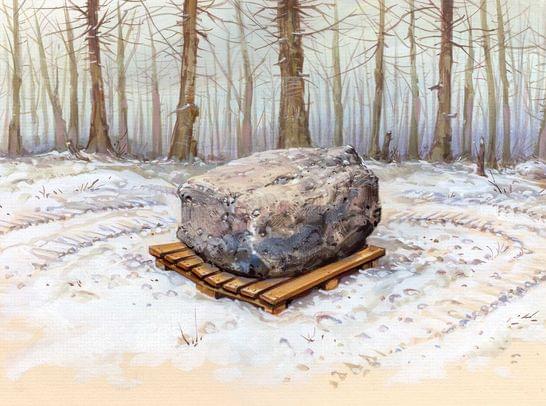 Photo: Jorge Satorre & Jorge AviñaSeptember 2021
Photo: Jorge Satorre & Jorge AviñaSeptember 2021
Erratic behaviour—Latitudes in conversation with Jorge SatorreSeptember 2021: Erratic behaviour—Latitudes in conversation with Jorge Satorre
In 2008 the Port of Rotterdam in the Netherlands, the largest in Europe, began a dramatic project to extending its land by 20% into the sea. Known as Maasvlakte 2, the construction involved bringing more than 5 million tons of rock from Scandinavia for the construction of dikes and dams, alongside a programme of ecological offsetting. Jorge Satorre’s The Erratic. Measuring Compensation (2009–10) was one of ten artworks produced throughout 2009 in response to Maasvlakte 2. Portscapes was initiated by the Port of Rotterdam Authority with support from SKOR and was curated by Latitudes.
Jorge’s project began with the search for a rock — an “erratic” that would have already been transported to the Netherlands from Scandinavia many thousand of years ago by glaciers during the last ice age. It centred on a three and a half ton boulder eventually found on farmland near Emmen, and concluded in a forest in southern Sweden on January 8th 2010. What lay in between was an often fraught process of negotiation and geological suspense: a symbolic restitution with a very physical manifestation.
The traces of Jorge’s extraordinary project now form a part of the collection of the Museo Amparo in Puebla, Mexico. On September 22nd, 2021, a conversation between Jorge and Latitudes about the commission will be broadcast via the museum’s Facebook page in the framework of El tiempo en las cosas, an exhibition curated by Tatiana Cuevas that is currently on view there. Tune in! -
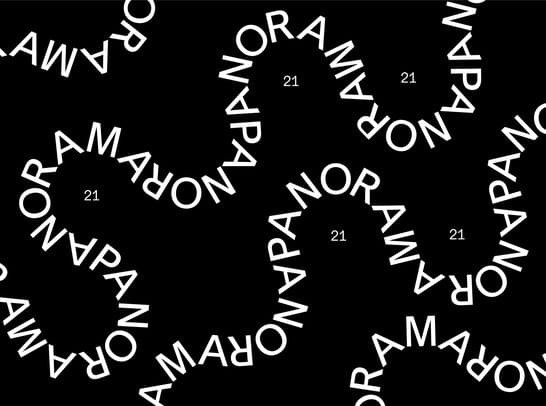 Photo: MACBAJuly–August 2021
Photo: MACBAJuly–August 2021
Panorama: a wide view from a fixed pointJuly–August 2021: Panorama: a wide view from a fixed point
Panorama is a new series of exhibitions at the Museu d’Art Contemporani de Barcelona (MACBA) dedicated to contemporary art practices in, around, and from Barcelona. Curated by Hiuwai Chu and Latitudes, the first edition will open its doors on 22 October 2021 under the title Apunts per a un incendi dels ulls (Notes for an Eye Fire) after the recent poetry collection by Gabriel Ventura.
Ana Domínguez’s visual identity for the series takes the word panorama—a portmanteau of the Greek pan (“all”) and horama (“view”)—and runs with it, allowing it to playfully scythe across screen and page in a series of black-and-white switchbacks and arabesques.
Poet Gabriel and graphic designer Ana are two of the seventeen participants (including duos and collaborations) of Notes for an Eye Fire, and we are delighted that the full list is finally public: Ana Domínguez, El Palomar (Mariokissme & R. Marcos Mota), Laia Estruch, Arash Fayez, Antoni Hervàs, Rasmus Nilausen, nyamnyam (Ariadna Rodríguez & Iñaki Álvarez) with Pedro Pineda, Claudia Pagès, Aleix Plademunt, Marria Pratts, Stella Rahola Matutes, Eulàlia Rovira, Ruta de autor (Aymara Arreaza R. & Lorena Bou Linhares), Adrian Schindler, Rosa Tharrats, Gabriel Ventura, and Marc Vives.
With many ambitious new projects in progress since last summer, the show attempts to question the dominance of vision, and to vindicate the exhibition ritual as a direct in-person sensory experience that engages new ways of navigating the world, of remembering and of producing knowledge. -
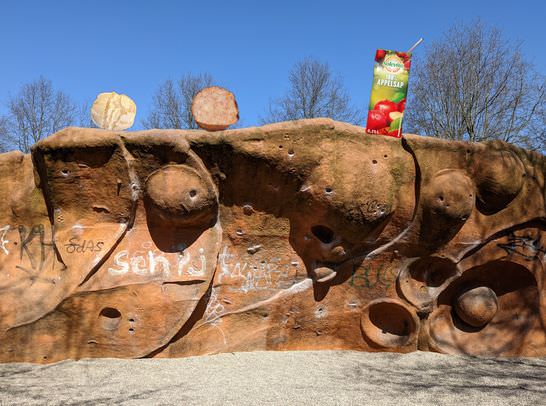 Photo: Salim BayriJune 2021
Photo: Salim BayriJune 2021
Fitness food—Salim Bayri’s AmsterdamJune 2021: Fitness food — Salim Bayri’s Amsterdam
“For me, sport brings aspects that I miss in art: direct group interaction and a clear reward and penalty system”, writes artist Salim Bayri in his itinerary for the latest edition of Incidents (of Travel), in which he devised an alternative day-long tour of Amsterdam for curator Àngels Miralda. In the wake of pandemic restrictions, and with gyms, restaurants, and other indoor venues still closed, outdoor sports locations and take-away food options had taken on new significance as valued social spaces and venues for cultural stimulation.
Imagining a playfully artistic sporting challenge, Salim’s photo collage accordingly fuses two important but seemingly contradictory aspects of the day with Àngels into a single image: exercising and snacking. The public climbing wall in Amsterdam’s Meerpark is crowned by the prize of gigantic snacks and an outsized refreshment bought from the discount supermarket chain Lidl, a branch of which also features as a stop-off en route. Lidl, writes Salim, “has a unique and nostalgic non-place feel that gives a sense of shared home. It is a micro-representation of Europe where pasteis de nata, croissants, appelflapjes, and böreks are bound together by cheapness.” Following weeks of confinement and “the strange sense of experiencing the world through a screen”, as Àngels puts it, Salim’s tour attempts to find new routes for saved-up energy and unlikely ways of coming together. -
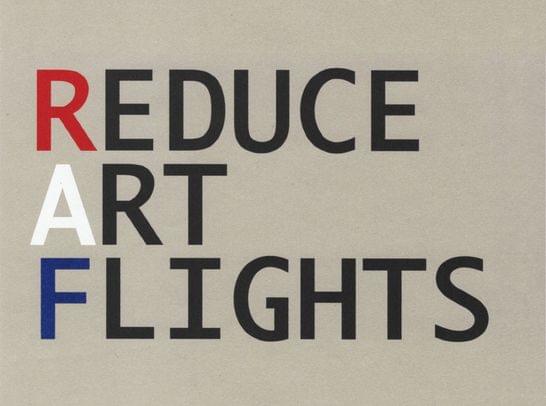 Photo: LatitudesMay 2021
Photo: LatitudesMay 2021
RAF goes viralMay 2021: RAF goes viral
RAF / Reduce Art Flights is a campaign imploring that the art world (artists, curators, critics, gallerists, collectors, museum directors, etc.) should diminish its use of aeroplanes. It was initiated by the artist Gustav Metzger (1926–2017) on the occasion of the artist’s participation in Skulptur Projekte Münster in 2007, during which 5,000 leaflets based on a 1942 Royal Air Force poster were distributed.
The website reduceartflights.lttds.org was established in 2008 by Latitudes with the blessing of Gustav as new wing of the campaign alongside the reactivation of the RAF initiative as part of the exhibition Greenwashing. Environment: Perils, Promises and Perplexities. It now acts as a growing repository of information about RAF, with details of further leafleting campaigns, such as those in Mexico City (2015) and Lausanne (2018).
Yet what does it mean that a virus effectively realised the aims of RAF last year—at least temporarily? What does Metzger’s prescient vision of degrowth entail in 2021? The time is ripe for thinking through what RAF implies for a whole suite of institutional and personal commitments in terms of art-world travel and transport, something that the Gallery Climate Coalition, to mention one example, is addressing.
For those in London, Tate Modern reopens of 17 May with a room dedicated to Gustav Metzger, organised by Valentina Ravaglia (Curator, Displays & International Art). Including a presentation of RAF, the display tackles the artist’s extraordinary portent of the destructive potential of technology. -
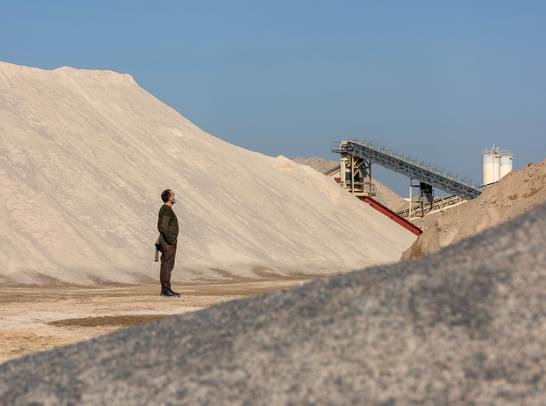 Photo: Jordi V. Pou. © Centre d’Art la PaneraApril 2021
Photo: Jordi V. Pou. © Centre d’Art la PaneraApril 2021
Lara Almarcegui at La PaneraApril 2021: Lara Almarcegui at La Panera
Latitudes participated in an online roundtable, and wrote the exhibition text, for Lara Almarcegui’s Graves (Gravels), currently on view at the Centre d'art la Panera, Lleida, until 30 May. “What possibilities begin to emerge when the excavation at a quarry is stopped?”, the text wonders. More specifically, when La Plana del Corb, a gravel works operated by the Sorigué group, temporarily stops its operations for a single day? On 19 February this year visitors experienced this usually bustling and noisy industrial complex near the town of Balaguer as a place of contemplation. (The site is also home to the Sorigué foundation’s art space Planta.) In the exhibition, curated by La Panera's director Cèlia del Diego, a video projection documents the same stopped quarry. With none of the usual droning machinery, hissing water jets, or crunching and mounding gravel, we witness a stark granular landscape of artificial cliffs, islands, and isthmuses of terrain, from which the long necks of conveyor belts emerge, frozen as if mechanical dinosaurs. Lara juxtaposes this stopped clock of extraction with a wall text which presents a calculation of nothing less than the principal geological ingredients of the Pyrenees.
Gravels extracted from La Plana del Corb are destined for use in the concrete and asphalt that characterises the built environment. These diverse miscellanies of small stones and mineral debris are eroded and displaced mountains, an abiding disaggregation of the Pyrenees. Matter moved down to the lowlands like lithic glaciers over a length of time on a human scale that may as well be forever. Once gouged by ice and flushed out of the mountains by turbulent streams rushing through the ancient pinnacles and foothills, it travelled in floods, thickened primal river beds, filled valleys – spreading wide and washing out into deep deposits and deltas. Quartzes, slates, and hornfels; schists, limestones, and granites: picking through the gravel is like sorting evidence from a primordial explosion. Looking from the video to the mountains in list form we read across and upwards from one world to another. From future buildings and infrastructure to the ancient natural formations that their components once came from. -
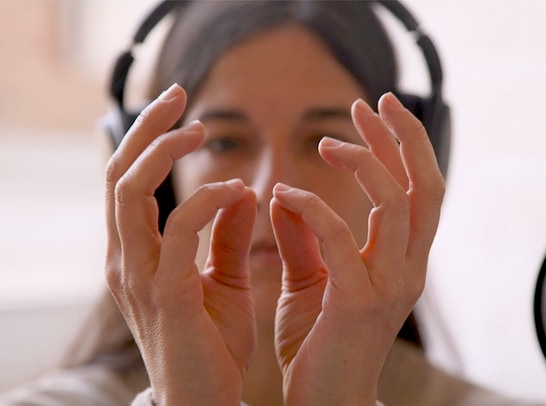 Photo: Eulàlia RoviraMarch 2021
Photo: Eulàlia RoviraMarch 2021
Eulàlia Rovira’s ‘A Knot which is Not’March 2021: Eulàlia Rovira’s ‘A Knot which is Not’
This video was developed during and departing from the exhibition Things Things Say, and was inspired by the history of the space which hosted it. It comprises a live reading in Catalan by Eulàlia Rovira that was filmed, without the presence of an audience, in the galleries of Fabra i Coats: Contemporary Art Centre of Barcelona immediately following the end of the exhibition and the deinstallation of the works of art.
Drawing on veiled allusions to the works in the ex-exhibition, conversations with Pere Fernàndez Bori from the Friends of Fabra i Coats, along with reference works in the field of knotting, archaeology, linguistics, and feminist philosophy, Eulàlia intertwines two voices and two forms once manufactured at Fabra i Coats: nets and threads. Looking at knots as articulations, where lines of fibres become things with agency and knowledge, A Knot Which is Not is both a reading and a writing of Things Things Say and a story about the objects, words, emotions, and meanings that can be tied and tangled by hands and machines.
The script derives from an experimental essay by Eulàlia which will be included in the forthcoming Things Things Say publication designed by Bendita Gloria. “And she began pulling at the threads, hoping for the same pleasure you get from pulling at the loose threads of a sock. Doing what you know you shouldn’t, but you just can’t help it. You pull and you unravel; you pull again, and it starts to disappear. But she stops halfway through, when half the net and half the thread has been unravelled, without knowing what to call something half done, that is only just.” -
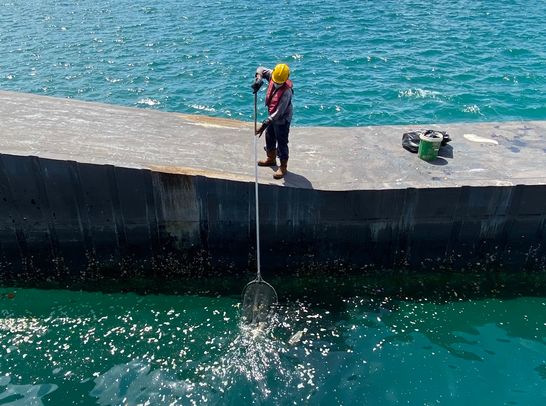 Photo: Fyerool Darma & Nurul Huda RashidFebruary 2021
Photo: Fyerool Darma & Nurul Huda RashidFebruary 2021
Straits Time: narrative smuggling in SingaporeFebruary 2021: Straits Time: narrative smuggling in Singapore
In the latest episode of ‘Incidents (of Travel)’ from Singapore, curator Kathleen Ditzig and artists Fyerool Darma & Nurul Huda Rashid take us on a journey through regional folklore, historical amnesia, and the façade of mass-surveillance in this city state.
They cross the boardwalk over the channel that separates Singapore’s largest shopping centre from Sentosa Island, once called Pulau Blakang Mati (“island of death behind”). Throughout the Japanese occupation of Singapore during the Second World War, the island was the site of Operation Sook Ching, a systemic purge of the Chinese believed to have supported China’s resistance of Japan. In more recent times, Sentosa was the site of former American President Donald Trump’s meeting with North Korean leader Kim Jong-un in June 2018.
As Kathleen recounts, “From the bridge, Fyerool points to the horizon... He tells us about Hindu and Buddhist narratives that mention a duel between a Naga (a snake deity), and a Garuda (a mythic bird) that started because the former was caught whilst attempting to steal the latter’s eggs. This story is derived from the Middle East, yet it was set at the edge of the South China Sea. Fyerool believes that the fight happened here. Perhaps this story is a metaphor of the exploits of the pirates that once occupied these straits...”
“Nurul notices a man using a net to scoop up garbage and dead fish from the surface of the sea. I remember something from A Tropical Tapestry, Hubert S. Banner’s 1929 travelogue of the Malayan Peninsula, illustrated with woodcuts by the Singapore-based artist Dorothy Hope-Falkner. He described the straits around Singapore ‘as a mighty highway of Venetian glass.’ The sea is a glass-green. The man is alone with a small net and yet tasked with the monumental labour of maintaining the glassy façade of the sea. He might as well be cleaning the windows of a skyscraper. We walk to the jetty where contraband supposedly arrives in Singapore. In some ways, I think Fyerool and Nurul are using the Strait to smuggle in narratives through the cracks in Singapore’s façade.” -
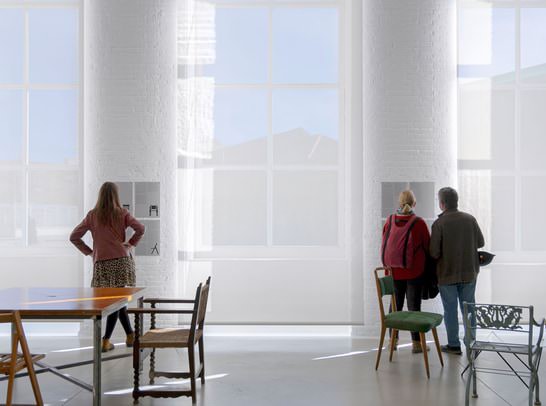 Photo: Eva CarasolJanuary 2021
Photo: Eva CarasolJanuary 2021
‘Things Things Say’: ‘VIP’s Union’January 2021: ‘Things Things Say’: ‘VIP’s Union’
People and things write mutual biographies. A folding chair from the studio of artist Ignasi Aballí, and a wooden chair from the kitchen of PAAC President Montserrat Moliner sit around a table designed by teacher Lluís Vallvé Cordomí. How are things with you?
An elegant green 1950s chair belonging to architect Francesc Bacardit, a cast iron Schinkel chair purchased by Joan Subirats in 1981, and an upholstered armchair lent by Àngels Ponsa, Minister of Culture of the Government of Catalonia, join gallerist Àlex Nogueras’ glass coffee table, which once graced an apartment in Gaudí’s La Pedrera. What’s the gossip?
These and other borrowed tables and chairs that form Haegue Yang’s VIP’s Union (2001–20) create a kind of subverted hospitality area in the exhibition Things Things Say (at Fabra i Coats: Contemporary Art Centre of Barcelona until 17 January 2021). This temporary gathering of furniture of distinct styles, origins, functions, and personal significance, summons a new community through the generosity and goodwill of the lenders, each of whom are in one way or another “very important people” to the art centre.
Each item is not simply a surrogate or a straightforward narrator for its owner. Whether a humble place to perch or a seat of power, these supposedly inanimate things appear as themselves, yet they also produce, maintain, and perform social rituals and form repositories of memories. -
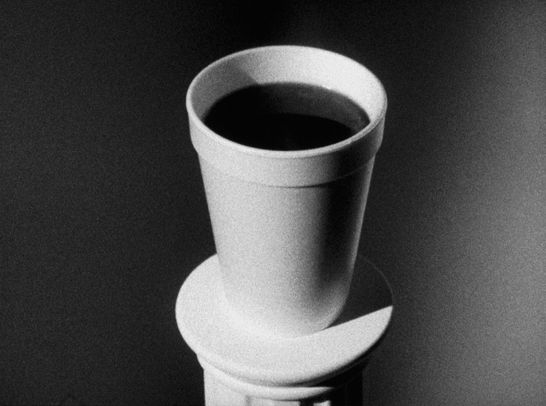 © Automatic MovingDecember 2020
© Automatic MovingDecember 2020
‘Things Things Say’: ‘This Action Lies’December 2020: ‘Things Things Say’: ‘This Action Lies’
“One Taste and You’ll Understand. That was Dunkin’ Donuts slogan in 2001. A year earlier: Loosen Up a Little. Then a bit later: Just the Thing. 2002–2004. Bring Yourself Back. 2004–2006. Now it’s America Runs on Dunkin’, but you get the point. They knew what they were doing for years. It wasn’t a lie, just... an understanding. They knew that you knew that there was a difference... between looking at something, and knowing it. You really think that if you stare at something long enough, it’ll reveal its secrets? Its history, its motivations, its fundamental interiority? You really think something’s gonna give up its reality just because you got a staring problem? Think about it.”
Featured in the Latitudes-curated exhibition Things Things Say at Fabra i Coats: Contemporary Art Centre of Barcelona until 17 January 2021, James N. Kienitz Wilkins’ This Action Lies (2018) is a remarkable 32 min film composed of three static shots and a fast-paced voiceover centring on an apparently unremarkable industrial product—a white foam coffee cup from Dunkin’ Donuts.
Multiplying matter-of-fact observations about the history of the coffee chain and the circumstances of the film’s production with reflections on veracity and trust, the intense focus on the representation of the cup overflows with diversions and doubts.
Unlike the post-hippie capitalism and European lifestyle pretensions of coffee companies like Starbucks, Dunkin’ Donuts built its brand on the identity of the hot drink as a utilitarian fuel for proud American workers. The beverage container in This Action Lies is not only evidence of a patriotic, cheap, and appealing way to power productivity; it also stimulates humorous and introspective rumination on the fundamental nature of faith, hope, life, self-image, and the value of making analog films. -
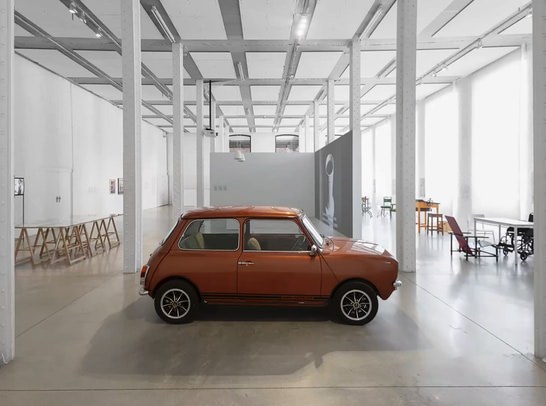 Photo: Eva CarasolNovember 2020
Photo: Eva CarasolNovember 2020
‘Things Things Say’: Stuart Whipps’ MiniNovember 2020: ‘Things Things Say’: Stuart Whipps’ Mini
“Another car strike. Marvellous, isn’t it? The taxpayers pay ’em millions each year, they get the money, go on strike. It’s called socialism. If they don’t like making cars, why don’t they get themselves another bloody job—designing cathedrals or composing violin concertos. The British Leyland Concerto—in four movements, all of them slow, with a four-hour tea-break in between...”
Basil Fawlty (played by John Cleese) rails against striking car workers in “The Kipper and the Corpse”, the fourth episode of the second series of the classic British sitcom Fawlty Towers, first broadcast on 12 March 1979. His rant spoke directly to the huge British Leyland industrial complex at Longbridge, in Birmingham, UK, which by then had produced more than 4 million units of the iconic economy car known as the Mini.
British Leyland had been nationalised in 1975, and was infamous for the ongoing strikes which frequently brought car production to a halt at Longbridge. Workers were often the target of jokes such as Fawlty’s. Union leaders were ridiculed in the right-wing press. The labour reforms that followed the election of Margaret Thatcher as Prime Minister in 1979 were a tumultuous turning point in the imposition of neoliberalism in the UK. Having dominated the social and economic identity of south Birmingham for almost exactly 100 years, Longbridge went into administration in 2005 with the loss of more than 5,000 jobs.
In 2014, Birmingham-based artist Stuart Whipps acquired a rusting chassis of a 1979 British Leyland Mini 1275 GT in order to try and further understand the broader lessons of the demise of Longbridge through a narrow focus on the slow process of learning to restore a single Mini made in a pivotal year. The project is titled The Kipper and the Corpse and is dedicated to the memory of Keith Woodfield, a retired British Leyland employee whose engineering expertise and stories became integral to the project.
Stuart’s project features in the group exhibition Things Things Say, curated by Latitudes, currently on view at Fabra i Coats: Contemporary Art Centre of Barcelona until 17 January 2021. -
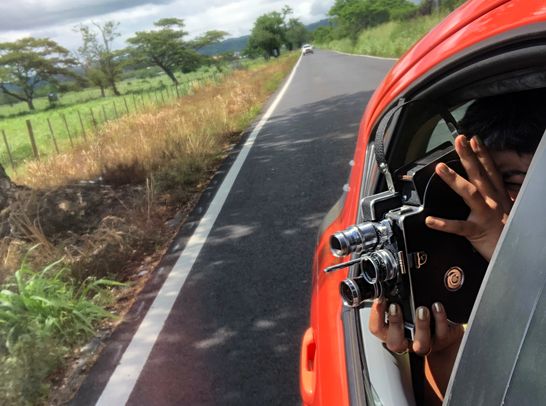 Photo: Marina Reyes FrancoOctober 2020
Photo: Marina Reyes FrancoOctober 2020
Incidents (of Travel) Cabo Rojo, Puerto RicoOctober 2020: Incidents (of Travel) Cabo Rojo, Puerto Rico
Cabo Rojo and the south-westernmost part of Puerto Rico wasn’t the first area that artist Sofía Gallisá Muriente and Marina Reyes Franco, Curator at the Museo de Arte Contemporáneo de Puerto Rico (MAC), spoke about exploring for the latest, and 13th, episode of Incidents (of Travel).
As Marina writes: “Originally, I was interested in what Sofía could show me around Levittown, a mid-century housing development where her grandmother had lived, and the new work she was filming using 16mm film that has been rotting since Hurricane Maria. ‘It is an area full of symbols of the collapse of the Commonwealth’, she told me, knowing I’d love it. (The country’s official name is Commonwealth of Puerto Rico.) Naturally, Covid-19 had other plans, but the theme of the collapse of the colonial order that our political system represents remained. We made up lists of possible places that symbolise this and enumerated them over several emails and texts. What’s really rotting away, what’s captured on celluloid or the celluloid itself? When the opportunity arose to stay in a rented house in Cabo Rojo, I jumped for joy and made a whole weekend out of it with my partner Oswaldo and our friend José.”
Continue reading Marina’s evocative account of her day with Sofía, and see their wonderful photos and videos, at incidents.kadist.org -
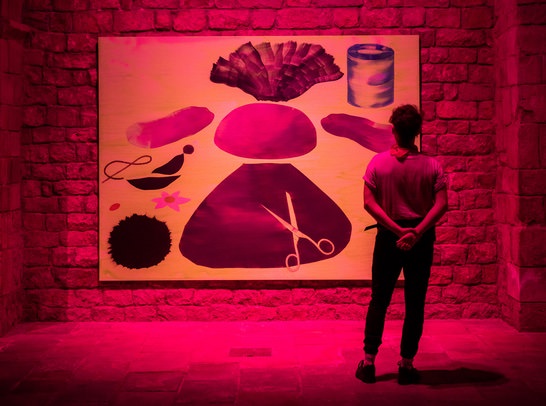 Photo: Pep Herrero / La CapellaSeptember 2020
Photo: Pep Herrero / La CapellaSeptember 2020
States of emergency—Lola Lasurt’s ‘Children’s Game’September 2020: States of emergency—Lola Lasurt’s ‘Children’s Game’
Lola Lasurt’s exhibition Joc d'infants (Children’s Game) looks back more than fifty years to the first contemporary art event hosted in the same venue where it is now taking place—until 27 September. Now known as La Capella, the venue is the main exhibition space of Barcelona Producció, the grants initiative of the Barcelona Culture Institute, and a programme that Latitudes has been mentoring since 2016 (2017 and 2019–20 editions).
That first exhibition was staged between November 1968 and January 1969: a retrospective dedicated to the Catalan artist Joan Miró (1893-1983). Almost 400 works were exhibited throughout the former Hospital de la Santa Creu, with 15 recent pieces displayed in La Capella itself. The day after the Miró exhibition ended, the death in Madrid of antifascist law student Enrique Ruano sparked unrest, which served as an excuse for the Franco dictatorship to declare a state of emergency. During this two-month suspension of civic norms, the rule of law, and press freedoms, critical imagery and reporting was conspicuous by its absence.
Lola’s large paintings appropriate articles that appeared in national newspapers during this time of suppressed turmoil—faits divers, often related to infancy. The work seen in this month’s Cover Story is based on a clipping showing how to make a toy animal from felt and rafia. Each of the paintings borrow the format of one of Miró’s La Capella paintings, and together they participate in an experiment in colour which triggers visitors to sense ‘absent colours’—hues between the fluorescent green of the canvases and the magenta of the illumination. -
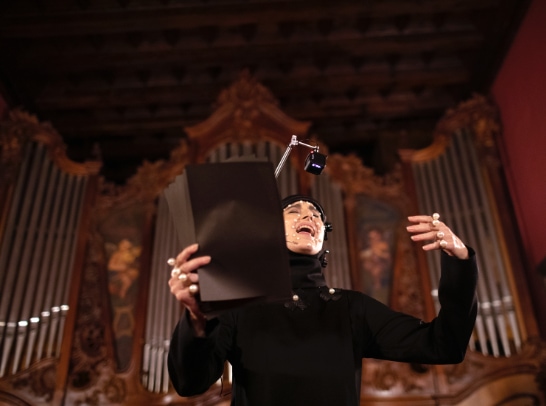 © Joan Morey. Photo: Noemi JariodAugust 2020
© Joan Morey. Photo: Noemi JariodAugust 2020
‘Màquina possible’—going viral at Can BalaguerAugust 2020: ‘Màquina possible’—going viral at Can Balaguer
Joan Morey’s COL·LAPSE. Màquina possible (COLLAPSE. Possible machine) took place on 23 July in Palma de Mallorca. Conceived for two bodies, a single voice, and live organ accompaniment, the performance was an adaptation of the prologue and first act of TOUR DE FORCE (2017). A small audience was confined in the rooms of the Can Balaguer, including its grand music room, with two of the original performers. Surrounded by sumptuous textiles and baroque furniture and with a motion capture camera attached to her head, the lead actress embodied HIV/AIDS, the virus and disease. Her monologue was based on two texts by playwright Antonin Artaud in which he confronted the total breakdown of his physical and psychological unity. Decades before the outbreaks of HIV or Covid-19, Artaud would have understood intuitively the viscerally productive ritual of impersonating a virus—something that is neither a living being nor a machine.
A curious aspect of Màquina possible within Morey’s career is that it is one of the only performances he has created for a domestic space. Morey’s previous site-specific projects have mainly focused on the power of classically modern institutions of social control and political normalisation: a chapel of a hospital, an anatomical amphitheatre, and a panoptic prison, among them. Despite its palatial splendour, Can Balaguer was a private home.
One of the key epidemiological and cultural features of the restrictions seen in Spain and many other countries during the peak of the Covid-19 crisis was that domestic space was revealed as a new area of biopolitical jurisdiction. During the confinement many people were forced, for the first time, to consume and produce in a way long familiar to artists and cultural producers: working from home. Moreover, with the collapse of wage labour together with domestic life, it could also be like living at work.
Conceived before the recent pandemic, then distorted by it, and finally adapted to it in the sinister wake of the ‘new normal’, Màquina possible was both a symptom, a prognosis, and a magnification of infectious agents that are too small to be seen. The performance was presented in the context of the exhibition COLLAPSE: Bachelor Machine, curated by Latitudes, which continues at Casal Solleric, Palma de Mallorca, until 6 September 2020. -
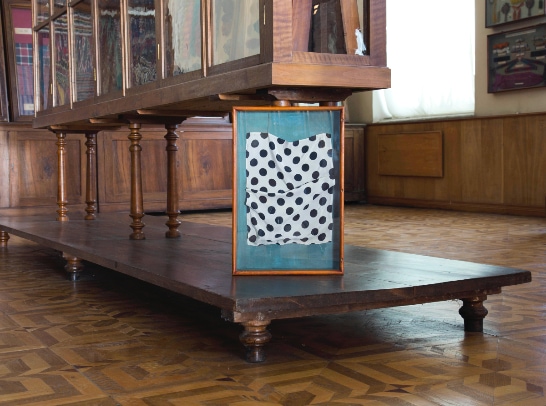 Courtesy: Nino Kvrivishvili. Photo: Guram KapanadzeJuly 2020
Courtesy: Nino Kvrivishvili. Photo: Guram KapanadzeJuly 2020
Nino Kvrivishvili’s silk roads: Incidents (of Travel), TbilisiJuly 2020: Nino Kvrivishvili’s silk roads: Incidents (of Travel), Tbilisi
Join curator Tara McDowell and artist Nino Kvrivishvili in the latest episode of Incidents (of Travel), from Tbilisi, Georgia. A spring itinerary through the city’s former silk industry and the heart of Nino’s practice, the tour took place via a screen in Australia as Georgia emerged from lockdown. The State Silk Museum, founded in 1887 by the biologist Nikolay Shavrov, was once part of a vast complex known as the Caucasian Sericulture Station. In 2016 Nino made an exhibition here among its display cases and its extraordinary collection of exquisite things: a wall of thousands of cocoons, decorated boxes made for silkworms as they journeyed along the Silk Road. She incorporated found and gifted Soviet-era silks, repositories of a deep knowledge now lost, like this polka-dot fabric work, titled Memory. The germ theory of disease arose from studying silkworms in the 19th century: somehow Tara and Nino stumble on a prehistory of the coronavirus, and the world is infinitely interconnected. -
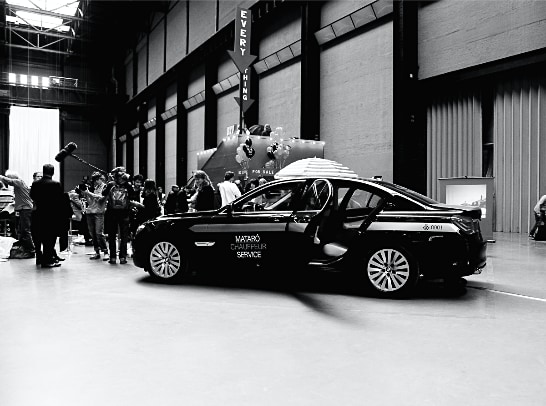 Photo: Tom MedwellJune 2020
Photo: Tom MedwellJune 2020
Mataró Chauffeur Service, since 2010June 2020: Mataró Chauffeur Service, since 2010
The premise was simple. Latitudes needed to get to Tate Modern and so Martí Anson was going to drive us to London and back. He would form a one-man one-car taxi company in his home town of Mataró, pick us up early in the morning in Barcelona and we’d head for the ferry. Mataró, Barcelona, Santander, Portsmouth, London, ‘No Soul for Sale’ festival, happy 10th birthday Tate Modern. Pim pam. His great-grandfather had been a taxi driver in Montevideo and his father-in-law a driver for the boss of Schweppes. Courteous and safe driving ran in the family, he told us. Barcelona had stolen the idea of black-and-yellow taxis from Mataró’s old cabs (he had the photo to prove it) so he would rob it back for his car service. BMW agreed to lend us a vehicle. We’d need something comfortable, they urged. A 7-Series with all the gadgets, they suggested. A big luxury limo. New car smell. And so Mataró Chauffeur Service went into gear and Martí took the higher road: black-and-gold. Designer livery and logo. Sharp uniform. Business cards, brochure. “Our driver is not only highly qualified but also polite, discreet and multilingual.” Intimidated, the Mataró taxi union lodged an official complaint. Thousands of kilometres away in Iceland, clouds of ash billowed from the Eyjafjallajökull volcano. Flights were grounded across much of northern Europe. Martí’s road and sea route suddenly seemed like a good idea. Now what side of the road do they drive on in the UK? -
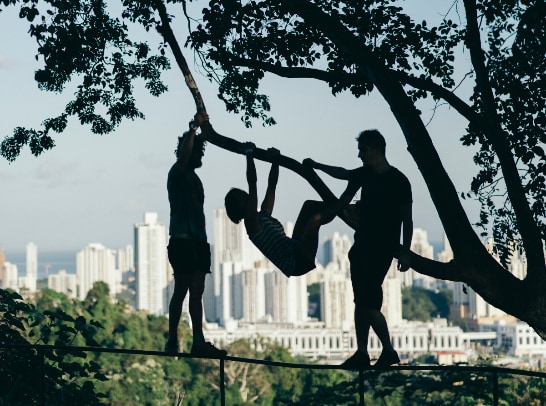 Sandino ScheideggerMay 2020
Sandino ScheideggerMay 2020
Panama, back through the lensMay 2020: Panama, back through the lens
“Panama is a country of many contrasts, bruised by a variety of social, political, and cultural crises”, writes curator Sandino Scheidegger in the latest edition of ‘Incidents (of Travel)’, in which he spent a day in January with the artists Donna Conlon & Jonathan Harker. “These tensions grow even stronger in its capital, Panama City, where an impressive skyline rises over an often struggling population below it.” Here high on a hill above the urban bustle, Jonathan, Donna, and Sandino clamber along railings and among branches in the Parque Metropolitano near where the duo shot the video ‘Capapults (Tapitapultas)’ (2012) – a slyly humorous take on military history, national identity, consumerism, and waste.
Each episode of ‘Incidents (of Travel)’ has always hinged on a peculiarly vicarious form of exploration. (Travelling, in parentheses.) These online glimpses of offline days have encompassed artistic and curatorial encounters in places as varied as Jinja, Suzhou, Yerevan, Buenos Aires, or, most recently, Rio de Janeiro. Yet in the last two months, with a third of the global population subject to some form of quarantine due to the coronavirus pandemic that still sweeps around the world, the notion of experiencing and imagining through others, through screens and at one remove, has taken on a new burden. Much of what we may once have taken for granted about art and artists, artworks and art workers, institutions, exhibitions, and so on, will have to be redefined as we face a “new normal” of physical distancing measures and social restrictions, alongside a continuing health crisis and a coming economic upheaval.
To too many of our questions, the answer is that it is too soon to say. Perhaps the only question should really be: How are you? Yet we wonder what perspective Jonathan and Donna now have on that day. What are their concerns in Panama City today, as the country now confronts a new bruise, a new crisis? We asked them.
They responded with these thoughtful words: “Crisis can be a lens. The grit and grime that were there all along are brought into focus. Panama was already defined by tensions of class and power inequality, consumption, and gentrification. Now the economic inequality is manifest in disparate disease rates in different neighbourhoods. Consumption and development have practically lulled to a stop, and while some in the middle are beguiled by naive ideas about the consequent environmental benefits, both ends of the unequal power pyramid we call normal are desperate to rev the engines of capitalism back up and peel rubber. The lens of disease sharpens the image that the city was already showing us in caricature: we are in the same storm on the same ocean, but riding in different boats.” -
 LatitudesMarch–April 2020
LatitudesMarch–April 2020
The Bolós CabinetMarch–April 2020: The Bolós Cabinet
‘To name, to own. Critique of taxonomic practice’: Agustín Ortiz Herrera’s current project focuses on the modern system of naming and classifying organisms which was first superimposed onto the natural world in 1735 with the advent of Carl Linnaeus’s Systema Naturae. Tutored by Latitudes as part of Barcelona Producció 2019–2020, Agustín’s research has to date involved visits to study centres in Uppsala and London, alongside investigations around the notion of ‘queering nature’.
Last month we visited the descendants of Francesc Bolós i Germà (1773–1844) in the Catalan town of Olot, in order to consult an important source of books by Linnaeus, yet moreover to visit the Bolós Cabinet of curiosities, the only known example in Europe of such a proto–museum which remains in its original location.
In the early 1800s, pharmacist Francesc Bolós began transforming the pages of his herbarium into three dimensions. A small room between his office and library, on the top floor of his home — and in the same 16th-century building as his apothecary — became Bolós’s medium for understanding and ordering the world. His penchant for botany and pressed plant specimens flourished into a thirst for other fields of knowledge: entomology, ornithology, ichthyology, palaeontology, mineralogy, conchology. Drawers, shelves, and pale-blue cabinets, filled with a growing hoard garnered through acquisitions and trades: pinned insects, bird skins and eggs, preserved fish, fossils, rocks, shells. He also accumulated coins, books, religious sculptures, antiquities, prints and drawings. The display included a fossilised mammoth molar from the Bianya valley, and showed important evidence about the extinct volcanoes nearby, while esteemed visitors included his friend the geologist Charles Lyell, who came to Olot in 1830.
This most curious of cabinets is not currently open to the public, yet discussions are ongoing between the family and the town council about how to preserve this unique example of site-specific curating, and the scientific impulses of its time, in its place. -
 incidents.kadist.orgFebruary 2020
incidents.kadist.orgFebruary 2020
Carioca IncidentsFebruary 2020: Carioca Incidents
“My idea is to take a stroll around the natural wonders of the city, its colonial past, imperial Brazil … and end on the beach.” Artist Daniel Steegmann Mangrané’s succinct recipe for the latest instalment of Incidents (of Travel), narrated by curator Catalina Lozano, led to a startlingly heady stew of a day in and around Rio de Janeiro. From the morning scent of tropical fruits at the Feira da Glória, through a family of coatis scampering through a sculpture garden, to the monolithic witness that is a six-hundred-year-old tree, Rio’s sensorium provoked a palpable “sense of collapse of our preconceived ideas about nature and culture.” An exploration of Daniel’s art through the unique context from which it emerged, and vice-versa. His encounter with Catalina’s curatorial research brings to life this tenth episode of the Latitudes-edited Kadist-produced series Incidents (of Travel) and is told through an evocative narrative blend of site descriptions, photographs, videos, and written commentary. Swiping and scrolling through the format’s redesigned interface, the screen evokes an experience of a Rio that “almost seems like an impossible place, a city founded in an exact orography where so many life forms coexist.” -
 Adrián Villar Rojas, Poems for Earthlings, 2019. Courtesy of the artist and Oude Kerk, Amsterdam. Photo: Jörg Baumann.January 2020
Adrián Villar Rojas, Poems for Earthlings, 2019. Courtesy of the artist and Oude Kerk, Amsterdam. Photo: Jörg Baumann.January 2020
Safeguarding GesturesJanuary 2020: Safeguarding Gestures
Poems for Earthlings, by Argentinian artist Adrián Villar Rojas, transforms the Oude Kerk, a monumental church in the heart of the Amsterdam’s Red-light District which dates back to 1306. Unveiled during the Amsterdam Art Weekend two months ago and continuing until April, Villar Rojas’s installation features in the recent art-agenda Roundup from the city by Latitudes’s Mariana Cánepa Luna.
“One of the most ambitious site-specific installations staged in the venue to date, Villar Rojas has surrounded its Gothic columns, oak choir stalls, and side doors with thousands of sandbags; blocked its large stained-glass windows with mattresses and beams; and lowered its chandeliers to the floor, where they sit in wooden trusses and are fitted with lit candles. The impression is of entering a time-capsule of past wars and conflicts, in which historically significant buildings and monuments were shielded from bombing and flooding—catastrophes present throughout much of Dutch history and, by implication, its future. The installation provides a haunting setting for the artist’s first audio piece: an eight-hour gathering of disparate sounds including the Big Bang, chimpanzees, parrots interacting with human voices, and pop songs, intended as a speculative soundscape history of humankind.”
The “safeguarding gestures” of Poems for Earthlings are one facet of the care and caring that Mariana detects throughout diverse exhibitions and presentations of the Weekend—including those at the Rijksakademie, GRIMM, rongwrong, Kunstverein, and the Stedelijk Museum. “Solidarity is crucial to art’s social nutrition”, she reflects. -
 Installation view of the exhibition, Edward Steichen’s Delphiniums, 1936. Photo: Edward Steichen. Copyright: The Museum of Modern Art, New York/Scala, Florence.December 2019
Installation view of the exhibition, Edward Steichen’s Delphiniums, 1936. Photo: Edward Steichen. Copyright: The Museum of Modern Art, New York/Scala, Florence.December 2019
Curating in the Web of LifeDecember 2019: Curating in the Web of Life
Last month Latitudes gave a lecture entitled “Curating in the web of life” at Garage Museum of Contemporary Art, Moscow, as part of the public program for the exhibition The Coming World: Ecology as the New Politics 2030–2100. The presentation argued that modern art and modernist art history largely imagined humanity and the humanities making their own history by themselves, while hiding the fact that their productions, relations, and economy were always teeming with biophysical processes. It hinged on Alfred H. Barr Jr.’s now-famous Diagram of the Stylistic Evolution of Art 1890-1935 which appeared on the cover of the catalogue accompanying the 1936 Museum of Modern Art, New York, exhibition Cubism and Abstract Art, and its lesser-known precursor The Tree of Modern Art — Planted 60 years ago by Miguel Covarrubias, which first appeared in Vanity Fair magazine in 1933. Following a sense of both humanity-in-nature and nature-in-humanity, the lecture called for an art history and a way of making exhibitions that is both outside-in and inside-out.
In 1936, the same year as Cubism and Abstract Art, the Museum of Modern Art, New York, also produced Edward Steichen’s Delphiniums, a week-long exhibition of flowers — “modern” flowers — hybrids and cultivars presented as the creations of the former chief photographer of Vogue and Vanity Fair. While MoMA recently unveiled a reset of its collection displays (finally discarding the movement-by-movement doctrine that was ingrained in the museum for decades) this curatorial curiosity reminds us that something far more radical is possible. The coming world calls for new language: the web of life; climate emergency rather than climate change; global heating rather than global warming, for example. Yet it also requires reconstructing and refreshing the theoretical model of the whole genre of the exhibition, its possibilities and conditions. It demands new kinds of institutions of art with a small a which definitively abandon the divide between the humanities and the natural world. -
 Institut Valencià d’Art Modern, 1989. Courtesy: IVAM. Photo: Juan García RosellNovember 2019
Institut Valencià d’Art Modern, 1989. Courtesy: IVAM. Photo: Juan García RosellNovember 2019
Fighting fires in Valencia: the 30-year story of the IVAMNovember 2019: Fighting fires in Valencia: the 30-year story of the IVAM
How does a museum recover from scandal? What imperatives exist for regional institutions outside of capitals? When, in 1989, the IVAM (Institut Valencià d’Art Modern) opened the doors to its imposing, new, slab-like building on the edge of what was once Valencia’s medieval walled core, it became the first public museum in Spain dedicated to collecting and exhibiting 20th-century art. Discussing IVAM’s rise, fall and reinvention, an article in the current frieze (issue 207 November–December) by Latitudes’s Max Andrews (also a frieze Contributing Editor) is a case study on how right-wing politics impacted an entire city art ecology. Also featured online, the text appears in print under the title “House on Fire” in reference not only to the destructive heat brought on IVAM by its director from 2004–14, the divisive Consuelo Císcar, but to Valencia’s fabled fallas festivities, and Salvar el foc (Save the Fire), the 2018 public sculpture and performance by Fermín Jiménez Landa which introduces the narrative. “After 30 years, the story of IVAM, seems inescapably haunted by the allegorical possibilities of the fallas, in which hubris and exuberant expenditure are sacrificed and careful craft is reduced to ashes, only to rise again.” -
 Mercedes Azpilicueta. Photo: Kush Badhwar / PUBLICSOctober 2019
Mercedes Azpilicueta. Photo: Kush Badhwar / PUBLICSOctober 2019
Mercedes Azpilicueta in HelsinkiOctober 2019: Mercedes Azpilicueta in Helsinki
“Buitre! burra! cabeza! cabezona! cabrona! cachivache! cachucha! cachufleta! cagada! cagadora! cagona! cajeta!…” Mercedes Azpilicueta’s performance Yegua-yeta-yuta (2015–ongoing) is a part scripted, part improvised litany of hundreds of pejorative, abusive, and vulgar insults directed at women in Argentina. Performed on the inauspicious date of Friday 13th September, it was Latitudes’s contribution to the collectively-curated and inaugural Today is Our Tomorrow festival initiated by PUBLICS at Club Kaiku and neighbouring venues in Helsinki, Finland.
Mercedes’s works have drawn inspiration from sources as diverse as Baroque painting, text messaging, medieval tapestries, street culture, and literary fiction, as well as singular figures including the Italian art critic and feminist activist Carla Lonzi (1931–1982), the Argentine-French performance artist Lea Lublin (1929–1999), the French futurist Valentine de Saint-Point (1875–1953), and the Costa Rican-born Mexican ranchera singer Chavela Vargas (1919–2012). In Helsinki her performance transformed the everyday language of misogyny and harassment into a kind of tragicomic exorcism. Many of the words derived from the street slang of Buenos Aires, especially lunfardo, a colloquial and cryptic dialect that first arose among working-class Italian-immigrant and tango communities in Argentina and Uruguay during the late 1800s. For example, yegua literally means a mare — a female horse, a slur for a “difficult” woman. A yeta is a person who brings bad luck, while a yuta is someone corrupt or unscrupulous. Accompanied by a new soundtrack produced for the occasion in collaboration with Chilean choreographer Rodrigo Sobarzo de Larraechea, Mercedes reclaimed the power to offend, distorting and distending the epithets into something powerful and playful rather than weak and degrading.
This month Mercedes opens Bestiario de Lengüitas (Bestiary of Tonguelets), curated by Virginie Bobin, at CentroCentro, Madrid, a solo exhibition that deals with the biocultural, biodigital and biophysical body, which will then tour to Museion, Bozen, and CAC Brétigny in 2020. -
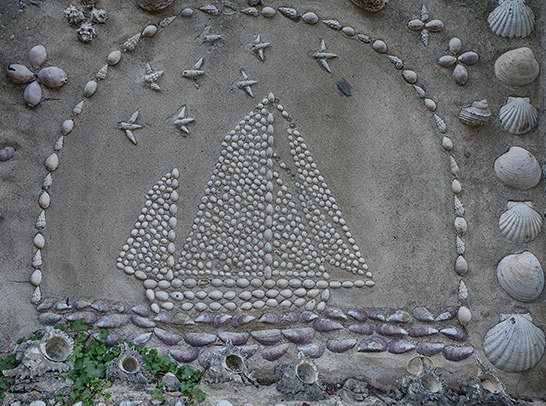 LatitudesSeptember 2019
LatitudesSeptember 2019
Polperro to DetroitSeptember 2019: Polperro to Detroit
In 1937 the retired sailor Samuel Puckey began transforming Peace Haven, his 19th-century fisherman’s cottage, into what would become known as The Shell House. Over the years Puckey used his collection of cowries, limpets, clams and other shells from around the world to embellished the façade with his maritime memories, including a depiction of the eminent Eddystone lighthouse. The Shell House is effectively a public art work (as well as being holiday cottage) in Polperro, an idyllic seaside village in Cornwall, England. Polperro once revolved around the vast shoals of pilchards that used to come into Cornish waters in late summer. The thriving fishing industry was the mainstay of the community, and the seine-netted and salted pilchards exported in their millions to Italy.
This month’s cover story tacks improbably from Polperro, where Latitudes passed through last month on its summer sojourn, to an American Rust Belt metropolis we will be visiting later this September as participants of the Red Bull Arts Global Curatorial Initiative: Detroit.
The threads that nevertheless connect such disparate scales and contexts both fray from stories of powerful world-historical and ecological forces bringing about the demise of single-industry economies. The collapse of Cornish pilchard fishing in the 1920s, and the erosion of car manufacturing in Detroit from its heyday in the early 1950s, are not exactly part of precisely the same narrative, yet the same inexorable desire to honour heritage and enrich communities through empowering simple materials and dwellings, nonetheless makes a strange and wonderful kinship between two post-industrial cultures.
Among Detroit’s landmark public art works and house museums, Tyree Guyton’s Heidelberg Project has been evolving since 1986 and Olayami Dabls’s MBad African Bead Museum since 2002. These projects are often awkwardly labelled outsider or intuitive art. Yet Juan Antonio Ramírez’s 2006 book on fantastical architecture in Spain coined a more joyously undisciplined term: escultecturas margivagantes. When we’re on the streets of Motor City the Michigan-infused “marginal-extravagant sculpturetectures” will doubtless ensure that Samuel Puckey’s marvel won’t be too far from our minds, with or without pilchards. -
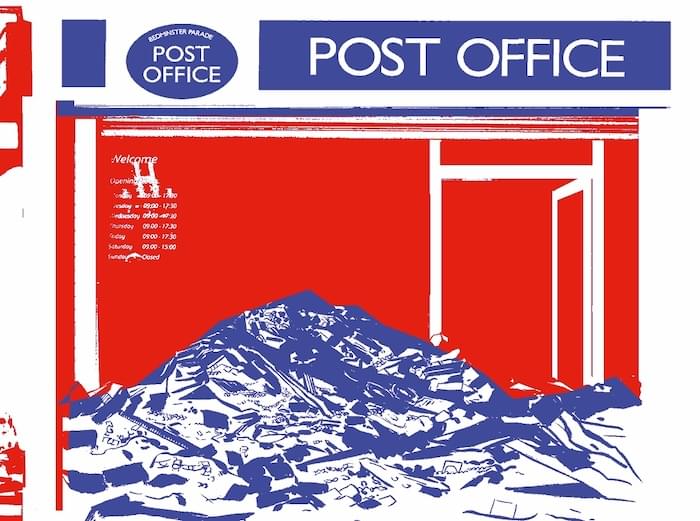 Francesc RuizSummer 2019
Francesc RuizSummer 2019
Francesc Ruiz’s Brexit Bristol sequel, ten years agoSummer 2019: Francesc Ruiz’s Brexit Bristol sequel, ten years ago
The British political system has collapsed… Once the high streets merely declined with their pound shops, gold traders, and bargain basements… Then they slumped as the "major downturn" began to bite… Yet as the economy finally plunged into the devastating recession, countless properties and businesses across the city of Bristol already lay in ruins… Widespread rioting and looting… Shortages of food and medicines… Spiralling inflation rates and a currency crash… The troops now struggle to enforce the state of emergency… The traitors flock to the southern ports, desperately seeking safe passage to Brussels…
Conceived a decade ago, Francesc Ruiz’s expanded comic-strip Untitled (Bristol) (2009) could now be imagined alongside such movie-trailer prose as part of a burgeoning new genre: satirical and dystopian fiction about Brexit Britain. These caustically red-white-and-blue drawings, excerpted here, were Francesc’s contribution to Sequelism Part 3: Possible, Probable, or Preferable Futures. Curated by Latitudes and Nav Haq at Bristol’s Arnolfini, this group exhibition around speculation and wishful thinking, futurology and premonition, opened ten years past this month. In Francesc’s installation the shopfront scenes wrapped around the stairwell at Arnolfini as if the panels of a comics page, creating a frieze of prescient disillusionment and destruction based on two high streets in the south of Bristol. Yet Sequelism did not pretend to prophecy the political weather; neither could it foresee the crisis faced by Arnolfini itself, as the art centre lost its core funding in 2017.
What would have appeared in 2009 in the crystal ball for Francesc’s art? The clouds are clearing ... Is that a pawn shop ... or a porn shop? An Institute of Porno Studies! A Norwegian fun house! It shall come to pass… -
 Lara Almarcegui / Photo: François-Xavier EmeryJune 2019
Lara Almarcegui / Photo: François-Xavier EmeryJune 2019
Thinking like a drainage basin: Lara Almarcegui’s ‘Concrete’June 2019: Thinking like a drainage basin: Lara Almarcegui’s ‘Concrete’
Lara Almarcegui’s current exhibition at the CAIRN art centre in Digne-les-Bains, southern France, focuses on the nearby Bléone river, its geology, and its exploitation. Latitudes has written an essay entitled ‘Thinking like a drainage basin’ for the accompanying catalogue. Lara’s project Béton (Concrete) has two parts. The first, seen here, involves the floor of the art centre being covered with crushed cement, gravel and sand. This raw material is the remains of several concrete structures — weirs — that were placed in the river in a failed attempt to stabilise a riverbed that had been extensively dug out over the preceding decades to produce gravel for the construction industry. The watercourse and its ecology is now being restored, and the weirs were recently removed.
The second part, the subject of Latitudes’s essay, entailed the calculation of the volume of each of the different rock types that make up the entire watershed of the same river. Roches et Materiaux du Bassin de la Bléone (2019) is presented at the CAIRN in the form of an inventory, as if a list of ingredients.
The essay is formed around the typographic and the stratigraphic, and how geological measurability made the early-modern world evermore legible to capital. “Only a cursory look at the history of geology reveals that although it may have prompted a nascent ecopoetics, it was also key to the creation of the illusion of the Earth as an infinitely exploitable resource. Geology triggered the externalising of non-human nature and the economising of the world.”
Latitudes has in the past worked with Lara on the publications Land, Art: A Cultural Ecology Handbook (2006) and ‘Ecology, Luxury & Degradation’ (2007) an issue of the magazine UOVO, the exhibition Greenwashing. Environment: Perils, Promises and Perplexities (2008), the public commissions Portscapes (2009), the monograph Lara Almarcegui. Projects 1995–2010 (2011), and the CAPC Bordeaux exhibition 4.543 billion. The matter of matter (2017-18). On 11 July this year, Latitudes’s Mariana Cánepa Luna will be in conversation with Lara on the occasion of her solo exhibition at the Institut Valencià d'Art Modern (IVAM), Valencia. -
 Photo: Mani Gatto, Courtesy Art Basel.May 2019
Photo: Mani Gatto, Courtesy Art Basel.May 2019
Buenos Aires in ParallelMay 2019: Buenos Aires in Parallel
Latitudes recently participated in the Parallel Rooms talks programme of Art Basel Cities: Buenos Aires. Developed in collaboration with the arteBA Fundación, and taking place during the arteBA art fair itself, these events transpired in four temporary domes that popped-up on the central showground of La Rural, a venue more used to hosting prize-winning cattle than forty-two curators, artists, and collectors.
Three rounds of four simultaneous talks saw Argentine cultural agents paired with international guests – who, alongside Latitudes, included Stuart Fallon (Talbot Rice Gallery), Richard Parry (Glasgow International), and Sandino Scheidegger (Random Institute). Latitudes’s Mariana Cánepa Luna was in conversation with Solana Molina Viamonte (cofounder of the exhibition space Móvil) and they wrestled with the subject of “Beyond the Museum: New Institutional Frames for Art”. Max Andrews debated the thorny topic “First Things First: Making Exhibitions for a General Audience” with independent curator Lara Marmor.
These talks were the culmination of the Buenos Aires Semana del Arte, and capped off an intense programme of museum, gallery, and studio visits in the city, which you can read more about on our blog. -
 Photo: Þorgerður Ólafsdóttir & Becky ForsytheMarch–April 2019
Photo: Þorgerður Ólafsdóttir & Becky ForsytheMarch–April 2019
Icelandic refractionMarch–April 2019: Icelandic refraction
It has been speculated that Icelandic spar was at one time used for navigational purposes,” reflects curator Becky Forsythe. Her account of a short Reykjavík day spent with artist Þorgerður Ólafsdóttir is the latest episode of Incidents (of Travel), the series edited by Latitudes and produced by Kadist.
Also known as sólarsteinn (sunstone) or silfurberg (silver rock), this transparent calcite crystal, “with its cloudy gem-like quality, could be used to locate the sun in the sky even when it was overcast or snowing.” Spar’s optical property of double refraction becomes a leitmotif for Becky and Þorgerður’s curatorial and artistic foraging, which encompasses a series of sites in and around Reykjavík marked by a similarly disconcerting double vision. The mineral’s ability to polarise and facilitate orientation in the landscape might suggest a simple lens through which to parse Iceland’s “geology, weather systems, symbols, and literature,” to split the natural from the man-made, the past from the present. Yet as the reportage travels in a race against the fading winter daylight — from the seaside remains of an ancient forest, to the red crater-like forms of a lava field, and the video-spectre of a now dormant geyser — this expanded studio visit deliberately looses itself in the complex tangle of human nature and natural history that can be encountered on such an otherworldly island.
The previous eight editions of Incidents (of Travel) have featured Buenos Aires, Argentina (Alejandra Aguado and Diego Bianchi); Hobart, Tasmania (Camila Marambio and Lucy Bleach); Yerevan, Armenia (Marianna Hovhannisyan and students of the Studio College, National Center of Aesthetics); Terengganu, Malaysia (Simon Soon and chi too); Lisbon, Portugal (Pedro de Llano and Luisa Cunha); Suzhou, China (Yu Ji and Xiao Kaiyu); Jinja, Uganda (Moses Serubi and Moshen Taha); and Chicago, United States (Yesomi Umolu and Harold Mendez). -
 Photo: © Joan Morey. Photo: Noemi JariodFebruary 2019
Photo: © Joan Morey. Photo: Noemi JariodFebruary 2019
Schizophrenic MachineFebruary 2019: Schizophrenic Machine
Schizophrenic machine, the concluding performance of the Latitudes-curated Joan Morey project COLLAPSE, took place on the freezing evening of 10 January. One hundred and thirteen pre-vetted audience members, each complying with a rigid all-black dress code, were driven by coach to the previously undisclosed location: the former La Model prison in Barcelona’s Eixample neighbourhood. More strictures were barked by a balaclava-clad doorman upon arrival: silence!, single file! No mobile phones, no bathrooms, no chance to leave. The reverberation of a door slamming. More than two hours in the darkness and cold.
Inaugurated in 1904 and closed as recently as 2017, La Model was a notorious centre for political repression and social control during the Franco dictatorship. Morey’s major new performance was his first with no leading human actors. Instead a cast of drones and a high-speed camera robot arm — together with recorded voices and music, blinding lights, and an architecture-scanning laser — were the technological interpreters that dramatised the foreboding architecture. Or rather, the building itself became the principal character as the spectator-captives were corralled from one scene to the next, kettled into and out of its different wings and its yard, returning each time to the central core of the correctional mechanism.
With its six radial arms and central surveillance tower, La Model embodies the principals of the panopticon. Devised in 1791 by the English philosopher and economist Jeremy Bentham, the panopticon typology produced a device whereby a single omnipresent guard could in principal observe all inmates at the same time. The architecture generated total control of the prisoners, and supposedly instigated their redemption, by inducing an incessant state of self-monitoring and automatically guaranteeing authority over privacy. Overwhelming and unrelenting, Schizophrenic machine was finally brought to an end with a deafening recording of the siren once used to signal prison lockdown. This had been only a temporary incarceration. -
 Photo: LatitudesJanuary 2019
Photo: LatitudesJanuary 2019
SeesawJanuary 2019: Seesaw
The exhibition “Te toca a tí” (It’s your turn) continues at EACC, Espai d’art contemporani de Castelló, Castellón de la Plana, until February 17th. Curated by Laura Vallés Vílchez (editor of the journal Concreta) it includes works by ten artists within a conceptual framework that asks how a gallery space can become a site of negotiation, process, reciprocity, and empathy. Mariana Cánepa Luna’s review of this optimistic show was recently published in Art Agenda. (As ever, Latitudes’s writing since 2005 is under “Writing” here, and includes further exhibition reviews, as well as artist profiles, catalogue essays and opinion columns.) January’s Cover Story features Luca Frei’s Simone Forti’s See Saw (2015) at EACC. First performed in 1960 by Yvonne Rainer and Robert Morris, See-Saw as been defined by Forti as both a performance and a sculpture realised according to given rules. As Mariana relates, at the opening of the exhibition, “Frei’s reactivation of Forti’s work began with performers carrying a plywood plank from one corner of the gallery to meet a wooden pivot located to the side. Once brought together, the sculptural elements form a seesaw. Three performers from a local theatre school variously climbed up and slid down the seesaw’s slanted surface, stood together at the centre while trying to find balance, and briskly but carefully levered each other’s bodies. With its deceptively simple choreography of negotiation, See-Saw embraces and battles with gravity’s inevitable grip on the fate of the performers’ encounter and the pace of their relationship to the object.” -
 Photo: Spitzmaus Mummy in a Coffin and Other Treasures © KHM-MuseumsverbandDecember 2018
Photo: Spitzmaus Mummy in a Coffin and Other Treasures © KHM-MuseumsverbandDecember 2018
Treasures! exhibitionism! showmanship!December 2018: Treasures! exhibitionism! showmanship!
A clutch of shows in Vienna (where Latitudes was recently a guest of Art Week) and Amsterdam (which just held its Art Weekend) offer a distinctive take on curatorial liberty and creative exhibition display.
Seen here in a beguiling exhibition view, Spitzmaus Mummy in a Coffin and Other Treasures was conceived by filmmaker Wes Anderson (the director of The Grand Budapest Hotel (2014) among other delights) and his partner, the costumier and illustrator Juman Malouf for the Kunsthistorisches Museum Wien. Its idiosyncratic selection of more than four hundred objects is drawn from all fourteen of the museum’s historical collections and spans some five thousand years. Flummoxing conventional curatorial rationales (and why else would the venerable Kunsthistorisches Museum have invited the duo if not to overstep orthodoxy?) one display revolves around the colour green and includes malachites from the minerals collection juxtaposed with portraits, an emerald dress, 2nd–3rd-century Roman glassware and Qing Dynasty Chinese porcelain. Elsewhere one could wonder at the embalmed shrew casket of the exhibition’s title, paintings of singular facial hair, or a sequence of 17th–18th century Italian busts arranged by size from diminutive to almost life-size and back again. Another section highlights special cases and storage made for particular objects (rather than the items themselves) including a box for precisely one hundred ostrich feathers.
Over at mumok, the display scenario of 55 Dates. Highlights from the mumok Collection (until February 3, 2019) is conceived by artist Hans Schabus. (In 2009–10, Hans was one of the participating artists in the Latitudes-curated Portscapes.) Using a type of readymade metal fencing commonly used to delimit outdoor worksites, he has devised an ingeniously irreverent system for presenting works—including those by Paul Klee, Giacomo Balla, Pablo Picasso, and Cosima von Bonin—which suggests that art history is always under construction, and urges that the boundaries between storage and gallery become less distinct. Also at mumok until February 3, Photo/Politics/Austria visualises Austrian social history by highlighting photographic images, often from the press, that witness key events from the last 100 years. An elegant exhibition architecture of staggered walls, floating vitrines, and false ceilings, in a palette of yellow, brown, and blue, was designed by the artist Markus Schinwald.
Meanwhile at Amsterdam’s Stedelijk Museum, Stedelijk Base is a collection display that will remain in place until 2022. It is the first time in the history of the museum that art and design have been integrated in such a thoroughgoing way. Conceived by AMO/Rem Koolhaas with Campus alumnus and Cookies co-founder Federico Martelli, it deploys a schema of thin metal partitions to create tightly-hung ‘islands’ of works-and-walls and sections which flow into each other.
In these refreshing examples it is significant that it is a filmmaker-designer, artists, and an architectural collaboration—in other words, agents external to the institution and who are apparently non-specialised in curating—who are given the licence to be bold with the dramaturgy of an exhibition and the staging of history. Academic plausibility or educational prudence understandably often trump cheekiness, surprise, or incongruity, as allowable museum strategies. For better or for worse, in-house museum staff are often deemed to be constrained, their roles defined by the ballast of professional reputation rather than by disruption, or chutzpah. Yet aside from the obvious pull of celebrity in the case of Anderson, and beyond myopic artist-as-curator debates, what is really to stop museums themselves from indulging in exhibitions that are more, well, exhibitionist, and shows with more showmanship? -
 Joan Morey. Photo: Noemi Jariod. Courtesy of the artist.November 2018
Joan Morey. Photo: Noemi Jariod. Courtesy of the artist.November 2018
Joan Morey—postmortem judgement reenactmentNovember 2018: Joan Morey—postmortem judgement reenactment
Joan Morey’s COLLAPSE is a three-part project curated by Latitudes. Six one-off performances are integral to the first, a survey exhibition at the Contemporary Art Centre of Barcelona — Fabra i Coats. Comprising reenactments of scenes excerpted from a selection of Morey’s projects from the last fifteen years exploring the use and misuse of control, these live-action fragments encompass dramatic orations, tableaux vivants, and ritualistic exercises following the artist’s rules.
The first took place on 27 September. POSTMORTEM. Pour en finir avec le jugement de Dieu (2006–07) was interpreted by the magnetic Sònia Gómez wearing a pair of loudspeakers that played extracts from Antonin Artaud’s reading of his notorious 1947 radio play To have done with the judgement of God. Artaud was commissioned by French Radio after he had spent almost a decade in various asylums. Shelved the day before its scheduled broadcast due to its violently scatological references, raw anti-religious content, and anti-American vitriol, the play was never aired. Artaud died the following year. In Gómez’s interpretation of Morey’s instructions, the human body became a crawling and indeterminate animal-thing, as if an arachnoid presence with a feline instinct. Burdened by devices which only served to amplify tortured words, mewls, and howls, the body prowled around the exhibition space, carrying Artaud’s screed with it and his voice’s constant evocation of bare emotions, obscenities, and the remaking of anatomy and autonomy.
The remaining three performance extracts take place on 15 November at 7pm (BAREBACK. Phenomenology of Communion, 2010. Interpreted by Manuel Segade); 29 November 2018 at 5pm (IL LINGUAGGIO DEL CORPO. Prologue), 2015–2016. Interpreted by Catalina Carrasco and Gaspar Morey); and 13 December at 7pm (TOUR DE FORCE. The Utopian Body, 2017. Interpreted by Eduard Escoffet).
The second part of COLLAPSE opens at the Centre d’Art Tecla Sala, L’Hospitalet de Llobregat on 23 November and is the definitive version of the touring exhibition Social Body. Titled Schizophrenic Machine, the third comprises a major new Joan Morey performance event that will take place in January 2019 at an especially resonant location – whose identity remains, for the time being, deliberately undisclosed. -
 Eulàlia Rovira and Adrian Schindler / LatitudesOctober 2018
Eulàlia Rovira and Adrian Schindler / LatitudesOctober 2018
I can’t take my eyes off you – Eulàlia Rovira and Adrian SchindlerOctober 2018: I can’t take my eyes off you – Eulàlia Rovira and Adrian Schindler
Eulàlia Rovira and Adrian Schindler’s new performance One motif says to the other: I can’t take my eyes off you took place on 14th September as part of the Latitudes-curated Cream cheese and pretty ribbons! at Galerie Martin Janda, Vienna, an exhibition that also features the talents of David Bestué, Sean Lynch, and Batia Suter. The exclamatory title of the exhibition (which continues until 13 October as part of the curated_by festival) synthesises two of the satirist Karl Kraus’s similes for what, writing in 1910, he considered the cultural polarity of monotonous functionality on the one hand and frivolous adornment on the other. Kraus lampooned both the sobriety of Germanic culture and the good taste of Romance culture, yet judged an even greater taboo was to be found in Vienna’s dressing up of the former with the latter.
Responding to this false dichotomy of formalism and ‘contentism’, Barcelona-based Eulàlia and Adrian developed a performance that comprised the speaking of memorised texts, the revealing and concealing of ‘tribal’ tattoo-like skin adornments, and the folding and tying of silk scarves. Each scarf bore a variation of the belt and buckle, chain and harness motifs typical of silk square designs by brands such as Hermès, whose origins lie in equestrianism. Tracing an extraordinary historical pattern of exaggerated display and normalised subjugation, the words of the performance wove around the mythologies and testimonies of four individuals. The striking likeness of Maori war leader Te Pēhi Kupe is known from portraits made in the 1820s in England, where he had come to appeal for weapons from George IV. An anonymous woman, once forced to pose for an identity card shot, was one of the thousands of Berber villagers documented in 1960 by the French military photographer Marc Garanger during the Algerian War. The orphaned Olive Oatman was adopted by the Mojave people in 1851 and marked on her chin with blue cactus tattoos in accordance with tribal custom. The heavily tattooed man known as Jeoly, forcibly brought to Europe from present-day North Sulawesi by buccaneer William Dampier in 1691, was exhibited as the ‘painted prince’ in a London tavern. As Eulàlia and Adrian knotted together these singular stories, the compilation of musical covers that they turned on-and-off between each reading began to lodge uninvited in the mind, “You’re just too good to be true, I can’t take my eyes off you...” -
 Harald Szeemann / LatitudesSeptember 2018
Harald Szeemann / LatitudesSeptember 2018
Harald Szeemann’s ‘Travel Sculpture’September 2018: Harald Szeemann’s ‘Travel Sculpture’
Summer vacations have a habit of turning into busman’s holidays in Latitudes’s agenda. Undoubtedly the Swiss curator phenomenon Harald Szeemann (1933–2005) also often sensed, or engineered, that trips for pleasure and travel for research and work would inevitably dovetail. Museum of Obsessions, a fascinating but flawed exhibition dedicated to his life and work has just closed at Kunsthalle Bern (it will tour to Kunsthalle Düsseldorf, Castello di Rivoli, and the Swiss Institute, New York). Among the ephemera, correspondence, artworks, and photographs that documented exhibitions such as Live in Your Head. When Attitudes Become Form (1968), Happening & Fluxus (1970) and The Bachelor Machines (1975) was a mass of luggage tags accumulated from more than fifty years of flights in and out of ZRH, GVA and BRN. Bar-code strips, gate-check dockets, and business-class labels, were peppered with the words “Priority”, “Rush”, and “Short Connection”. Credited as an artwork by Szeemann (Travel Sculpture, late 1960s–2004, mixed media) this bag-tag totem hung for many years in the Fabbrica Rosa, his archive and library in Maggia, Switzerland, before it was purchased by the Getty Research Institute along with more than 50,000 photographs, 22,000 artist files, and 25,000 books, and transported to Los Angeles. Travel Sculpture is an irrefutably uncomfortable object, a testament to frequent-flyer Szeemann’s curiosity, celebrity, and privileged right to roam, yet evidence of the relentless growth of air travel during his lifetime, and the climate peril of normalising hypermobility.
If it can be argued that excessive discretionary air travel damages not only the global atmosphere, but neighbourhoods and domestic space, then the full-scale reconstruction of the 1972 exhibition Grandfather: A Pioneer Like Us in its original location on Bern’s Gerechtigkeitsgasse, offered an unpretentious counterpoint to the ethical effects of so much globe spanning and networking. Following the conclusion of the mammoth exhibition documenta 5 in 1972, Szeemann found himself with no immediate work. He turned to the biography and belongings of his beloved granddad, Étienne Szeemann—a local hairdresser and wigmaker—to put together a remarkable, idiosyncratic, touching and humble exhibition in his own apartment. -
 Jonny Lyons / LatitudesAugust 2018
Jonny Lyons / LatitudesAugust 2018
Askeaton JoyrideAugust 2018: Askeaton Joyride
Strange and wonderful things happen in Askeaton—especially during each summer for the last thirteen years. Initiated by artists Michele Horrigan and Sean Lynch in 2006, the residency programme Welcome to the Neighbourhood hosts artists and curators in the midst of this small town community in County Limerick, Ireland, under the umbrella of Askeaton Contemporary Arts.
For the last two weeks, Latitudes joined artists Matt Calderwood, Jonny Lyons, Ruth Clinton and Niamh Moriarty, in investigating, celebrating, and dialoging with the rich social fabric of the town. Their projects were presented during the Open Day this past Saturday July 28.
At Askeaton Community Hall, Glasgow-based artist Jonny Lyons presented a video and sculpture (Joyride, 2018) which resulted from the uncanny vision on the River Deel that is August’s Cover Story. The river runs through the town past the Franciscan friary towards the Shannon estuary beyond, and one early morning last week it served as the setting for a card game. Jonny was struck by the vim and vigour of the card playing he witnessed at local watering hole Ranahan’s Bar. Recruited by Michele and her mother Anne, local card sharks Noel McCarthy, William Sheehan, James and Antoinette Fitzgerald, played a twenty-minute game of Forty-fives on a round table from Ranahan’s, in the middle of the river, at high tide. The pontoon that floated their game was constructed thanks to the amazing ACA production team: Carl Doran, Ray Griffin, and Rory Prout.
Meanwhile, Latitudes’ contribution was triggered by a clue which led to an unexpected connection between Barcelona and Askeaton. It was a starting point rather than a conclusion. A textual splinter that is now pointing us towards future research around the navigators, pirates, traders, religions, and economies which linked Ireland with the Atlantic and western-Mediterranean sea-lanes during the last centuries.
Written in stone at the cloister of the friary (the ruin in the background of this photo) can be read: “Beneath lies the Pilgrim’s body, who died January 17, 1784”. A recording was made of the irrepressible Carl Doran reading a write-up from the ABC News, the town’s annual journal. The Pilgrim tells of young love, clandestine marriage, and a blood-hunt that led a merchant from Barcelona to live out his days in penance in Askeaton. Meanwhile, if you fancy a game of cards, Jonny might be your joker. -
 X InitiativeJuly 2018
X InitiativeJuly 2018
No Burgers for SaleJuly 2018: No Burgers for Sale
In 1983, a Burger King opened on New York’s Governors Island, then a U.S. Coast Guard base. It was the first franchise to serve beer. After scoffing a Whopper combo, officers and enlisted men could enjoy a round of golf, play bingo, go to the movies, or throw balls at the adjacent bowling alley. In 1999, this Burger King featured in issue 615 of ‘The Amazing Spider-man’. After almost two centuries operating as a federal or military facility, the Island was vacated in 1996, and the Burger King shut up shop. The remnants were photographed in 2003 by Andrew Moore and Lisa Kereszi.
In summer 2009, No Soul for Sale – A Festival of Independents brought together more than thirty non-profit centres, collectives and independent institutions from all over the world to the X Initiative headquarters on 548 West 22nd Street – the Chelsea HQ of Dia Art Foundation from 1987 to 2004. At the invitation of the organisers to use the allocated 25m2 given to each of the organisations, Latitudes reached out to New York-based artist group The Bruce High Quality Foundation. The idea was to be ‘out of the office’, but in a surrogate one. The ‘Bruces’ had discovered the Governors Island Burger King in ruins while scouting locations for their zombie movie Isle of the Dead – a commission they were making at the time for Creative Time.
So it came to pass that for five days in June 2009, Latitudes’ daily operations were temporarily transferred to the skeleton of this unique fast-food time capsule. The booths served as a meeting point (plus the festival had nowhere else to sit) and the formica tables and fried-chicken displays, places to chew over publications, and ‘reheat’ documentation and other residues from Latitudes’ projects since 2005. It was also an opportunity to present Portscapes, the project Latitudes was working on at the time in the Port of Rotterdam, and to premiere 6 Hours Tide Object with Correction of Perspective (1969/2009) by Dutch artist Jan Dibbets, its inaugural project.
A year later, a second edition of No Soul for Sale took place to commemorate Tate Modern’s 10th anniversary. Given this new challenge to travel to London, Catalan artist Martí Anson became Latitudes’s chauffeur, driving us to London and back. But that’s another story! -
 LatitudesJune 2018
LatitudesJune 2018
Near-Future Artworlds Curatorial Disruption Foresight GroupJune 2018: Near-Future Artworlds Curatorial Disruption Foresight Group
Sporadically convened by Latitudes, the Near-Future Artworlds Curatorial Disruption Foresight Group is a forum for informal dialogue about megatrends and the future of contemporary art institutions.
In order to be conducive to freedom of interaction, these by-invitation, closed-door meetings have been held under the Chatham House Rule. The list of attendees is not circulated beyond those participating in the meeting, and no documentation is made. Participants are free to use the information received, but neither the identity nor the affiliation of the speakers, nor that of any other participant, may be revealed. This allows participants to express personal views, to listen, reflect and gather insights with a clear distinction from the position of their employers or associated organizations. No resolutions are issued, no votes are undertaken, and no policy statements are proposed.
The first meeting took place as part of the Vessel / MADA (Monash Art Design and Architecture) International Curatorial Retreat in Bari, Italy, in May 2015. Through the lens of curatorial writing and a skeptical take on the notion of the Global South, it aimed to operate in the realm of “art-fiction”, of desirable or dystopian phenomena, speculative objects and art world services including art-institution-like structures and art-magazine-like formats.
With an emphasis on cross-pollination between design thinking and curatorial thinking, the second meeting – a glimpse of which is this month’s cover story – was convened in San Francisco in August 2015 at the invitation of Kadist. On this occasion, the meeting brought together individuals and expertise from the Bay Area with an active interest in institutional prototyping and emergent usership to discuss, among other things, the notion of the post-disciplinary, and the question of appropriate speeds or periodicities of institutions.
The most recent session took place in November 2015 at Eastside Projects, Birmingham, UK. It collectively imagined a post-apocalyptic scenario in which a city art ecology had to be regrown from the ground up. What would be most urgent priorities in terms of organisation, facilities, tools?
The Near-Future Artworlds Curatorial Disruption Foresight Group remains poised to address critical global, regional and country-specific challenges and opportunities. -
 Roman OndákMay 2018
Roman OndákMay 2018
Shadowing Roman OndákMay 2018: Shadowing Roman Ondák
This month we revisit Roman Ondák’s exhibition ‘Some Thing’ at The Common Guild, Glasgow, in 2013, during which Latitudes was invited to give a talk. Roman’s show comprised a series of composite works in display cases. Early still-life paintings and pencil drawings from his student days in Slovakia in the 1980s were coupled with the actual objects depicted – a chair, a length of rope, a helmet, a vase (a detail of Shadow, 1981/2013 is the work above), and so on, which were placed in a deadpan way on top of them.
Both these unremarkable everyday objects and youthful Roman’s callow, even obsolete, attempts to embellish them into tasteful high art together became new exhibits. Reframed within something more like a museological overview, the new hybrid works were a very plausible form of parody. A wry riddle about reality and its representation. An apparent self-depreciating satire around the frivolity, narcissism and persistence of the still-life genre, reprising the Romantic mythology of the expressive realist artist. And on the other hand, a caricature of Conceptual art’s bad reputation for dryness, humourlessness and highfalutin philosophical laboriousness!
Roman’s exhibition had some very thoughtful fun by redoubling a realisation that art is no longer merely a fixed quality of objects or representations, but a distinctly changeable and very volatile effect that can be produced – and withdrawn. -
 Michael RakowitzApril 2018
Michael RakowitzApril 2018
Dates, 700 BC to the present: Michael RakowitzApril 2018: Dates, 700 BC to the present: Michael Rakowitz
As Michael Rakowitz’s fourth plinth commission is unveiled in London’s Trafalgar Square, this month’s cover story image revisits Return (2004-ongoing) a related project by the artist that also speaks about the turbulent history of Iraq. And dates. In London, Michael has deployed thousands of date syrup cans to make a 1:1 scale recreation of Lamassu, the fantastic winged bull that graced the gates of the city of Nineveh from 700 BC until it was destroyed by Isis in 2015.
As part of a project organised by Creative Time in 2006, the artist reopened his grandfather’s New York import-export store. (His ancestors were exiled from Iraq in 1946 and settled in the United States.) Overcoming bureaucracy and prejudice, the plan was to bring Iraqi dates to the US for the first time in over forty years. Michael took the time to make an extensive and insightful interview with Peter Eleey, now curator at MoMA Ps1, as part of UOVO 14 (titled ‘Ecology, Luxury & Degradation’), the journal issue that Latitudes guest edited in summer 2007. The store initially opened selling Californian dates derived from Iraqi seed, a box of which we see in all their plumpness in this image. Yet as the artist recalls in the interview, after many administrative hurdles he eventually “received four different types: Azraq, Ashrase, Ibraheme, and Kheyara, which was voted the best date in all of Iraq in 2005... I can attest, without any emotional bias, that these dates were the best I had ever tasted in my life... The dates suddenly became a surrogate, traveling the same path as Iraqi refugees”. You can read the full interview here.
Michael also spoke about this endeavour, as well as The Invisible Enemy Should Not Exist, the project of which the London monument is the latest chapter, in a seminar he led during the symposium Latitudes put together for the 8th Sharjah Biennial in April 2007. There is a saying that every Iraqi has a date in their genes. With its date palm industry as well as its ancient cultural treasures decimated by conflict, Iraq imparts a bitter-sweet taste to Michael’s compelling work. -
 Armine Hovhannisyan, Vardan Kilichyan and Anaida VerdyanMarch 2018
Armine Hovhannisyan, Vardan Kilichyan and Anaida VerdyanMarch 2018
Armenia’s ghost galleriesMarch 2018: Armenia’s ghost galleries
Incidents (of Travel) – Latitudes collaboration with Kadist – returns with a dispatch from Yerevan, Armenia. The itinerary leads us on something of a ghost tour. Photographs and reportage unearth the fragmented memories of galleries and art spaces that no longer exist. This haunted dispatch is the fruit of two-years of meticulous shared inquiry by curator Marianna Hovhannisyan (currently based in San Diego) with Vardan Kilichyan, Gohar Hosyan, and Anaida Verdyan, alumni of the former Studio College of the National Center of Aesthetics in Yerevan.
The sturdy wooden doors that initiate the story were once the entrance to the Ex-Voto Gallery. From 1994–1996 it was a focal point for Armenian contemporary artists associated with the generation of the Independence period. Among the other sites, we learn of the former Hay Art cultural center. The 1970 building it inhabited from 1997–2007 is shaped like five enormous barrels, and was later used as a reptile house. At 28 Amiryan Street, there is now a yoga studio. Yet this was formerly akanart Gallery, a dynamic hub for critical practice that involved many thinkers from the Armenian diaspora.
Marianna, Vardan, Gohar, and Anaida tell us that these closures and once “forgotten pieces of art histories” are a testament to neoliberal economic policies put in place since the independence of Armenia from the Soviet Union in 1991, and the ongoing disinterest of the state in supporting contemporary art. Each of the tenacious initiatives that they researched depended on friendship, personal sacrifice and the enthusiasm of the art community.
Incidents (of Travel) explores the chartered day-long travel itinerary as a format of artistic encounter and an extended conversation between curators and artists. An expanded phase of a project devised by Latitudes in 2012, the online iterations are conceived through offline fieldwork and as expanded studio visits. Previous editions have reported from Chicago, USA; Jinja, Uganda; Suzhou, China; Lisbon, Portugal; Terengganu, Malaysia. -
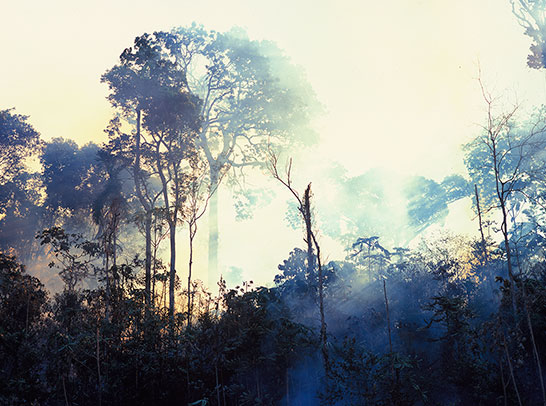 Sergio Vega / Umberto di Marino Arte ContemporaneaFebruary 2018
Sergio Vega / Umberto di Marino Arte ContemporaneaFebruary 2018
Paradise, Promises and PerplexitiesFebruary 2018: Paradise, Promises and Perplexities
This month marks ten years since the opening of Greenwashing, curated by Latitudes and Ilaria Bonacossa. Subtitled Environment: Perils, Promises and Perplexities, this exhibition at the Fondazione Sandretto Re Rebaudengo, Turin, addressed the melding of corporate agendas and individual ethics in the wake of the exhaustion of traditional environmentalism.
One of the twenty-five artists featured in the exhibition, Sergio Vega has frequently engaged in interdisciplinary research around the notion and location of paradise. Following the writings of 16th and 17th-century historian-explorers such as Antonio de León Pinelo, Sergio has traced how the imaginary life and iconography of Judeo-Christian religions was nourished. The locus of the ultimately pleasurable yet lost paradise was traditionally located in the so-called New World, more or less at the centre of the South American continent, in the vast area today encompassing the Brazilian state of Mato Grosso.
Paradise on Fire (2007) comprised a video shot by Sergio in the Chiquitano dry forests, a biologically rich eco-region which straddles the Brazil-Bolivia border. A companion series of photographs taken near the city of Alta Floresta were also included in Greenwashing, one of which is seen here. In these areas, swathes of virgin forest had been recently burnt to grow soy, sugar cane, cotton and to ranch cattle. Gas pipeline corridors built by multinational energy companies, such as Enron and Shell, had cut through the ancestral lands of indigenous family farming communities. The ‘garden of Eden’ was an increasingly industrialised landscape wrecked by power and material demand, and, in the bitterest of ironies, driven by the growing biofuel market.
This photograph record the distressingly beautiful visual side-effects of this unrestricted destruction. In the words of the artist—who has also featured in Latitudes projects in the context of the 2007 Sharjah Biennial, the journal UOVO, and The Last Newspaper—“the images propose a rather perverse aesthetic pleasure (versus the romantic and sublime appreciation of nature). Here we see clouds of smoke against the light and the silhouette of trees and plants appearing and disappearing ambiguously, as if it were the morning mist in the creation of Eden. The only difference is that this time, the mist has blue and red tones, if you look carefully you will see branches and trunks smouldering. What appears to be dirt attached to the negative is in fact burning leaves that blew with the smoke and turned into cinders. The photos show a landscape where the vegetation acquires the phantom and metaphorical presence of its own disappearance.” -
 Camille Orny and Magda VazJanuary 2018
Camille Orny and Magda VazJanuary 2018
Artengo, I’ll be there for youJanuary 2018: Artengo, I’ll be there for you
Camille Orny and Magda Vaz’s exhibition for the Sala Petita of Barcelona’s La Capella will open on 23 January—it is the last of three projects that Latitudes is mentoring during the current season of the Barcelona Producció grants.
Artengo2000 is a perverse miniseries, a six part drama-documentary based around a group of five flatmates—including semi-fictionalized versions of Camille and Magda—who have struck a sponsorship deal with a corporation known as Artengo. In one reality Artengo is a sub-brand of the sporting goods retailer Decathlon dedicated to racket sports, yet in another reality, it is an arcane Russian-American multinational corporation. Artengo2000 is set in a familiar but twisted near future in which gig economies, collaborative work and service sharing have developed in even more bizarre ways. The series begins with a dream about Artengo-branded socks that the flatmates have agreed to wear at all times as part of a whole-life branding deal. Yet what unfolds in the Artengo apartment never really wakes from this precarious half-conscious state. The episodes develop into a lo-fi, miscreant version of the flat-sharing television series Friends in which the spiritual strife and psychic disorders caused by shared living and brand obedience have left little room for I’ll-be-there-for-you buddy adventures. -
 Rayyane Tabet, Alessandro Balteo-Yazbeck & Media Farzin, Martín Llavaneras. Photo: Frédéric Deval / Archives du CAPC musée d'art contemporain de Bordeaux / © Mairie de BordeauxDecember 2017
Rayyane Tabet, Alessandro Balteo-Yazbeck & Media Farzin, Martín Llavaneras. Photo: Frédéric Deval / Archives du CAPC musée d'art contemporain de Bordeaux / © Mairie de BordeauxDecember 2017
Tabet’s Tapline trajectoryDecember 2017: Tabet’s Tapline trajectory
Rayyane Tabet’s Steel Rings and the mobile Three Logos (both 2013) slice through and loom over the web of natural histories and human natures, mineral agency and political ecology that comprises the exhibition 4.543 billion. The matter of matter. Rayyane was one of the first artists to come on board what would become this Latitudes-curated exhibition at CAPC Bordeaux. And as the show approaches the end of its journey—it finishes on 7 January 2018—it seems appropriate that this month’s cover story creates a bookend of sorts. Moreover, it gives a perfect reason to mention Rayyane’s stunning exhibition Fragments that has recently opened at Hamburg Kunstverein.
Seen in this installation view with works by Alessandro Balteo-Yazbeck & Media Farzin on the wall to the left, and Martín Llavaneras on the floor, Steel Rings and Three Logos address the story of the Trans-Arabian Pipe Line (Tapline for short). The pipeline was conceived as a faster, cheaper, and safer alternative to the export of Saudi Arabian oil by ship. Its origins lay in US efforts to replace the enormous drain on its reserves in ‘oiling’ the second world war. The Tapline was constructed between 1947 and 1950 as a joint venture of Standard Oil of New Jersey, the Socony-Vacuum Oil Company (both now merged into ExxonMobil), the Texas Company, and Standard Oil of California (now Texaco and its parent company Chevron, respectively). The pipeline was planned to run in a direct line from the Abqaiq oil field to Haifa, then in British-administered Palestine. Yet as the disputed 1947 United Nations Partition Plan divided Palestine into Arab and Israeli sections, a diversion had to be made in the route. The final stretch of the 1214 km line thus headed off at an angle through Jordan and Syria, and terminated in southern Lebanon. Oil exports flowed from 1950 until the Lebanese Civil War broke out in 1975. The Tapline later supplied oil exclusively to Jordan until Saudi Arabia stopped the agreement in 1990 in response to Jordanian support for Iraq during the first Gulf War. The pipeline has lain dormant ever since.
Rayyane tackles the pipeline as a form of line drawing, distilling his exhaustive research into its history to focus on the abstract and geometric qualities of a remarkable feat of engineering and logistics. His primary interest lies in the Tapline’s route as a cartographic vector, and the physical presence of a thirty-inch tube of steel that cuts through five political entities. The steel rings replicate the scale of the pipeline in section. Each ring is engraved with the longitude, latitude and elevation corresponding to a kilometre-marker of the pipeline’s path. Three Logos evokes the numerous mergers and rebrandings of the American corporations involved. The blue oval of the Esso logo (originally a brand of Standard Oil), intertwines with the red star of Texaco and the winged horse of Mobil. -
 Photo: Ângela Ferreira / Paul ParsonsNovember 2017
Photo: Ângela Ferreira / Paul ParsonsNovember 2017
Mining negative monuments: Ângela Ferreira, Stone Free, and The Return of the EarthNovember 2017: Mining negative monuments: Ângela Ferreira, Stone Free, and The Return of the Earth
On 15 November the study day The Return of the Earth: Ecologising art history in the Anthropocene takes place at the CAPC musée d’art contemporain Bordeaux in conjunction with the Latitudes-curated exhibition 4.543 billion. The matter of matter. With a keynote by science historian Jean-Baptiste Fressoz, and a conversation between artists Xavier Ribas and Ângela Ferreira—the latter both featured in the exhibition—the event will intertwine discussions of art practice and historical research, with environmental and geological narratives, and vice versa.
Ângela’s project Stone Free is so-called in reference to the 1966 hit song performed by Jimi Hendrix. Stone Free creates correspondences between two voids below the ground, two “negative monuments” as the artist has termed them: Chislehurst Caves, in southeast London, and Cullinan Diamond Mine in Gauteng Province, South Africa. The latter pit is pictured here in an arresting aerial shot by Paul Parsons that is the source of the photographic print in Ângela’s suite of works in the 4.543 billion exhibition. Cullinan Diamond Mine (known as Premier Mine from its establishment in 1902 until 2003) is famed for being the source of the largest gem-quality diamond ever discovered, in 1905. Most of the gems cut-and-polished from this stone were used to adorn the Crown Jewels of the United Kingdom. The recent history of the diamond industry is inextricable from that of vicious settler colonialism in southern Africa and a racist commodity cartel established by the De Beers corporation founded in 1888 by British despot Cecil Rhodes, two years before he became Prime Minister of the Cape Colony. De Beers owned all of the major mines in South Africa, as well as controlling global distribution, until it began a recent sell-off of its less productive mines to the Petra Diamonds group, including divesting itself of Cullinan in 2008.
Both Xavier and Ângela make art that resists the generalising story of the Anthropocene, a narrative that Jean-Baptiste unmasks in his book The Shock of the Anthropocene (with Christophe Bonneuil). Echoing the meticulous approach of the latter, both Xavier and Ângela’s projects in the exhibition deal with case studies of specific places and politics to address the brutal intertwining of mineral agency and colonial extraction. -
 Photo: LatitudesOctober 2017
Photo: LatitudesOctober 2017
Geologic Time at Stanley GlacierOctober 2017: Geologic Time at Stanley Glacier
We are looking for glimpses of life as it was over half a billion years ago. In sight of the snout of the Stanley Glacier in Kootenay National Park, lie deposits of Burgess Shale, a rock famous for its exceptional preservation of hitherto unknown, and frankly bizarre, soft-bodied marine creatures.
From 11 September–6 October, Latitudes led Geologic Time, a thematic residency programme at the Banff International Curatorial Institute of the Banff Centre for Art and Creativity in Alberta, Canada. With Justy Phillips & Margaret Woodward (A Published Event), based in Hobart; Semâ Bekirovic, based in Amsterdam; Caitlin Chaisson, based in Vancouver; Becky Forsythe, based in Reykjavik; Chloe Hodge, based in London; Shane Krepakevich, based in Toronto; Caroline Loewen, based in Calgary; Penelope Smart, based in St. John’s, Newfoundland; and Camila Sposati, based in São Paulo, we were thinking with geology as a tool to consider non-conventional, deep-time perspectives on curating, exhibition making, and contemporary art. We benefitted from the generosity of artist Sean Lynch, guest of our programme in its third week. His incisive contributions triggered us to crack things further apart, to find their digressions, mineralizations, fallings apart, and latencies, as well as to exploit his “green door knob theory”.
We did not worry too much about where our research was taking place, or in what form. As well as prospecting for fossils in Kootenay, we wandered around the site of an abandoned coal mine, spent hours amongst papers and projected PowerPoint slides, walked, talked, and soaked in hot spring water while attempting a seminar on the acheiropoietic. Likewise, we did not trouble ourselves a great deal with distinctions between works of art, crocoite, cosmic rays, old clastics, trilobites, glaciers, PDFs, rhubarb, nunataks, a buried Oldsmobile, databases, debris, tar sands, free fall, a garden in the shape of Jerry Hall, minerals from the mountains in Stöðvarfjörður, or holdings of bound sheaves of paper, as much as how such things and substances might variously be understood as “storied matter”. Rock is hard. -
 Photo: David Mutiloa / Roberto RuizSeptember 2017
Photo: David Mutiloa / Roberto RuizSeptember 2017
Dark disruption: David Mutiloa’s ‘Synthesis’September 2017: Dark disruption: David Mutiloa’s ‘Synthesis’
Human worker-performers move sluggishly around a modular platform in a permanently gloomy La Capella; they are employed to apparently do nothing much at all, embodying an uncanny kind of work–life balance. It’s the gig economy, stupid. David Mutiloa’s melancholy Barcelona exhibition Synthesis shadows how changes in the modern office workplace have heeded novel notions of management and business efficiency, abiding by a labour market that progressively favours flexibility and adaptability. Sculptures cast and compiled from steel, silicon, resin, computer components, and pharmaceutical drugs, loom out of the half-light, evoking hunks of human anatomy as well as iconic industrial design forms. There are limbs and serial elements that recall an office chair once nicknamed the ‘Dot-Com Throne’; torsos and parts of modular workstations, or desk accessories that were once designed with both high style and ergonomics in mind.
A relentless sound collage fills the exhibition space: the anxious hum of a post-industrial factory floor, or the placeless drone of the knowledge economy, perhaps. A new element joins the exhibition from September 5th, a video projection from the point of view of a camera gliding around the mise en scène, as if recursively retransmitting the installation, or monitoring the workers. As the twenty-first-century Western labourer increasingly becomes an independent contractor navigating an entirely dissolved working-week structure, facing a buffet of self-help and self-promotion, challenged to ‘disrupt’ or be disrupted, Synthesis diagnoses a brittle psyche of reluctant performance. Until September 25th. -
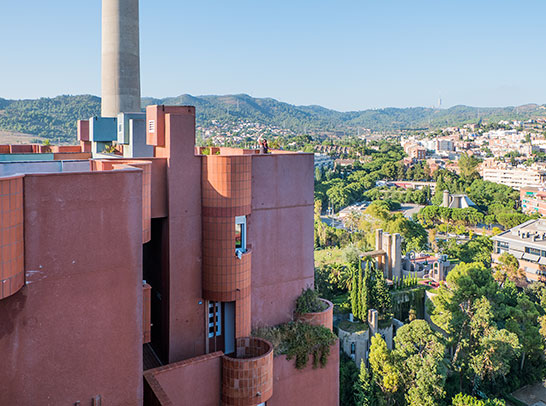 Photo: LatitudesAugust 2017
Photo: LatitudesAugust 2017
Walden 7; or, life in Sant Just DesvernAugust 2017: Walden 7; or, life in Sant Just Desvern
Anna Moreno is waving from the roof of Walden 7, the vertiginous sixteen-storey apartment complex designed by architect Ricardo Bofill in 1975. Hola Anna, què fas! Looming out of the greenery far below is another extraordinary building that we visited earlier in the day. La Fábrica is a former cement works whose silos and cavernous “cathedral” are home to Bofill’s Taller de Arquitectura. It is 29°C and the humidity is at 62% in Sant Just Desvern, west of Barcelona. Two rooftop swimming pools provide a refreshing respite. We don’t complain.
Normally based in The Hague, Anna has been living at Walden 7 for the past month in order to experience its unique hive-like modules, bridges and balconies, and to delve into the neighbouring Bofill archives in conjunction with her ongoing artistic research. She was recently awarded the Barcelona Producció 2017 publication grant, which Latitudes is mentoring. This publication—in fact a vinyl record edition—will conclude The Drowned Giant (2017), a project that, on 7 June, had incorporated a reenactment of a near-mythical happening that Bofill organised in 1970 in Moratalaz, Madrid, to promote the planned utopian community La Ciudad en el Espacio (The City in Space). In the context of 1970s Spain, Bofill’s early communal proposals were revolutionary and forward-thinking anomalies. Looking back from 2017 at how the future once looked, Anna’s publication will take the form of a deliberately fragmentary, speculative and doubtful document of this Utopian moment. The edition will be presented in November. -
 Xavier Ribas, Lucy Skaer, Jannis Kounellis / Photo: Latitudes/RKJuly 2017
Xavier Ribas, Lucy Skaer, Jannis Kounellis / Photo: Latitudes/RKJuly 2017
4.543 billionJuly 2017: 4.543 billion
4.543 billion. The matter of matter recently opened at the CAPC musée d’art contemporain de Bordeaux, and features the work of more than thirty artists. Curated by Latitudes, the exhibition looks at histories of art as fragments in geological time. The portentous mood of this gallery hinges on combustion and history violently formed through the fundamental reordering of the relations between humans and the rest of nature.
On the left of this view is A History of Detonations (2014), by Xavier Ribas, a poster sequence which explores the legacy of the mining of sodium nitrate in northern Chile. The extraction of this resource not only industrialized the arid Atacama Desert at one end of the chain, and enriched English country estates at the other, but through its use as a fertilizer and a component of explosives, it radically altered a whole swathe of seemingly disparate geographies, bodies and institutions.
In the centre Lucy Skaer’s Black Alphabet (2008) comprises twenty-six identical missile-like forms based on the 1926 sculpture Bird in Space by Constantin Brancusi. They are made from coal, the carboniferous matter that became a cheap fuel in the nineteenth century, dethroning peat and charcoal to reshape planetary life and industrial capitalism before the rise of oil.
The late Jannis Kounellis’s threatening Sans titre (Untitled) (1985), a masterpiece from the CAPC collection, bookends the exhibition. Fused steel panels are perforated by pipes that continuously throw live flames, while sacks once used for cacao trading are draped over the top. Kounellis’s work speaks of longue durée movements of power, commodity production and exchange forged across the great expansions of the nineteenth and twentieth centuries.
What appear to be wooden ammunition boxes are in fact core samples on loan from the University of Bordeaux’s lithoteque—negative monuments to a vision of Bordeaux that was thwarted by its geology. They were part of the feasibility study in the 1990s for a proposed underground metro system. The characteristic Calcaire à Astéries (asteriated limestone) that formed from compressed marine life 33.9 million years to 23 million years ago, the same that comprised the museum’s walls, is typically fragile. Geological studies confirmed that tunnelling would be too risky and the underground transit option was discarded. Today Bordeaux has a tram system instead.
As of this month Bordeaux also enjoys a high-speed direct rail link that now connects the city to Paris in a little over 2 hours, and the exhibition—on view until 7 January 2018—forms a part of the Paysages Bordeaux cultural season to mark this new line. -
 Charlotte Moth / Marcelle AlixJune 2017
Charlotte Moth / Marcelle AlixJune 2017
Moth light – Absent FormsJune 2017: Moth light – Absent Forms
The Latitudes-curated Exposition Internationale des Arts Décoratifs et Industriels Modernes & des Arts et Techniques dans la Vie Moderne opened at Meessen De Clercq, Brussels, in February 2011. More a series of five interlinked solo presentations than a conventional thematic group exhibition, it featured the work of Kasper Akhøj, Martí Anson, Maria Loboda, Charlotte Moth and Sarah Ortmeyer.
Charlotte Moth showed The Absent Forms (2010), an assured film comprised of a ten-minute sequence of black-and-white photographs with a soundtrack taken from a recording of an improvised drumming session. In the stills, reflective, translucent and opaque panels—as well as props including balls and a plant—become protagonists in a series of illuminated crepuscular and nocturnal scenes which take place on an angular, tree-lined Paris cul-de-sac. The street is no ordinary one. Its remarkable modernist buildings were designed as a totality by the little-known architect Robert Mallet-Stevens and constructed in 1926–27. Charlotte reimagined the street as a stage set for the dramatisation of the mechanics of the photographic image, and alluded to the scenic role it had played in a number of film productions in which Mallet-Stevens collaborated, including the Josephine Baker vehicle La sirène des tropiques (1927). Textual fragments written in response to Man Ray’s 1929 film Les Mystères du Château de Dé (which uses a Mallet-Stevens-designed villa as a set) intercut the images.
Charlotte’s compelling work over the last decade has led to her nomination for this year’s Marcel Duchamp Prize alongside Maja Bajevic, Joana Hadjithomas & Khalil Joreige, and Vittorio Santoro. The exhibition of the shortlisted artists will open at Centre Pompidou on 27 September. -
Stuart Whipps / BP Video LibraryMay 2017
S is for Shale, or Stuart; W is for Waterfall, or WhippsMay 2017: S is for Shale, or Stuart; W is for Waterfall, or Whipps
Today, as for millennia, the mighty River Zambezi is crashing over a series of precipitous basalt gorges—a place the Makololo people described as Mosi-oa-Tunya. The smoke that thunders. Since the 1870s, a Scottish stream has been plunging over a diminutive replica, seen in this month’s video Cover Story, located in the gardens of a mansion that is now a country house hotel (by all accounts with an enviable breakfast) in the village of Polbeth, less than an hour’s drive from Edinburgh. This loop of the torrent, extracted from a 1937 documentary, comprises one element of an intriguing project by artist Stuart Whipps that will feature in the upcoming group exhibition 4.543 billion. The matter of matter, curated by Latitudes at the CAPC Bordeaux.
In Stuart’s work, fine-grained strata of geological, colonial and art history are compressed as if between the spectacular Zambian falls and its miniature Scottish epigone. Or indexed as if an abecedarium of human and non-human protagonists. L for the missionary and explorer David Livingstone, who ‘discovered’ the great falls in present day Zambia in 1855 and renamed them Victoria Falls in honour of the British monarch. L also for the Zambian-born John Latham, the pioneer of Conceptual art in Britain, who studied the ‘bings’ of West Calder—a series of steep hills between Edinburgh and Glasgow. S for Shale, the inky rock from which an oil fortune was extracted to leave the bings, what are in fact huge grassed-over mounds of waste material. Y for James ‘Paraffin’ Young, the chemist responsible for the surprising fact that Scotland was indeed at the centre of the global oil industry in the 1880s; Young, one of the wealthiest men in Britain at the time, who bankrolled several of his college-friend Livingstone’s african exploits; and the same Young, who acquired the bucolic Limefield House in 1855, and who had the idea to build a wee waterfall in the grounds. -
 Julius von Schoppe / Public Domain – Wikimedia CommonsApril 2017
Julius von Schoppe / Public Domain – Wikimedia CommonsApril 2017
Banff Geologic TimeApril 2017: Banff Geologic Time
Johann Wolfgang von Goethe spent a great deal of time worrying about stones. Not least, he was troubled by a giant 700-tonne granite rock that lay near the otherwise flat land near Berlin. What on earth was this alien to the region’s geology doing there? Goethe’s realisation that the strange mineral object must have been displaced by glaciers helped instigate the theory of ice ages and deep time. Stone provokes us to recalibrate our concept of the past and our place in the world. Rock is radical.
Thinking about stone(s) and the lithic underpinnings of culture will be at the heart of the residency programme ‘Geologic Time’ that will take place from September 11–October 6, 2017 at Banff Centre for Arts and Creativity, in Alberta, Canada. The spectacular Rocky Mountains will not only be the backdrop, but the active participants.
Under the auspices of the Banff International Curatorial Institute, the programme will be led by Latitudes with special-guest artist Sean Lynch. During the month-long period of fieldwork, seminars, and independent study, participants will ponder geological formations and stratigraphy, minerals, and resource extraction to speculate about a more expansive, slower and longer-term view of art, exhibitions, and institutions. The programme takes place within the context of the Latitudes-curated exhibition ‘4.543 billion. The matter of matter’ opening June 2017 at the CAPC musée d’art contemporain de Bordeaux, France.
Applications are open now until May 24 – curators, art writers, researchers, historians, and artists, are all encouraged to apply! -
 Photo: Jordan WolfsonMarch 2017
Photo: Jordan WolfsonMarch 2017
Time travel with Jordan WolfsonMarch 2017: Time travel with Jordan Wolfson
The film that lends its image to this month’s cover story – Jordan Wolfson’s Landscape for Fire, 2007 – was featured in the Latitudes-curated film programme A Stake in the Mud, A Hole in the Reel. Land Art’s Expanded Field 1968–2008, which premiered in April 2008 at the Museo Tamayo, Mexico City, before touring several venues in Spain, Switzerland, the Netherlands and the U.K.
Landscape for Fire responded to a 1972 film of the same name by Anthony McCall in which the British artist, best known for his “solid light” works, attempted to integrate performance, installation, sculpture and images in movement. Thirty-five years on, Jordan had re-staged this work of the past as though it were a ritual, the repetition of which invoked the almost mystical aura that often surrounds the art of the late 1960s and early 1970s.
Fast forward to the present and Jordan’s bravura Manic / Love / Truth / Love continues at the Stedelijk Museum Amsterdam until 23 April. Latitudes was an early champion of the U.S. artist’s prodigious and perplexing work and, besides A Stake in the Mud..., has collaborated with him on several occasions.
Back in 2004, Max Andrews reviewed Jordan’s first institutional show, at the Kunsthalle Zürich, for Frieze and interviewed the artist in New York for the quarterly magazine UOVO – as well as writing the catalogue texts for Jordan’s contribution to that year’s Whitney Biennial Day for Night.
In the summer of 2006, Latitudes brought Jordan to Barcelona where he produced a new sound work entitled Day for the group exhibition Around All Together, One Amongst Many at ProjecteSD.
Jordan’s rarely-seen Untitled (the nothing) (2005–9) – an “interview with a man who claimed to have taken part in secret U.S.-government programmes involving time travel, mind control and alien contact” – was shown as part of Latitudes’s film programme What are we going to do after we’ve done what we’re going to do next? for The Uncertainty Principle at MACBA in 2008.
On 25 June 2009, during the non-profit festival No Soul For Sale, it seemed uncannily apt that it was Jordan’s voice that announced, “Oh my God, Michael Jackson has just died”.
The following month, the group exhibition Sequelism: Possible, Probable, or Preferable Futures curated by Latitudes and Nav Haq at Arnolfini, Bristol, U.K., featured Jordan’s Untitled (2007), a video that zooms in on a 1984 Macintosh 128k stranded by the side of a rural highway in Connecticut. The soundtrack is the portentous opening monologue from Painters Painting, a 1973 documentary directed by Emile de Antonio. Doubtless Jordan will, like the painters de Antonio describes, keep “getting entangled in the contradictions of America itself”, while creating “art of genuine magnitude”. -
 Photo: LatitudesFebruary 2017
Photo: LatitudesFebruary 2017
‘The Dutch Assembly’, five years onFebruary 2017: ‘The Dutch Assembly’, five years on
Five years ago this month ‘The Dutch Assembly’ took place. In 2012, the Netherlands was the guest country of ARCOmadrid and with the collaboration of the Mondriaan Fund and the Embassy of the Netherlands in Spain, Latitudes convened this representation of Dutch art organisations.
Latitudes invited Jasper Niens and Thijs Ewalts to design the helical wooden ‘Superstructure’ that, for each hour of the five days of the fair, hosted a programme of thirty consecutive talks, readings, artists presentations, performances, book launches, in-conversations and screenings.
‘The Dutch Assembly’ transpired in the teeth of a storm surrounding the slashing of the Dutch cultural budget by a State Secretary of Culture (Halbe Zijlstra) who openly flaunted his disdain for the arts. In February 2012, the Mondriaan Fund itself was a newly-minted entity, having been formed the previous month from a cost-saving merger of the former Mondriaan Foundation and Fonds BKVB, the Dutch funding bodies for artists and art institutions. Many of the depositions and dispatches from artists, art spaces, museums, and research initiatives courageously expressed anger and concern. (Recordings of several of the contributions are here.)
How have the participating organisations faired in the last five years? Thankfully ‘Dutch Assembly’ participants such as Witte de With, the Van Abbemuseum, or the Van Eyck Academie, to name just three, continue to shine. Beyond the musical chairs of changing jobs – whether Beatrix Ruf arriving at the Stedelijk Museum (then closed, awaiting its expansion), Anke Bangma moving from the Tropenmuseum to TENT, or Xander Karskens leaving De Hallen for the CobraMuseum – perhaps the most tumultuous years have been weathered by De Appel Arts Center. De Appel was represented at ‘The Dutch Assembly’ by its then-Director Ann Demeester (now heading the Frans Hals Museum) and at the time called a former primary school its temporary home. Since then a director has come and gone (Lorenzo Benedetti, who represented De Vleeshal, Middelburg, at ‘The Dutch Assembly’). Gone too is the school, and now the subsequent Prins Hendrikkade townhouse premises is a thing of the past – De Appel moves to its next home from March this year.
Three organisations have since disappeared entirely. The Museum De Paviljoens, Almere, closed its doors in July 2013. With its structural funding also discontinued in 2013, SKOR | Foundation for Art and Public Domain has also ceased to exist. Its archive, including material related to Latitudes’s Portscapes project, is now housed at LAPS. The Stedelijk Museum Bureau Amsterdam (SMBA) was also defunded in 2013, yet hung on until July 2016 when its stoppage was announced.
The year after in the Madrid event, the wooden ‘Superstructure’ travelled to Moscow, where it hosted ‘How do we want to be curated?’ as part of the fringe programme of the Moscow Biennale against the backdrop of a number of “major protagonists of the art scene [that had] closed down or redirected their activities”. Jump to today, and as the elimination of arts’ funding remains a vengeful probability wherever foxes are advising on henhouse security, we might well ponder, not only the limits of cultural diplomacy, but more pointedly, how we might democratise democracy. -
 Felicien Myrbach-Rheinfeld / The Metropolitan Museum of Art, Harris Brisbane Dick Fund. Public DomainJanuary 2017
Felicien Myrbach-Rheinfeld / The Metropolitan Museum of Art, Harris Brisbane Dick Fund. Public DomainJanuary 2017
How open are open calls?January 2017: How open are open calls?
The first issue of frieze of 2017 includes “Salon Selectives”, an article by Latitudes’s Max Andrews that, with a wink to sassy 1980s hair care, asks “how open are open calls?”. The text is accompanied by this astonishing drawing from the collection of The Metropolitan Museum of Art by Felicien Myrbach-Rheinfeld entitled Candidates for Admission to the Paris Salon (c.1900).
The open call for artists has been a mechanism for putting together exhibitions for centuries; it long predates curatorial work as a route to making displays of art. Yet the article makes the case that “the skeuomorphism of the Salon form and its panoramic approach has had an uneasy transition into the present”, and, by discussing examples from Qatar to New York, and from Barcelona to Antwerp, it tracks the “mission creep of the open call from being an episodic incentive to a wholesale tool of institutional rationalization.”
Rem Koolhaas is on the record as saying that such open competitions are a complete drain of intelligence. Is the deleterious habit of the world of architecture in danger of creating a closed loop in contemporary art? Might the open call mechanism “actually exacerbate the precariousness of the artists and curators they are supposed to assist”? Can it be hacked? Like you just stepped out of a Salon?
You can find the link to this article as well as many other texts penned since 2005 on the Writing section of this website. -
 Photo: LatitudesDecember 2016
Photo: LatitudesDecember 2016
Ten years ago – ‘Land, Art: A Cultural Ecology Handbook’December 2016: Ten years ago – Land, Art: A Cultural Ecology Handbook
The publication Land, Art: A Cultural Ecology Handbook is ten years old. Commissioned by the Arts & Ecology programme of The Royal Society for the Encouragement of Arts, Manufactures & Commerce (RSA), in partnership with Arts Council England, this book was one of Latitudes’s first projects. Through the inspirational contributions of people as varied as Lucy Lippard, Stephanie Smith, Amy Balkin, or the late Wangari Maathai – to mention just a few – the compendium charted the twin legacies of Land Art and the environmental movement while proposing how the critical acuity of art might remain relevant in the face of the dramatic ecological consequences of human activity. The research and reflection involved set Latitudes on a course that led to several further projects engaging with ecology, explicitly or otherwise.
When Land, Art... was launched a decade ago this month at an event at the London School of Economics and Political Science (LSE), Tony Blair was Prime Minister of the United Kingdom, George W. Bush was President of the United States, and José Luis Rodríguez Zapatero was Prime Minister of Spain. The landmark Stern Review on the economics of climate change had been published two months earlier; the notion of the Anthropocene had yet to become widely discussed, having been first proposed in print in 2002.
The “cultural ecology” of the book’s title drew on Félix Guattari’s The Three Ecologies (1989) and its three-pronged characterisation of ecological thought and action – environmental ecology, social ecology, and mental ecology. Why not cultural ecology? Or indeed curatorial ecology, ecological art history, etc? Guattari realised that new humanities are required to venture beyond the great divide wrought between environment and society.
United States President-Elect Donald Trump is a man who has declared that the notion of global warming was created “by and for the Chinese in order to make US manufacturing noncompetitive” and who has promised to “cancel” the Paris Agreement, a pledge signed by most of the world’s countries to reduce greenhouse gas emissions. Myron Ebell – a vocal climate change denier – has been tasked with overseeing the Trump transition of the Environmental Protection Agency (EPA). As Trump will shortly have the power to undermine or protect United States environmental policy, his actions – or inaction – have the potential to do immense damage. We cannot say we were not warned. In the same The Three Ecologies, Guattari presciently wrote:
“Just as monstrous and mutant algae invade the lagoon of Venice, so our television screens are populated, saturated, by ‘degenerate’ images and statements. In the field of social ecology, men like Donald Trump are permitted to proliferate freely, like another species of algae, taking over entire districts of New York and Atlantic City; he ‘redevelops’ by raising rents, thereby driving out tens of thousands of poor families, most of whom are condemned to homelessness, becoming the equivalent of the dead fish of environmental ecology.” -
 Photo: Pep HerreroNovember 2016
Photo: Pep HerreroNovember 2016
Plucking Gilda, synesthetic Toni and dazzling VíctorNovember 2016: Plucking Gilda, synesthetic Toni and dazzling Víctor
Gilda Love, la cachonda de Cádiz (the horny girl from Cádiz) as she calls herself, regularly graces the stage during the cabaret that goes by the name El desplume (The Plucking) at Barcelona’s Antic Teatre. She is also one of the brightest stars in the constellation that is Antoni Hervàs’s exhibition El misterio de Caviria (The Mystery of Cabeiria) which continues at La Capella until November 13th. Here we see the nonagenarian drag showgirl Gilda in the form of a multicoloured doorway, her succulent pouting rictus aghast like the Orc’s mouth in the Gardens of Bomarzo.
“I had seen Gilda in the documentary Yo soy así (This is me, 2000) by Sonia Herman Dolz”, Toni explains in the forthcoming publication that accompanies his project of the 2016 edition of BCN Producció. “During [my first visit to] El desplume, Víctor Guerrero introduced Gilda (Victor also designs the dazzling attire that she wears): ‘The legend is here!’ Soon, a brilliant and powerful whirlwind appeared, stopping time and winning the audience over from the first moment that she stepped on stage. When Gilda reveals her real age in one of her characteristic monologues, the audience is always left dumbfounded – she seems immortal. I realised that I was establishing some synesthetic relations by which I attributed colours to her stories. I started to imagine a scenario in my head: her large eyes open wide as she perceives a steaming stench cast by Draculina...”
On November 3rd at 7pm the exhibition will become the setting for showman and costumier Guerrero to further dazzle us with a choreographed runway show featuring a selection of his most memorable and outrageous outfits from the 1970s to the present – showbiz never dies! -
 Photo: Roberto RuizOctober 2016
Photo: Roberto RuizOctober 2016
A Funny Thing Happened on the Way to the GalleryOctober 2016: A Funny Thing Happened on the Way to the Gallery
During the past few days the Compositions of the Barcelona Gallery Weekend could be found in a subterranean billiards club, an abandoned textiles factory, a masonic-anarchist library, and the stables of the city police. The contribution of Robert Llimós was constantly dashing between these singular venues and the twenty-three participating galleries. Los Corredores (The Runners) was a remake of an action that was originally created in the summer of 1972 as part of the legendary avant-garde art festival known as Los Encuentros de Pamplona (The Pamplona Meetings). Llimós is best known for a long trajectory as a painter and sculptor that began in the sixties within the Nueva Figuración movement, and continues today with his depictions of extraterrestrials, yet this is one of a handful of his striking performative works.
Three athletes criss-crossed the city, seemingly rushing to see every exhibition. As in Pamplona, the white sports kits were emblazoned by Llimós with black diagonal brushstrokes; in 2016 they featured an additional UFO motif. At times the speed-walking trio carried flowers, had their limbs joined with elastic ribbon, or carried sticks of bread. Llimós’s tragicomic performance was inspired by the last role of the great slapstick star Buster Keaton, a cameo in A Funny Thing Happened on the Way to the Forum (1966). Keaton’s character Erronius pops up as a sight gag throughout the whole film, scampering around in search of something that he cannot find. Special thanks to Robert, Bruna and runners Marta, Jaume, Diego and Anna; kudos to photographer extraordinaire Roberto for literally going the extra mile in documenting their route! -
 Photo: LatitudesSeptember 2016
Photo: LatitudesSeptember 2016
Antoni Hervàs: ‘El Misterio de Caviria’September 2016: Antoni Hervàs: El Misterio de Caviria
Antoni Hervàs draws back the curtains on his exhibition El Misterio de Caviria at the Sala Gran of La Capella, Barcelona, on 15 September. As part the tutorial team of BCNProducció’16 alongside David Armengol and Mireia Sallarès, Latitudes has been working with Toni since February on the development of what can only be described as an epic production.
Toni’s drawing-based practice seems to have taken on the proportions of a legendary tale, as not only have his colouring pens beseeched several of the muses of the Greek classical arts for their inspiration—from Euterpe (music), to Clio (history), and Terpsichore (dance, in the guise of collaborations with rhythmic gymnasts and synchronised swimmers). The project has also reached its saga-like span through a deliberately ambitious goal—to fuse, on the one hand, the myth of the Argonauts and their quest for the Golden Fleece with, on the other, the gender-dissident folklore of the drag, cabaret and music hall scene that flourished in Barcelona during the latter part of the brutally austere, homophobic and grey Franco dictatorship.
Seen here taking shape in Toni’s temporary studio in Fabra i Coats, one psychedelic section of El Misterio de Caviria features cardboard cut-out columns that evoke the Sanctuary of the Kabeiroi on the Greek island of Lemnos. In the Argonaut story, Lemnos is ruled by women who have butchered all the island’s men and been condemned by Aphrodite with a terrible stench. (Classicists now interpret the malodorous women as the result of their production of purple dye from marine snails.) Toni’s twisting razzle-dazzle columns borrow graphic motifs from some of Barcelona’s legendary cabarets—the ionic capitals recall the sign that once stood over the door at Barcelona de Noche, which closed its doors in 1990.
The star of another cursi showbiz venue, Whisky Twist, was Violeta la Burra. Although Whisky Twist has long gone from the Plaça de les Olles, and is now the site of the bar Cal Pep, Violeta is still very much going strong. Violeta has made a recording especially for this section of the exhibition in which she interprets the Lemnian women’s predicament through the eyes of a vengeful goddess and her most famous role—Draculina! -
 Photo: Fermín Jiménez LandaAugust 2016
Photo: Fermín Jiménez LandaAugust 2016
FermínlandiaAugust 2016: Fermínlandia
Five years ago, in August 2011, Fermín Jiménez Landa initiated the surrender, conquest and defence of a small nameless island using the power of music. With the help of local fishermen he had taken a portable generator, two tripod-mounted loudspeakers, and an mp3 player out into the Aegean Sea and planted the equipment on this uninhabited Greek island. Its new national anthem played again and again until the batteries ran out. You can just make out the two loudspeakers sitting atop the grassy rock in this photograph by Fermín
Entitled Himno Nacional (National Anthem), this strategic Sisyphean invasion formed a part of a project later shown in an exhibition with Lee Welch for the Latitudes-curated series Amikejo, which took place throughout 2011 at the Laboratorio 987, Museo de Arte Contemporáneo de Castilla y León (MUSAC).
Fermín had asked La Cena—León’s Agrupación Musical Santa Marta y Sagrada La Cena (the Musical Group of Saint Martha and the Last Supper)—to compose the rousing wordless song that would eulogise and celebrate the establishment of a fledgling island nation. Only this special force of ritualistic sound constituted the doughty territorial claim. Although it might bring to mind the futility of the Perejil Island crisis of 2002 (a bloodless armed conflict between Spain and Morocco that took place over a tiny uninhabited islet) or the chutzpah of micro-nations such as the Republic of Rose Island, Fermín’s island insurgence nevertheless had no perceivable political agenda.
At the opening of Fermín and Lee’s exhibition in September, and following a musical procession of the kind only usually seen during Holy Week, the fifty-strong brass and percussion ensemble of La Cena belted out the anthem at MUSAC, restating allegiance and pride in the unknown values and non-existent traditions of the fledgling nameless nation. Long may they prevail. -
 Photo: Roberto RuizJuly 2016
Photo: Roberto RuizJuly 2016
Through the grapevine – Rasmus Nilausen’s ‘Soups & Symptoms’July 2016: Through the grapevine – Rasmus Nilausen’s Soups & Symptoms
Rasmus Nilausen’s The Cluster III (2014) sits tight in a cupboard in what was once the house of a priest. This painting formed just one part of the exhibition that, together with Pere Llobera, Nilausen made for the Latitudes-devised Composiciones last October (the programme of artists’ interventions returns later this year). Vera Icon took over the rooms of the abandoned house in the gardens of La Central bookstore, itself a former city-centre church, and tweeting Mayoress Ada Colau was one of the many curious visitors over the weekend.
The Cluster III is part of the panorama of works featured in Nilausen’s forthcoming book Soups & Symptoms: Paintings 2011–2016 – the result of the Art Nou Prize 2015. The publication includes several miscellaneous writings by Max Andrews. The Cluster III is by no means the only one of Nilausen’s canvases to feature grapes. In his art, bunches of the fruit wonder about painterly realism, and the great degree to which truthfulness and accuracy mattered to the artistic imagination of the Ancient world, through their reference to a legendary competition.
As one of the texts in Soups & Symptoms relates, in Pliny the Elder’s description of a painting contest between the Greek heavyweights Parrhasius and Zeuxis, the latter made an exquisite painting of grapes. Zeuxis “had rendered a glistening bunch of the viniferous fruit in such an astonishingly realistic manner that birds fluttered down to where the picture was displayed.” On the other hand, “the arrogant Parrhasius ... tricked his rival with an image of a curtain so lifelike that Zeuxis thought that the real picture had been hidden behind it.” -
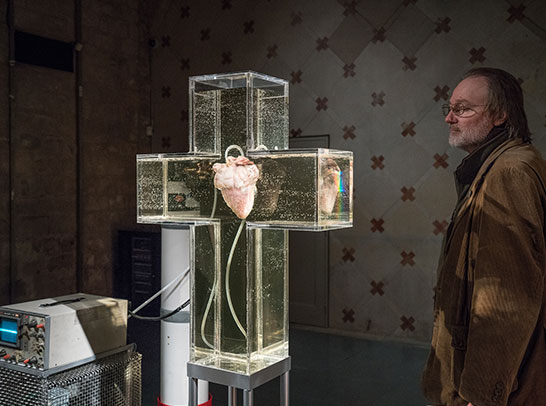 Photo: Miquel Coll / MACBAJune 2016
Photo: Miquel Coll / MACBAJune 2016
José Antonio Hernández-Díez: techno-pop, death and resurrectionJune 2016: José Antonio Hernández-Díez: techno-pop, death and resurrection
José Antonio Hernández-Díez’s exhibition No temeré mal alguno (I will fear no evil) – curated by Latitudes – continues at the Museu d’Art Contemporani de Barcelona (MACBA) until 26 June. Reconstructed for the exhibition, the extraordinary Sagrado Corazón Activo was first shown in September 1991 in a group show titled El Espíritu de los Tiempos (The Spirit of the Times) in Caracas, Venezuela. It belongs to a body of work that José termed a ‘New Christian Iconography’ in which the application of communications and medical technology interlace with systems of paranormal belief, most prominently Christian theology.
Published as part of MACBA’s Portable Notebook series, Latitudes’s essay about José’s exhibition explains that “this visceral work deals with a key point of difference in theologies related with transubstantiation and ‘real presence’ – the notion that Jesus Christ is actually somehow present in a fleshy way in the bread and wine of the Eucharist versus being a symbolic or a metaphorical presence. Sagrado Corazón Activo seems to inhabit the peculiarly disjointed temporality that is proper to hauntology – a techno-medical vision of a science-gone-mad future within an ancient symbolic past.”
No temeré mal alguno (I will fear no evil) focusses on José’s first experimental works with videography in the late 1980s and early 1990s and such early iconic vitrine-based works, alongside a new project made for the occasion. The presence of ghosts and bodily organs in this phase of Hernández-Díez’s out-of-joint art – videographic spectres, disembodied voices, preserved creatures, hearts and skin – is only enhanced by the necromantic aspect of the fact that several of his works were remade, as if brought back to life, for the exhibition. -
 Photo: LatitudesMay 2016
Photo: LatitudesMay 2016
Material histories – spilling the beans at the CAPC musée d’art contemporain de BordeauxMay 2016: Material histories – spilling the beans at the CAPC musée d’art contemporain de Bordeaux
In pondering a museum’s memories you seldom think of coffee beans. Yet at CAPC Contemporary Art Museum Bordeaux, burnished nuggets of the past in the form of the seeds of Coffea arabica occasionally materialise, as if out of nowhere. One day one might appear atop a pile of papers on an office desk; weeks later, another bean might show up in the middle of one of the exhibition galleries. A look on top of a shelf in the library might harvest several. During Latitudes’ recent residency at CAPC, François Poisay from the exhibition team showed us the stash he has been squirrelling away in his desk for years.
Established as a venue for art in the 1970s, the CAPC building was formerly a warehouse for commodities, completed in 1824. Following the abolition of slavery and, in 1804, the end of France’s colonial rule in Saint-Domingue (now Haiti) Bordeaux’s Chamber of Commerce had built the Entrepôt Lainé to regularise the storage of the goods merchants imported from the Caribbean, and elsewhere, in order to feed the still-lucrative trade with northern Europe. Not only would hundreds of thousands of sacks of coffee have come through the building, but also tonnes of sugar, cacao, pepper, rice, and many other foodstuffs, as well as cotton and indigo for the textile industry. A chart of 1921 paints the picture. Clearly several sacks spilled over the years, and coffee beans, as well as peppercorns, found there way into the nooks and crevices of the wooden floorboards and beams, only to emerge again years later. Such material histories will inform a prominent strand of the group exhibition Latitudes is preparing for CAPC for the summer of 2017. -
 Photo: LatitudesApril 2016
Photo: LatitudesApril 2016
New Incidents and ‘Espacio Escultórico’ with Jerónimo HagermanApril 2016: New Incidents and Espacio Escultórico with Jerónimo Hagerman
Addressing artists’ fascination with beguiling and conflicted sites has often been at the core of ‘Incidents of Travel’. We’re delighted that what began as Latitudes’s fieldwork on chartered artists’ itineraries will very soon be transforming into a new guise – an online periodical. Developed in collaboration with Kadist Art Foundation, from May the format will go ‘distributed’ by presenting dispatches from curators and artists working around the world.
As part of ‘Incidents of Travel’, on 24 September 2012 Jerónimo Hagerman took us clambering around this extraordinary place – the land artwork known as Espacio Escultórico (Sculptural Space) on the campus of the National Autonomous University of Mexico (UNAM) in Mexico City. Jerónimo has just had an exhibition at the Museo Experimental El Eco in the city. Entitled Y si pudiera volar... ¿qué tan alto llegaría? (And if I could fly... how high would I reach?), his intervention took the form of a sensory dialogue with Mathias Goeritz’s startling 1952 El Eco building – and the local avifauna – through a grove of bamboo structures, vegetation and water fountains. The UNAM is responsible for El Eco, as well as the mothership MUAC, and Casa Del Lago, the lakeside art centre that first hosted ‘Incidents of Travel’.
Espacio Escultórico opened on 23 April 1979 as a collective artwork by Goeritz, Helen Escobedo, Manuel Felguérez, Hersúa, Sebastián and Federico Silva. In the written guide to the day-long tour that Jerónimo devised in order to delve together into the city and its organic double, he discloses that he knows “of no other space or public observatory that is so powerful and contemplative in any other city”.
Yet in recent months a threat to this powerful sense of place – and the remarkable 120-metre-diameter collaborative artwork – has been causing much rancour in Mexico and beyond. The University’s decision to construct its new ‘Building H’ tower on a site that glaringly disrupts the 360° vista of Espacio Escultórico is at best clumsy, at worse noxiously cynical. There is a petition calling for the dismantling of its upper floors in order to restore the integrity of the artwork. The Pedregal de San Ángel lava fields in the south of Mexico City which frame it were created by the eruption of the volcano Xitle during the period AD 245-315. The site and Espacio Escultórico’s amalgam of geometry, geology and verdancy creates, in the words of Jerónimo, “an emotional space ... the place where I feel most exposed to landscape, and where I’m made conscious of its fundaments.” ‘Building H’ is an unwelcome development. -
 José Antonio Hernández-Díez / Photo: LatitudesMarch 2016
José Antonio Hernández-Díez / Photo: LatitudesMarch 2016
José Antonio Hernández-Díez: The sacred heart of the matterMarch 2016: José Antonio Hernández-Díez: The sacred heart of the matter
Addressing artists’ fascination with beguiling and conflicted sites has often been at the core of ‘Incidents of Travel’. We’re delighted that what began as Latitudes’s fieldwork on chartered artists’ itineraries will very soon be transforming into a new guise – an online periodical. Developed in collaboration with Kadist Art Foundation, from May the format will go ‘distributed’ by presenting dispatches from curators and artists working around the world.
As part of ‘Incidents of Travel’, on 24 September 2012 Jerónimo Hagerman took us clambering around this extraordinary place – the land artwork known as Espacio Escultórico (Sculptural Space) on the campus of the National Autonomous University of Mexico (UNAM) in Mexico City. Jerónimo has just had an exhibition at the Museo Experimental El Eco in the city. Entitled Y si pudiera volar... ¿qué tan alto llegaría? (And if I could fly... how high would I reach?), his intervention took the form of a sensory dialogue with Mathias Goeritz’s startling 1952 El Eco building – and the local avifauna – through a grove of bamboo structures, vegetation and water fountains. The UNAM is responsible for El Eco, as well as the mothership MUAC, and Casa Del Lago, the lakeside art centre that first hosted ‘Incidents of Travel’.
Espacio Escultórico opened on 23 April 1979 as a collective artwork by Goeritz, Helen Escobedo, Manuel Felguérez, Hersúa, Sebastián and Federico Silva. In the written guide to the day-long tour that Jerónimo devised in order to delve together into the city and its organic double, he discloses that he knows “of no other space or public observatory that is so powerful and contemplative in any other city”.
Yet in recent months a threat to this powerful sense of place – and the remarkable 120-metre-diameter collaborative artwork – has been causing much rancour in Mexico and beyond. The University’s decision to construct its new ‘Building H’ tower on a site that glaringly disrupts the 360° vista of Espacio Escultórico is at best clumsy, at worse noxiously cynical. There is a petition calling for the dismantling of its upper floors in order to restore the integrity of the artwork. The Pedregal de San Ángel lava fields in the south of Mexico City which frame it were created by the eruption of the volcano Xitle during the period AD 245-315. The site and Espacio Escultórico’s amalgam of geometry, geology and verdancy creates, in the words of Jerónimo, “an emotional space ... the place where I feel most exposed to landscape, and where I’m made conscious of its fundaments.” ‘Building H’ is an unwelcome development. -
 Sarah Ortmeyer / Photo: Philippe de GoubertFebruary 2016
Sarah Ortmeyer / Photo: Philippe de GoubertFebruary 2016
Sarah Ortmeyer: Towering allusionsFebruary 2016: Sarah Ortmeyer: Towering allusions
As the literary theorist Roland Barthes once wrote, the Eiffel Tower "attracts meaning the way a lightning rod attracts thunderbolts". Even before the Paris landmark was built, the merest bouffée of the notion that it might not have any use at all was deemed to be irredeemably scandalous. In 1887 its champion, Gustav Eiffel himself, cited a long list of proposed scientific experiments in its defence – from meteorological research to studies of the physiological effects of climbing.
In 2011, as part of the group show Exposition Internationale des Arts Décoratifs et Industriels Modernes & des Arts et Techniques dans la Vie Moderne at Meessen De Clercq, Brussels, Sarah Ortmeyer paid homage to the Tower's universal symbolism as well as its largely-forgotten original engineer, Maurice Koechlin. VITRINE MAURICE (2011) consisted of a series of objects and furnishings arranged in similar fashion to the viewing of the 'Collection Yves Saint Laurent et Pierre Bergé' auction at Paris's Grand Palais in 2009. Sarah's installation comprised a conspiracy of Tower-like emblems, Eiffel echoes and Koechlin allusions – a series of triangular objects, patterns and refrains. Her invocation of the structure's monumental geometry appeared to object to the modernist spirit of rationality, clarity and empiricism in which the Tower was originally conceived. It has been precisely the sense that it was manufactured for no good reason in particular that has proved its irresistibility to the imagination. The protean Eiffel Tower pulls us up towards uselessness just because it can. -
 Photo: Kasper AkhøjJanuary 2016
Photo: Kasper AkhøjJanuary 2016
Kasper Akhøj; Eileen Gray’s E.1027January 2016: Kasper Akhøj; Eileen Gray’s E.1027
We first got to know Kasper Akhøj, and his meticulous art, in 2007 in the United Arab Emirates. Kasper was there installing Autoxylopyrocycloboros (2006) for Simon Starling as part of Sharjah Biennial 8, while we were there curating the biennial’s symposium. Four years later in 2011 we were delighted to include Kasper’s work in the Latitudes’ group show Exposition International des Art Décoratifs et Industriels Modernes & des Arts et Techniques dans la Vie Moderne (International Exhibition of Modern Decorative and Industrial Arts & Art and Technology in Modern Life) at Meessen De Clercq, Brussels, in 2011. Here he presented a slideshow which centred on the ‘Abstracta’ display system, originally designed by the Danish architect and designer Poul Cadovious in the 1960s.
Kasper opens his first solo exhibition at Ellen de Bruijne Projects, Amsterdam, on January 16th. It will feature a project entitled Welcome (To The Teknival) that he has been working on since 2008. A series of photographs incrementally document the restoration of the Maison en Bord de Mer known as E.1027 designed by Eileen Gray and Jean Badovici on the French coast near Monaco. A portfolio of views of this iconic house was first published in a special issue of the journal L’Architecture Vivante in 1929. Kasper restaged these images of the house at three points in time throughout what has been a controversial restoration process, made all the more convoluted by the presence of a number of murals by Le Corbusier that were painted in the house without Gray’s consent.
The exhibition will be accompanied by a publication designed by Anni’s which features an essay by Latitudes’s Max Andrews. “The consecratory role of the photograph, especially in the mythos of modern trophy architecture, is a denial of the organic reality of buildings”, the text asserts, “... the thriving of hermetic architectural bling on the web, from Deezen and ArchDaily to shrewd Airbnb users, demonstrates how tenaciously the imperative to show buildings as autonomous entities persists. Photogenic star architecture fudges the evidence that buildings change persistently through use. A building is always tearing itself apart.” Kasper’s project shadows an inscrutably corporeal building that has endured many guests – both the invited and the unwelcome, the hospitable and the violent. -
 © Eva GalatsanouDecember 2015
© Eva GalatsanouDecember 2015
Learning from OmonoiaDecember 2015: Learning from Omonoia
The Athens Biennale 2015–2017 began its official program on November 18. An International Summit took place at the National Theatre of Greece’s New Rex venue on Panepistimiou Street. Entitled Omonoia (‘concord’ in Greek), the Biennale is directed by Massimiliano Mollona and will grow over the next two years with the help of anthropologists, researchers, activists, academics, artists and civic organisations. The eponymous Omonoia Square and its neo-classical Bageion hotel building will be the symbolic and geographical hub of activities – yet, in taking place as a processual form over two years, the Biennale is more concerned with the occupation of time rather than space.
Latitudes participated in the ‘Rethinking Institutions’ panel of the Summit, and was humbled to take the stage at the 1935 former Rex Cinema (the uncanny ceiling is by Yiannis Tsarouchis and his pupil Yiannis Palaiologos) alongside Maria Hlavajova (founder and artistic director of BAK, Utrecht); political economist Leo Panitch; Emily Pethick, director of The Showroom, London; Documenta 14 Artistic Director Adam Szymczyk; public services expert Hilary Wainwright, and Amalia Zepou, Athens Vice Mayor for Civil Society and Municipality Decentralization. As was the case with all the other panels, not to mention the following day’s working sessions – brimful with topics from alternative currencies, to cooperativism and the commons – an abundance of questions, provocations and possibilities transpired. How to move beyond the curating of struggles and voices? How to test drive a new institution without being choked by the existing ones? Is activism in art usually a theme and rarely a practice? And what was so inactive to begin with? And indeed, what exactly, to adopt the working title of Documenta 14, can we learn from Athens? -
 Christina Hemauer and Roman Keller / Photo: Paloma PoloNovember 2015
Christina Hemauer and Roman Keller / Photo: Paloma PoloNovember 2015
‘The Postpetrolistic Internationale’, RotterdamNovember 2015: ‘The Postpetrolistic Internationale’, Rotterdam
Six years ago this week, a stage arrived in Rotterdam, the Netherlands, having made its way down the Rhine from Switzerland on an oil tanker. Oil has been processed in the port of Rotterdam since the 1960s. Europe’s highest capacity refinery, owned by Royal Dutch Shell, operates there alongside the facilities of four other companies. Globalising the Internationale, Christina Hemauer and Roman Keller’s project for Portscapes, culminated in a choral anthem sung from this modest wooden platform. The song is a manifesto of hope for a new imaginary around energy-use and a Post-petrolistic era beyond resource extraction. “Cheap nature”, as Jason W. Moore argues in Capitalism in the Web of Life (2015), is at an end – cheapening nature will not work any longer to sustain production as most of the reserves of the planet have been burned, drained, depleted and exhausted. Like Donna Haraway, Christina and Roman imply that the Anthropocene thesis would be more fruitfully thought of as a boundary event rather than an epoch – what comes after will not be like what came before.
On the Maasvlakte at the extremities of the Port of Rotterdam – with E.ON’s coal-fired power station as a backdrop – Christina and Roman’s rousing Postpetrolistic Internationale anthem was sung on the 8th of November 2009. (It was reprised in Århus, Denmark, in 2011.) “We’ve ex–haus–ted the world, but we’re still go—ing strong. The earth has been drained, we must find new ways to waste. The time has come, we’ll beat the drum and watch the Brave New World col–lapse.” -
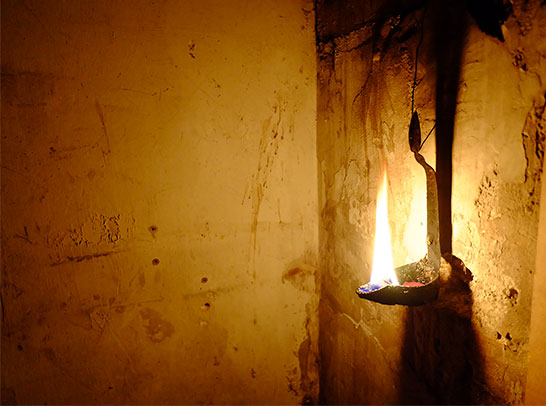 David Bestué / Photo: LatitudesOctober 2015
David Bestué / Photo: LatitudesOctober 2015
Illuminating the weekend, BarcelonaOctober 2015: Illuminating the weekend, Barcelona
An intense flash of light and a colossal series of bangs awoke young Enric and his parents in the dead of the night of the 17th November 1938 during the Spanish Civil War. L’Hospitalet de Llobregat was being bombed – or so they thought. In fact there had been a catastrophic accident at one of the three huge ceramics factories nearby that had been converted to manufacture weapons during the war. Or was it sabotage? Still today the facts about the event cannot be clearly discerned through the smoke of conflict and propaganda; some sources reported a staggering 470 people were killed, others made out that it was no more than a routine job for the fire service. This much is certain: the Ceràmica Llopis site was all but obliterated, yet the neighbouring Cosme Toda factory, from where Enric watched the blaze on that night in 1938, and where he recounted his story to us last week, still stands. Abandoned for more than a decade, the factory complex awaits a near future as housing and planned cultural facilities.
Enric was one of the many local visitors curious to see inside the former director’s house at Cosme Toda and to discover artist David Bestué’s new work Luces (Lights) which fleetingly illuminated its two floors as part of Composiciones, five artists projects curated by Latitudes for the first Barcelona Gallery Weekend. His remarkable story brought an unforeseen dimension to David’s work and its reflection on the evolution of lighting technology (from the burning oil pictured, to LED) alongside the role of the factory’s ceramics in the volatile form and function of Catalan Modernisme.
David had a recollection of his own which related to another of the venues of Composiciones. David used to work in a bookshop – the Raval branch of La Central is based in what was once the church of the Casa de la Misericòrdia de Barcelona, a poor house founded in 1583. He remembers how, each morning, the elderly priest would tour the shelves that now occupied his former episcopal domain and greet the staff. The priest lived right next door in a house with a garden until his death in 2010. His home has remained unoccupied since then, just over the wisteria-covered wall on Carrer d’Elisabets which thousands of people must pass every day between La Rambla and MACBA. For Composiciones, Pere Llobera and Rasmus Nilausen made a startling painting exhibition there.
Elsewhere during the full weekend: yes, a friend of the Geological Museum of the Seminari Conciliar de Barcelona miraculously proposed a species identification for one of Jordi Mitjà’s drawings – a kind of Eocene sea urchin. Yes, the Gorgonzola and Burgundy that followed Dora García’s talk at the Freudian Field Library with psychoanalyst Xavier Esqué and James Joyce expert Patrick Bohan was a homage to Ulysses. Yet no, although the fidelity of the tropical sounds coming from the Umbracle was uncanny, Daniel Steegmann Mangrané did not really bring a howler monkey (or a macaw, or a frog) to the Ciutadella Park. -
 Photo: LatitudesSeptember 2015
Photo: LatitudesSeptember 2015
World Famous Giant Camera, San FranciscoSeptember 2015: World Famous Giant Camera, San Francisco
“The Giant Camera plays a role in a film I haven’t yet made”, Amy Balkin reveals as we strain to see the Farallon Islands way off the coast of San Francisco, California. Back in 2006, we had featured Amy’s work This is the Public Domain (2003–ongoing) in Land, Art: A Cultural Ecology Handbook and Public Smog (2004–ongoing) in the 2008 exhibition Greenwashing, yet we had never met in person before. She explains that observations of wildlife at the Farallons this year have confirmed the disruptive effects of an unusual period of warm ocean temperatures due to El Niño and climate change. Seal Rocks are impossible to miss from where we stand at Point Lobos at the north end of Ocean Beach as they’re right off shore from the famous Cliff House. Amy tells us that the rocks were once the site of the earliest experiments in wave power and tidal energy in California. Moreover, Seal Rocks would have once actually had seals on them.
We spend 3rd September exploring this and several other sites across San Francisco through Amy’s eyes, projects and concerns. (Here is a pdf of the whole itinerary.) Part of a series of artists’ tours or expanded studio visits ongoing since 2012 under the moniker Incidents of Travel, our thought-provoking day with Amy – alongside those with archivists Megan & Rick Prelinger and the collective Will Brown – took place during Latitudes’ residency at Kadist Art Foundation.
Pay three bucks to enter the Giant Camera and you can see the spectacular view of Seal Rocks and the Pacific magnified seven times as it is cast pin-sharp on a two-metre parabolic screen. Although the jaunty exterior of the camera obscura has been extensively modified over the years, its mechanism has essentially remained unchanged since the 1940s when it formed part of the attractions at the Playland amusement park. The Cliff House too is a case-study in longevity. Indeed one of our current book crushes – How Buildings Learn (1994) by Stewart Brand, creator of the Whole Earth Catalogue – uses it, or rather its several erstwhile incarnations since 1863, to illustrate a principle of the eternality of geographical site and rates of built change. “The house comes and goes. The cliff stays.” -
 Nicholas Mangan / Chisenhale Gallery, London / Artspace, Sydney.Summer 2015
Nicholas Mangan / Chisenhale Gallery, London / Artspace, Sydney.Summer 2015
Nicholas Mangan’s ‘Ancient Lights’Summer 2015: Nicholas Mangan’s ‘Ancient Lights’
The first person we emailed when we received the invitation to participate in the Visiting Curator Program of Gertrude Contemporary in late 2013 was Nicholas Mangan. Born Geelong, Australia; lives and works in Melbourne, Australia. We had been corresponding with Nick for several years and had moreover discovered we had a friend in common, the irrepressible Martí Anson. (Nick and Martí had got to know each other in 2009 during their participation in SITE Santa Fe.)
Fortunately Nick would be in town during the first few days of our Melbourne soujourn in May 2014, yet had to leave soon after to film for his new project, ironically enough, here in Spain. We have been eagerly tracking the development of Ancient Lights since Nick first told us he was working towards a solo show for London’s Chisenhale Gallery and Sydney’s Artspace. The show opened in London on 2 July, and following Mariana’s recent Mousse interview and Max’s Frieze feature, Latitudes was in conversation with Nick at the Chisenhale on Tuesday 7 July. You can watch video documentation of the event here.
As described in the ‘Landscape Artist’ feature, one screen of Ancient Lights “features high-speed footage of a spinning coin, a Mexican ten peso piece minted with an image of the Aztec Sun Stone, a carving central to our understanding of the Aztec calendar and the civilization’s belief that human sacrifice was necessary to the ongoing life of the sun. For the companion film, Mangan has shot ranks of mirrors tracking the Andalusian sun (at a solar facility where heat is stored in salt to ensure constant energy production) and travelled to Arizona to film tree rings (dendrochronology studies data recorded by the growth of trees). NASA data, spending and sacrifice, current and currency promise to melt together as if scorched by The Accursed Share (1949), Georges Bataille’s feverish call for necessary and extravagant expenditure of wealth and energy, a cosmic view of economics founded on Aztec mythology and solar radiation as the ultimate gift to humankind.” -
 Photo: LatitudesJune 2015
Photo: LatitudesJune 2015
Ignasi Aballí sees nothing and somethingJune 2015: Ignasi Aballí sees nothing and something
We came bearing gifts. Well, the artist’s proofs of the edition of tote bags that Ignasi Aballí had designed for Latitudes’s 10-year birthday. (Need to carry things around? We can help.) What is going on in Ignasi’s studio is the result of innumerable forces. He is on the phone. Floorboards creek, dust breeds. Small canvases have had cosmetics applied to them – liquid foundation in different skin tones. They are drying. MAC products do create a more flawless finish we later learn, but they are taking longer to dry out than those from Sephora. Slides of famous paintings and sculptures – the highlights of an art history lecturer, now spurned for Powerpoint – have been stuck to the studio windows for years. They are gradually bleaching in the sunlight. The hoard of El País newspapers numbers one more than the day before as it awaits Ignasi’s sedulous scissor-snipping. Newsprint is a sort of metabolic regulator: “tres días, 36 horas, 15 días, siete segundos, 27 horas, ocho días, 31 días, una hora ...”, for example.
One of us remembers that in 1957, William Burroughs spent a month staring at his toe. Ignasi-time at the moment does not allow for that kind of duration – in the autumn he will be opening a solo exhibition at the Museo Nacional Centro de Arte Reina Sofía in Madrid and next year he has another major show at the Fundació Joan Miró here in Barcelona. Those art history slides may well appear in some form, paler still. We are happy that Ignasi is happy with the bag and glad to revisit the project we made with him in Beijing in 2009. Following the title of that exhibition, the bag reads precisely “NOTHING” on one side and imprecisely “SOMETHING” on the other. If it was in Chinese it would read 没有, 有. -
 Photo: Pierre-Jean MoulisMay 2015
Photo: Pierre-Jean MoulisMay 2015
Here’s to horseshoes: Lawrence Weiner and Sergi AguilarMay 2015: Here’s to horseshoes: Lawrence Weiner and Sergi Aguilar
Some important information: Lawrence Weiner’s preferred single malt whisky is Scapa 16 Year Old (“Sweet and velvety on the nose ... slightly dry with the merest hint of the sea”). His favourite blended whisky is The Famous Grouse (“rich, sweet, well-rounded”). Yet for shooting the breeze on the seawall of Barcelona’s port on the sunny afternoon of October 7th 2008, a dram of Cardhu 12 (“an easy-going, charming Speysider”) in a plastic cup would do.
Here Lawrence and the always-debonair Sergi Aguilar, artist and director of the Fundació Suñol, toast the Latitudes-curated project and the first of a four-part fabrication of Lawrence’s statement A CLOTH OF COTTON WRAPPED AROUND A HORSESHOE OF IRON TOSSED UPON THE CREST OF A WAVE. Horseshoes had been wrapped in cotton cloths (tela de farcell, of course) and hurled into the Mediterranean. -
 Photo: Heman ChongApril 2015
Photo: Heman ChongApril 2015
Beneath the Connaught Road West flyover, Hong Kong, 19 January 2013April 2015: Beneath the Connaught Road West flyover, Hong Kong, 19 January 2013
This photo sounds like this. Such mundane, often-neglected urban nooks and crannies are Hong Kong artist Nadim Abbas’s habitat. That’s Nadim camouflaged in grey, the second from the right. His curiosity about these fields of concrete blocks was first piqued while riding a regular bus route through the tangle of roads at the mouth of the Western Harbour Crossing. A novel experience of this marginal site – the trigger for his 2012 installation Afternoon in Utopia – was ensured when Latitudes approached Nadim to develop a day-long tour as glimpse into his practice, a public studio visit of Hong Kong that became part of Incidents of Travel. “The usual explanation for this strangely monumental arrangement of blocks”, Nadim explains in his meticulous itinerary notes to the 19 January 2013 tour, “is to discourage the homeless population from sleeping on the islands. I see it also as a way for the authorities to mark their territory, much like a dog urinates on a lamppost”. Questions abide. What tone of grey is the legal status of these curious concrete islands, “perpetually overlooked because they exist on the boundaries of function and visibility” in Nadim’s words? What would J.G. Ballard or his character Robert Maitland have made of these interstices of Hong Kong’s concrete jungle?
Nadim’s tour was realised as part of Latitudes’ residency at Spring Workshop during Moderation(s), a year-long collaboration in 2013 between Spring and Witte de With. Moderation(s) was the concoction of artist Heman Chong, (thanks to Heman for this Cover Story photograph) and the recently-released concluding publication End Note(s) features a visual essay and interview reflecting on Incidents of Travel. What’s more, Nadim Abbas is currently participating in Surround Audience, the New Museum’s 2015 “Generational” exhibition (continues until 24 May) along with Tania Pérez Córdova, who also made a tour for Incidents of Travel a few months earlier in Mexico City. -
 Wilfredo Prieto / Photo: Robert JustamanteMarch 2015
Wilfredo Prieto / Photo: Robert JustamanteMarch 2015
Wilfredo Prieto, ‘Grasa, jabón y plátano’March 2015: Wilfredo Prieto, ‘Grasa, jabón y plátano’
Wilfredo Prieto’s ‘Grasa, jabón y plátano’ (Grease, Soap and Banana, 2006) was featured in the group exhibition Extraordinary Rendition at NoguerasBlanchard, Barcelona, back in 2007. As Latitudes’ Max Andrews wrote in a Focus on Prieto for Frieze that year:
“Stand-up comic Bill Hicks used to quip that his act was like ‘Chomsky with dick jokes’. With similar flamboyance Wilfredo Prieto’s artistic routines attempt to forge an alliance of acute commentary and serious intent with calculatedly fatuous yet memorable punchlines. For a week during the Havana Biennial in 2006, for example, the entire hall of the imposing former Convent of Santa Clara played host to a single work of art. Barely visible on entering the exhibition venue and marooned in the middle of the marble floor, a single splayed banana skin sat atop a lone bar of soap, itself resting on a splurge of yellow axle grease. A too-slick visual glissando of ‘That’s All Folks!’ cartoon idiocy? A too-sick gastronomic concoction that even Ferran Adrià would baulk at? All interpretations may slide off and stick in equal measure, and we all may yet come a cropper, as Prieto and his risk-prone sculpture ‘Grasa, jabón y plátano’ gambled on amplifying potential meaning by reducing apparent effort and formal investment to an alarming minimum.”